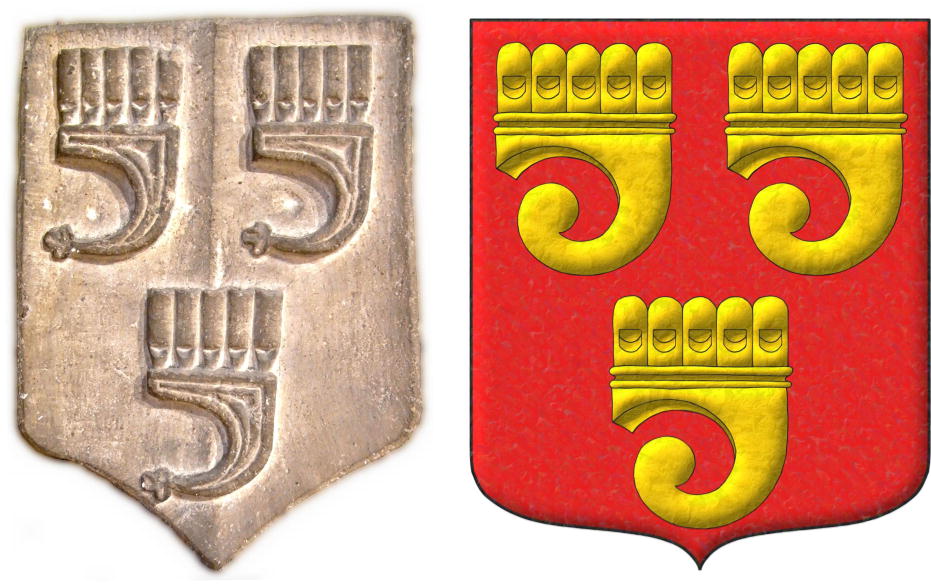Free hand


9 coats of arms in the ballroom, solution
Categories: Riddle solution, Ogee, Outlined in sable, Freehand, Or, Azure, Fleur de lis, One, Two, Three, Four, Five, Bend sinister, Cross, Fess and Saltire.


A liden behind the arms of the Strategy Department of Consultoria.IO
Azure, on waves of the sea in base Argent, a ship oars in action Or, pennant flying, and in full sail Argent; on a chief Argent, a closed book Gules, edges and clasps Or. Supporter behind the shield: A linden eradicated Sable, leaved Vert, fructed Or.
Coat of arms devised by me, illuminated with lights and shadows, with a pointed external shape and with a freehand finishing.
Blazon keywords: Azure, Argent, Or, Gules, Sable, Vert, One, Wavy, Sea, In base, On, Ship, Oar, Sail, Chief, Closed book, Book, Clasped, Supporter (thing), Supporter, Behind the shield, Linden, Eradicated, Leaved, Fructed, Motto and Scroll.
Style keywords: Illuminated, Pointed and Freehand.
Classification: Socioeconomic, Created, Boa, Coat of arms, Pennon and Flag.
Bearer: Strategy Department of Consultoria.IO.


Ackerson - Akers, lineage

Ackerson and Akers lineages.
Sable, a Bend between three Acorns Or.
Illuminated and freehand finishing.
The coat of arms of Ackerson and Akers lineages emblazoned by me and extracted from [Burke, B.; 1989].
Unless the blazon specifies another layout, when a bend is between three charges, this charges are ordered, two in the chief and one in the base, as the three acorns do in this case.
[Rietstap, J. B.; 1861] escribe el blasón de «Ackers ou Akers» como «de sable, à une bande d'or, acc. de trois glands du mesme».
Blazon keywords: Sable, Bend, Between, Three, Acorn, Or and Ordered.
Style keywords: Freehand, Outlined in sable and Illuminated.
Classification: Interpreted.


Ackhurst, lineage

Ackhurst lineage.
Argent, on a Bend Sable three Acorns Or.
Illuminated and freehand finishing.
The coat of arms of Ackhurst lineage emblazoned by me and extracted from [Burke, B.; 1989].
Unless the blazon specifies another direction, the charges in a bend follow the direction of their bend, as the acorns do in this case.
Blazon keywords: Argent, Bend, Sable, Three, Acorn, Or and Bendwise.
Style keywords: Freehand, Outlined in sable and Illuminated.
Classification: Interpreted.


Adrian V

186th Pope of the Church, only 40 days in 1276. «Hadrianus V», born Ottobuono de Fieschi, was born in Genoa.
Bendy of six Azure and Argent.
Escudo bandado de seis piezas de azur y plata.
Papal coat of arms interpreted by me with: a shield with a rounded arch top; the field in plain tincture of Argent; the bands illuminated in Azure and outlined in Sable; and the whole in an elevated line style.
The blazon in French is «Bandé d'azur et d'argent de six pièces».
The banding is defined in [Avilés, J.; 1725a; page 40] and [Avilés, J.; 1780a; page 45] as the shields and also, the chiefs, fesses, pales, and figures, such as animals, etc., that are «covered and filled with bands in equal number, with as many of metal as of color».
Blazon keywords: Without divisions, Bendy, Six, Azure and Argent.
Style keywords: Semi-circular, Illuminated, Outlined in sable and Freehand.
Classification: Interpreted, Religious and Papal States.
Bearer: Adrian V.


Ajay Gopal Valecha, structured and parallel blazons
Coat of arms of Ajay Gopal Valecha granted by the College of Arms, and emblazoned by me, with the blazon written in English and Castilian in a structured way to observe the parallelism between both forms.
| Quarterly Or and Argent, overall a peacock in his splendour proper. | Escudo cuartelado de oro y plata, sobre el todo un pavo real ruante al natural. |
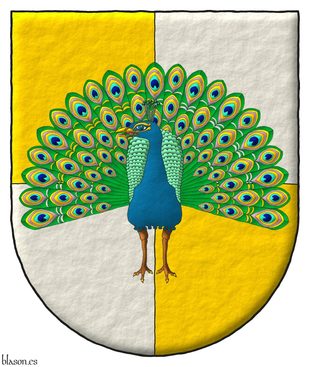 |
Blazon keywords: Argent, Or, One, Quarterly, Overall, Peacock, In his splendour and Proper.
Style keywords: Outlined in sable, Illuminated, Semi-circular and Freehand.
Classification: Personal, Interpreted, Structured and parallel blazons, Boa and Coat of arms.
Bearer: Valecha, Ajay Gopal.


Alarcon of Cantabria, lineage

Gules, a cross flory voided Or; within a bordure Gules with eight saltires couped Or.
Escudo de gules, una cruz hueca flordelisada de oro; bordura de gules, ocho sotueres de oro.
Coat of arms painted by me, highlighted with lights and shadows, outlined in Sable, with a semi-circular external shape and with a freehand finishing.
Ancient arms of Alarcon of Cantabria emblazoned by me.
Blazon keywords: Argent, Sable, Or, Gules, Three, Cross, Flory, Voided, Bordure, Saltire and Couped.
Style keywords: Outlined in sable, Illuminated, Semi-circular and Freehand.
Classification: Personal, Interpreted, Boa and Coat of arms.
Bearer: Alarcon of Cantabria, lineage.


Albero, lineage of Aragon
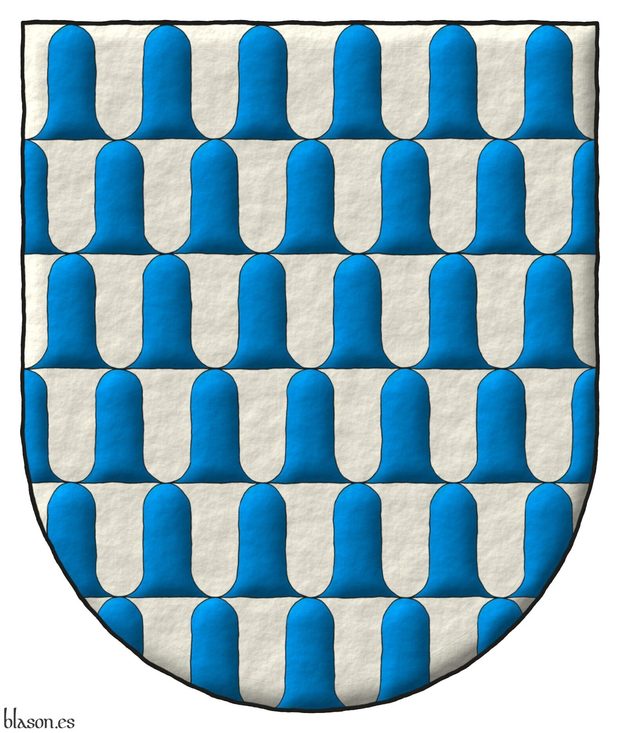
Blazon of the Albero lineage of Aragon.
Vair ancient.
Escudo de veros antiguos.
Illuminated and with a glass finish.
It can be consulted in [Cadenas y Vicent, V. de; 1987; page 62].
[Friar, S.; 1987; pages 157-158] says of the veros: «originates from the fur of a species of squirrel... which was popular in the Middle Ages as a lining for the garments of those not entitled to wear ermine. The animal was blue-grey on the back and white underneath. By sewing a number of these pelts together, with white and blue-grey alternating,... one which easily translated into the stylized armorial form of Vair and its variants».
Blazon keywords: Vair ancient.
Style keywords: Freehand, Outlined in sable, Illuminated and Semi-circular.
Classification: Interpreted, Lineage and Coat of arms.


Albrecht Dürer

Gules, on a trimount issuant from the base Or, a port Gules, with canopy roof, jambs, enarched lintel, and two open leaves, upon a three-step stairway Oro.
Escudo de gules, un monte de tres peñas moviente de la punta sumado de una puerta con tejadillo, jambas, dintel arqueado, dos hojas abiertas sostenida de una escalinata de tres peldaños todo de oro, aclarada de gules.
Coat of arms painted by me, illuminated with lights and shadows, outlined in Sable, with an ogee external shape and with a freehand finish.
Coat of arms of Albrecht Dürer, 1471-1528, emblazoned by me based on the woodcut titled «Coat of Arms of Albrecht Dürer» made by Albrecht Dürer himself in 1523 on a sheet measuring 35.1 × 26.1 cm belonging to The Elisha Whittelsey Collection, The Elisha Whittelsey Fund, 1952, held at the Metropolitan Museum of New York, and on the work titled «Marriage Coat of Arms of the Families Duerer and Holper. Verso of the Albrecht Dürer the Elder portrait», dated 1490; Albrecht Dürer the Elder, 1427–1502, was his father.
Design rationale
The Dürer family coat of arms is an example of canting arms. Their family origin traces back to Ajtós, Hungary, a name which means «door» or «doorman» in Hungarian. Upon settling in Nuremberg, the family Germanized their surname to «Türer», derived from «Tür», meaning «door», and later to Dürer. This is the reason of the main charge of these arms.
Blazon keywords: Gules, One, Two, Three, On, Trimount, Issuant from base, Port, Canopy roof, Arched, Enarched, Upon, Step, Stairway and Port and windows.
Style keywords: Outlined in sable, Illuminated, Ogee and Freehand.
Classification: Personal, Lineage, Interpreted, Boa and Coat of arms.
Bearer: Albrecht Dürer.


Alcantara, Cavalry Regiment

Coat of arms of the Armored Cavalry Regiment Alcantara No. 10, RCAC-10, in 2016.
Argent, a cross of Alcantara.
Escudo de plata, una cruz de Alcántara.
Coat of arms interpreted in the following manner: the shape of the shield is of a semicircular arch; the field is illuminated in the metal Argent; the cross of Alcantara is outlined in Sable and illuminated in Vert; and the whole has a raised stroke finish.
Blazon keywords: Without divisions, Argent, Cross of Alcantara, Cross couped and Cross.
Style keywords: Semi-circular, Illuminated, Outlined in sable and Freehand.
Classification: Interpreted, Military, Army and Navy and Coat of arms.
Bearer: Alcantara, Cavalry Regiment.


![Ver [Alcantara, Order of] en instituciones citadas. Fortaleza de oro y mazonada de sable.](../css/Fortaleza.Institucion.png)
Alcantara, Order of
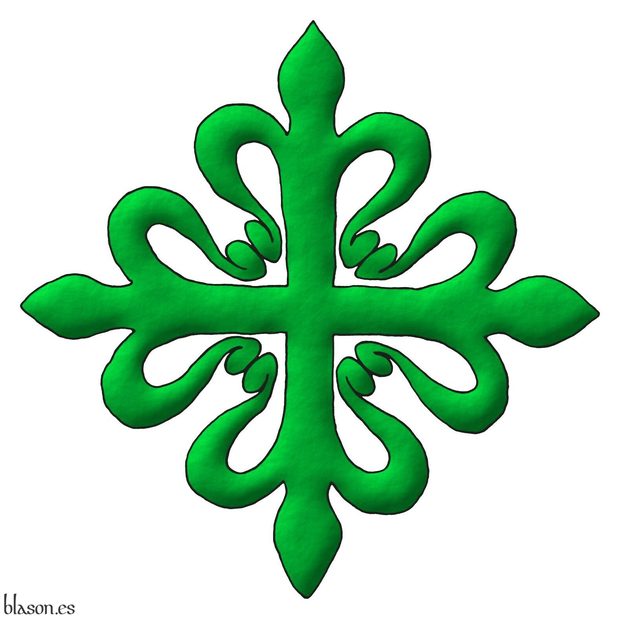
It was founded by Count Henry of Burgundy as a military and religious order, in the year 1093, in Beira Alta, Portugal, near the river Côa with the initial name of «Ordem de São Julião do Pereiro» ~ Order of Saint Julian of Pereiro.
In the year 1214, the defense of the city of Alcantara after its conquest was entrusted to the Order of Calatrava, but in 1218 the Calatravans relinquished it due to Alcantara being far from Calatrava.
To defend Alcantara, King Alfonso IX of León entrusted it to the new Order of the Knights of Saint Julian of Pereiro, requesting in return a certain level of dependency on the Order of Calatrava, which led the Knights of Saint Julian to adopt the Cistercian rule.
Once established in Alcantara, their original name referring to Saint Julian fell into disuse, and by 1253 there were already references to the «masters of the Order of Alcantara», with Saint Julian of Pereiro becoming the foundational center and a secondary commandery of the order.
On the origin and antiquity of the Military Order of Alcantara, and the form of its Commandery
[Avilés, J.; 1780b; treatise IV, chapter V, page 339] describes it as follows: «The Military Order, which we now call of Alcantara, was formerly that of Saint Julian of Pereiro, so named after the place where it was based, along the banks of the river Côa, in the Bishopric of Ciudad-Rodrigo, established in the year 1176 by King Ferdinand II of León, and confirmed in 1177 by Pope Alexander III. And the reason for changing its first name to the second, was because after the Knights of Calatrava had taken the City of Alcantara from the Moors and defended it bravely thereafter, they found it would be difficult to keep it, as their main house was very distant, from which the other Knights and reinforcements could not come whenever needed.».
[Avilés, J.; 1780b; treatise IV, chapter V, page 340] continues by telling us «They discussed this inconvenience with others they had at the time with the King of León, Don Alfonso IX, and it was resolved that the Master of Calatrava would give that town to the Knights of Pereiro so that they might defend it, as they did, under certain conditions in the year 1218, later performing marvels in its defense, earning through their fame and distinguished feats new graces from the Kings; and seeing how essential their residence was, the Knights of Pereiro moved to the town of Alcantara, establishing their Convent there, and thus transformed into Knights of Alcantara, who were previously Knights of Saint Julian of Pereiro».
Categories: Institution, Interpreted, Religious, Military, Illuminated, Outlined in sable, Freehand, Emblem, Cross of Alcantara, Cross couped and Cross.


Aldam, lineage of England

Blazon of the Aldam lineage of England.
Azure, a ray of the sun bendwise, issuant from the dexter chief Or.
Escudo de azur, un rayo de sol puesto en banda, naciente de la diestra del jefe de oro.
Illuminated with lights and shadows and with a freehand finish.
Described in [Burke, B.; 1989; page 9, column 1, entry 11].
Blazon keywords: Without divisions, Azure, One, Ray of the sun, Bendwise, Nascent, Dexter, Chief and Or.
Style keywords: Freehand, Outlined in sable, Illuminated and Semi-circular.
Classification: Interpreted, Lineage and Kingdom of England.


Alea Capital

Party per pale Sable and Or, two griffins' heads eraticted, and addorsed counterchanged.
Escudo partido de sable y oro, dos cabezas de grifo arrancadas y adosadas del uno en el otro.
Coat of arms emblazoned by me with a semi-circular shape, illuminated, and with a freehand finishing.
Blazon keywords: Party per pale, Sable, Or, Two, Head, Griffin, Erased, Addorsed and Counterchanged (side-by-side).
Style keywords: Outlined in sable, Semi-circular, Illuminated and Freehand.
Classification: Socioeconomic, Created and Coat of arms.
Bearer: Alea Capital.


Alpoim, lineage

Azure, a crescent reversed Argent, in dexter chief a fleur de lis Or, a bordure Gules.
Escudo de azur, un creciente ranversado de plata, en la diestra del jefe una flor de lis de oro, una bordura de gules.
Arms emblazoned by me, highlighted with lights and shadows, contoured in Sable, with an ogee external shape and with a freehand finishing.
Coat of arms of the lineage Alpoim. This coat of arms has been created for Fernando Durán Cabral de Mello d’Alpoim as a preparatory work for his armorial bearings where the arms of Alpoim are in the 2nd quarter.
Blazon keywords: Azure, Argent, Or, Gules, One, Crescent, Reversed, In the dexter chief, Fleur de lis and Bordure.
Style keywords: Outlined in sable, Illuminated, Ogee and Freehand.
Classification: Personal, Lineage, Interpreted, Boa and Coat of arms.
Bearer: Alpoim, lineage.


Amancier, lineage of Genevois

Blazon of the Amancier lineage of Genevois, Haute-Savoie, France.
Gules, three bars per pale Or and Azure.
Illuminated and a freehand finishing.
Its French blazon «de gueules, à trois fasces parties d'or et d'azur» can be found at [Rietstap, J. B.; 1861; page 40].
Any fess party per pale of metal and color or color and metal will always have a metal on metal or color on color conflict whether the field of the coat of arms is color or metal. There isn't conflict if the field of the coat of arms is also party per pale with metal under the color of the fess and with color under the metal of the fess or if the field is fur.
Blazon keywords: Without divisions, Gules, Three, Fess, Party per pale, Or and Azure.
Style keywords: Freehand, Outlined in sable, Illuminated and Semi-circular.
Classification: Interpreted, Lineage and Kingdom of France.


Anderson of Erbury

Argent, a chevron between three crosses flory Sable.
Escudo de plata, un cabrio acompañado de tres cruces flordelisadas todo de sable.
Illuminated with lights and shadows and with a freehand finish.
The coat of arms of Anderson of Erbury emblazoned by me in 4 ways: 1) tricking using abbreviations, 2) hatching using lines, 3) plain tinctures, and 4) lights and shados. It is a preliminary artwork for the arms of Nick Allen Rica II.
Blazon keywords: Without divisions, Argent, One, Chevron, Between, Three, Cross flory, Cross couped and Sable.
Style keywords: Freehand, Outlined in sable, Illuminated, Pointed, Tricking, Hatching and Plain tincture.
Classification: Interpreted, Kingdom of Scotland and Schema.
Bearer: Anderson of Erbury.


André de Montbard
Azure, two barbels addorsed Argent. Behind the shield an eight-pointed cross patty Gules.
Blazon keywords: Azure, Two, Barbel, Addorsed, Argent, Behind the shield, One, Eight-pointed cross, Cross couped and Gules.
Style keywords: Outlined in sable, Semi-circular, Illuminated and Freehand.
Classification: Religious, Military, Knights Templar, Interpreted and Coat of arms.
Bearer: Montbard, André de.


Andreou, Kimon

Party per fess: 1 Azure, a Athenian owl Argent, contourné, in chief; 2 Argent, an oak Azure, eradicated, in base; overall a saltire counterchanged.
Escudo cortado: 1o de azur, una lechuza al estilo ateniense, contornada de plata, en jefe; 2o de plata, un roble de azur, arrancado, en punta; brochante sobre el todo un sotuer del uno al otro.
Coat of arms interpreted with: its semicircular (round) base; the fields enameled in plain Azure and Argent; the saltire of traditional dimension, that is, 1/3 of the width of the shield; the figures outlined of the field and illuminated in Argent and Azure; and the ensemble with a raised-stroke finish.
A summary of the Blog Idtg de Kimon Andreou can be consulted within my section of recommended links. That summary is accompanied by another interpretation of Kimon's coat of arms, with the following differentiating characteristics:
- Interpretation outlined in Sable.
- It includes his motto «Ischys Dia Tis Gnoseos», written in Greek, which could be translated as «el poder del conocimiento».
- With his saltire reduced to 2/3 of its traditional width, which is 1/3 of the width of the shield. In this way, the saltire is 2/9 of the width of the shield. The objective of the reduction is to give more space to both his owl and his oak. This reduction does not convert it into the diminished piece called flanque, which has a 1/3 reduction over 1/3 of the shield's width, therefore, 1/9 of the shield's width.
Blazon keywords: Party per fess, Azure, Argent, Saltire, Overall, Counterchanged, Barn owl, Regardant, Tree, Oak and Erased.
Style keywords: Freehand, Illuminated and Outlined in the field tincture.
Classification: Interpreted, Personal, Coat of arms and Heraldry and heralds.
Bearer: Andreou, Kimon.


Andrew Ronald McMillan Bell of Auchinreoch with supporters
Gules, a cross Argent charged with four ermine spots in cross Sable, in the dexter of the chief a lion’s head erased Or. Crest: Upon a helm befitting his degree issuant from a crown of Baron above the shield, with a chapeau Gules turned up ermine, a demi-lion, double queued Or, grasping in its dexter paw a pennon Gules, bearing a canton Azure, charged with a saltire Argent. Mantling: Gules doubled Argent. War cry above the crest: «ΑΛΑΛΑ ΑΛΑΛΑ». Motto: «Mieux vaut s’user que rouiller». Supporters: Two knights in three-quarter armour affronty proper, each holding with his outer hand a spear Argent bearing a banner, the dexter Sable, a panther rampant guardant Argent, incensed Or, collared, pendent therefrom a bell Azure, the sinister a banner barry of six Or and Azure, a canton Ermine.
Arms emblazoned by me, illuminated with lights and shadows, contoured in Sable, with a pointed outer contour and with a freehand finish.
G0116, Chief Herald of Arms of Malta's grant for the arms of Andrew Ronald McMillan Bell of Auchinreoch, United Kingdom. These arms have been emblazoned by me for such grant.
Blazon keywords: Gules, Argent, Sable, Or, Azure, One, Four, Six, Cross, Charged, Ermine, In cross, Dexter, Chief, Lion, Head, Erased, Crest, Upon (wreath), Helm, Issuant, Crown of Baron, Crown, Above the shield, Chapeau, Demi, Double queued, Grasping, Canton, Saltire, War cry, Above the crest, Motto, Supporter (human form), Supporter, Knight, Affronty, Proper, Spear, Panther, Rampant, Guardant, Enflamed, Collar, Suspended, Bell and Barry.
Style keywords: Outlined in sable, Illuminated, Pointed and Freehand.
Classification: Personal, Interpreted, Boa, Coat of arms, Pennon, Flag and Banner of arms.
Bearer: McMillan Bell of Auchinreoch, Andrew Ronald.


Antonio Ruiz Porras, structured and parallel blazons
The coat of arms of Antonio Ruiz Porras emblazoned by me, with the blazon written in English and Castilian in a structured way to observe the parallelism between both forms.
Blazon keywords: Argent, Azure, Or, One, Quarterly, Dolphin, Haurient, Sunflower, Closed book, Book, Charged, Diamond and Lark.
Style keywords: Outlined in sable, Illuminated, Ogee and Freehand.
Classification: Personal, Interpreted, Structured and parallel blazons, Boa and Coat of arms.
Bearer: Ruiz Porras, Antonio.


Antrobus, Thomas
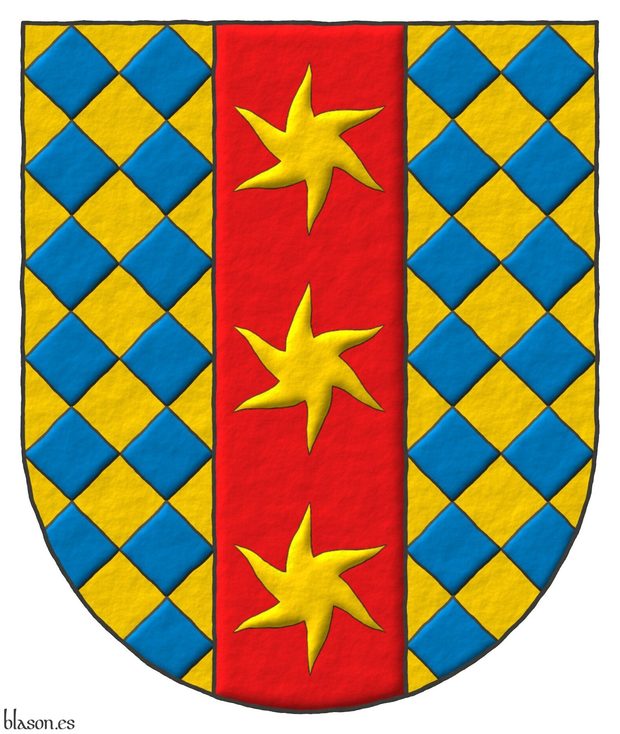
1525-1581.
Lozengy Or and Azure, on a pale Gules, three estoiles Or.
Escudo losanjado oro y azur, en un palo de gules, tres estrella ondadas de oro.
Coat of arms interpreted with: the semicircular base shape; the field of plain metal Or; the lozenges illuminated in Azure, outlined in Sable and with their 4 angles at 90o; the lozengy of proportion 5 x 6; the pale illuminated in Gules and outlined in Sable; the estoiles illuminated in Or and outlined in Sable; and the whole with a raised-stroke effect.
Blazon keywords: Lozengy, Or, Azure, Pale, Gules, Charged and Estoile.
Style keywords: Semi-circular, Illuminated, Outlined in sable and Freehand.
Classification: Interpreted and Personal.
Bearer: Antrobus, Thomas.


Araneta, lineage

Azure, a lion rampant Argent, in chief a mullet of four points Or; a bordure Gules charged with eight saltires couped Or.
Escudo de azur, un león rampante de plata, surmontado de un lucero de oro; una bordura de gules cargada de ocho sotueres de oro.
Coat of arms emblazoned by me, highlighted with lights and shadows, contoured in Sable, with a semi-circular outer contour and with a freehand finishing.
These are the ancient arms of the lineage Araneta emblazoned by me. They are from the Basque Country and there is a branch in the Philippines. This star is known as mullet of four points.
Blazon keywords: Azure, Argent, Or, Gules, One, Eight, Lion, Rampant, Mullet of four points, Bordure, Saltire and Couped.
Style keywords: Outlined in sable, Illuminated, Semi-circular and Freehand.
Classification: Personal, Lineage, Interpreted, Boa and Coat of arms.
Bearer: Araneta, lineage.


Argote de Molina, Gonzalo
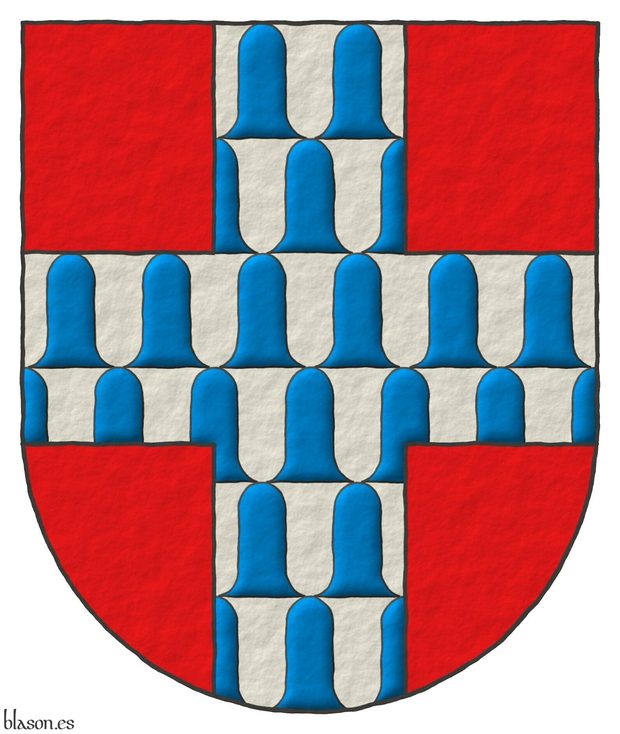
Gules, a cross vair ancient.
Escudo de gules, una cruz de veros antiguos.
Coat of arms that I have interpreted as follows: the shield has a semicircular (round) base; the field is in flat tincture of Gules; the ancient vair, rounded or of the old form, which are always Argent and Azure, are illuminated and outlined in Sable; and the whole of the hereditary coat of arms has a raised-stroke drawing.
Este escudo puede encontrarse en el libro del propio [Argote de Molina, G.; 1588; páginas 14 y 168], en la página 14 en grande, con cimera y rodeado de otros escudos de menor tamaño y en la página 168 de menor tamaño, con yelmo y lambrequines. En ambos casos el trazado de los veros es antiguo, redondeados, y en estas interpretaciones así los he reflejado.
Blazon keywords: Without divisions, Gules, Argent, Azure, Cross and Vair ancient.
Style keywords: Freehand, Illuminated and Outlined in sable.
Classification: Interpreted, Personal, Coat of arms and Heraldry and heralds.
Bearer: Argote de Molina, Gonzalo.


Argudo of Guipuzcoa, lineage

Argent, two wolves passant, in pale Sable, langued Gules; a bordure Azure charged with eight mullets Or.
Escudo de plata, dos lobos pasantes, en palo de sable, lampasados de gules; una bordura de azur cargada de ocho estrellas de oro.
Arms depicted by me, illuminated with lights and shadows, outlined in Sable, with a semi-circular outer contour and with a freehand finishing.
Ancient arms of the lineage Argudo of Guipuzcoa emblazoned by me. The lineage Ochoa of Vergara has a blazon equivalent to this one. Alternative blazon: «Argent, two wolves passant, in pale Sable, langued Gules; on a bordure Azure, eight mullets Or».
Blazon keywords: Argent, Sable, Gules, Azure, Or, One, Eight, Wolf, Passant, In pale, Bordure and Mullet.
Style keywords: Outlined in sable, Illuminated, Semi-circular and Freehand.
Classification: Personal, Lineage, Interpreted, Boa and Coat of arms.
Bearer: Argudo of Guipuzcoa, lineage.


Arrano Beltza
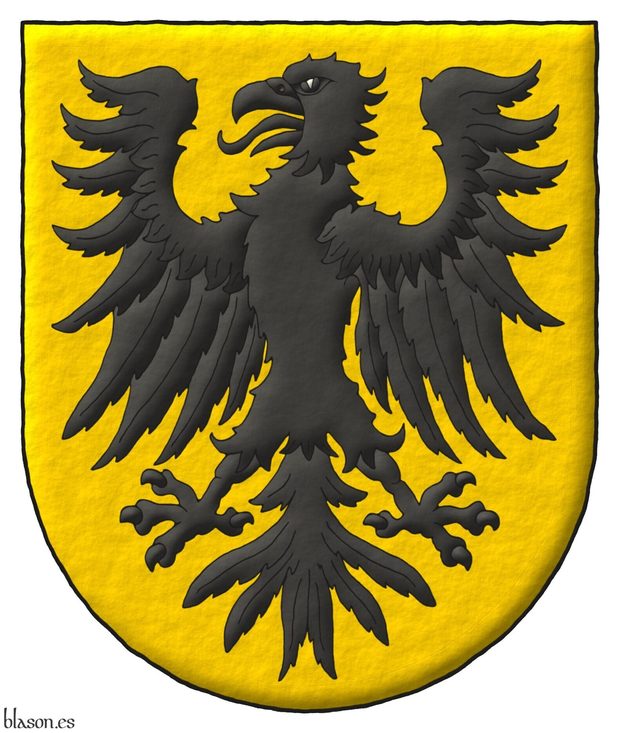
Or, a eagle displayed Sable.
Escudo de oro, un águila de sable.
Arms painted by me, illuminated with lights and shadows, contoured in Sable, and with a freehand finish.
Coat of arms of the Arrano Beltza, the black eagle in Basque, emblazoned by me.
Blazon keywords: Or, Sable, One, Eagle and Displayed.
Style keywords: Outlined in sable, Illuminated and Freehand.
Classification: Civic, Interpreted, Boa and Coat of arms.
Bearer: Arrano Beltza.


Arturo Taborda

Azure, issuant from base a frog's head and from flanks its forelegs in chevron Or, in chief a mullet of seven points Argent. Motto: «Clama a mí».
Escudo de azur, moviente de la punta una cabeza de rana y de los flancos sus patas delanteras en chevron todo de oro, en jefe una estrella de siete puntas de plata. Lema: «Clama a mí».
Coat of arms emblazoned by me, illuminated with lights and shadows, contoured in Sable, with an ogee outer contour and with a freehand finishing.
Coat of arms of Arturo Taborda, Venezuela, emblazoned by me. The motto came from Jeremiah 33:3 «Clama ad me, et exaudiam te, et annuntiabo tibi grandia et firma quæ nescis» ~ «Call to me, and I will answer you, and show you great and mighty things, which you do not know».
Blazon keywords: Azure, Or, Argent, One, Seven, Issuant from base, Frog, Head, Flank, Foreleg, In chevron, In chief, Mullet and Motto.
Style keywords: Outlined in sable, Illuminated, Ogee and Freehand.
Classification: Personal, Interpreted, Boa and Coat of arms.
Bearer: Taborda, Arturo.


Avelar, lineage of Portugal

Blazon of the Avelar lineage of Portugal.
Or, three bars Gules charged each one with three mullets of six points Argent.
Illuminated and a freehand finishing.
It can be found at [Cró, J. do; 1509; page 127].
Blazon keywords: Without divisions, Or, Three, Fess, Gules, Charged, Mullet and Argent.
Style keywords: Freehand, Outlined in sable, Illuminated and Semi-circular.
Classification: Interpreted, Lineage and Kingdom of Portugal.


Badge of Tomasz Arkadiusz Grzeszkowiak

A cross patty fitchy Or, piercing in base the head of a serpent nowed and facing sinister Sable, langued Gules.
Una cruz patada y fijada de oro, perforando la cabeza de una sierpe nudada y alterada de sable, lampasada de Gules
Blazon keywords: Cross patty fitchy, Cross couped, Piercing, Head, Serpent, Nowed, Facing sinister, Sable and Langued.
Style keywords: Freehand and Outlined in sable.
Classification: Interpreted, Personal and Badge.
Bearer: Grzeszkowiak, Tomasz Arkadiusz.


Baldovino from Venecia, lineage

Gules, an eagle displayed Or.
Escudo de gules, un águila de oro.
Coat of arms interpreted by me, illuminated with lights and shadows, outlined in Sable, with a semi-circular outer contour and with a freehand finish.
Blazon keywords: Gules, Or, One, Eagle and Displayed.
Style keywords: Outlined in sable, Illuminated, Semi-circular and Freehand.
Classification: Personal, Lineage, Interpreted, Boa and Coat of arms.
Bearer: Baldovino from Venecia, lineage.


Barras y división de la diagonal
Bendy sinister of seven.
Escudo, tres barras.
Blazon keywords: Without divisions and Bend sinister.
Style keywords: Ogee and Freehand.
Classification: Schema.


Barras, comparación de 2 métodos de delineación
Argent, three bendlets sinister Azure.
Escudo de plata, tres barras de azur.
Blazon keywords: Without divisions, Argent, Azure and Bend sinister.
Style keywords: Semi-circular, Ogee and Freehand.
Classification: Schema.
Bearer: Lauria, Roger de.


Bartholomew de Yattendon

Bartholomew de Yattendon ~ Bartholomeu de Loctringdene.
Gyronny Argent and Sable.
Jironado de plata y sable.
Included in [Vincent, MS; 1285; number 88] also known as [St. George's Roll; 1285; number 88].
Blazon keywords: Gyronny, Argent and Sable.
Style keywords: Pointed, Plain tincture, Outlined in sable and Freehand.
Classification: Interpreted and Personal.
Bearer: Bartolomé de Yattendon.


Beatrice of Swabia

Or, an eagle displayed Sable.
Escudo de oro, un águila de sable.
Coat of arms painted by me, highlighted with lights and shadows, outlined in Sable, with an ogee external shape and with a freehand finishing.
Coat of arms of the Queen Beatrice of Swabia, 1205–1235, baptized as Elisabeth, wife of King Ferdinand III of Castile, 1199–1252. The eagle Sable on an Or field is a distinctive symbol of the Holy Roman Empire. This coat of arms has been emblazoned by me.
Blazon keywords: Or, Sable, One and Eagle.
Style keywords: Outlined in sable, Illuminated, Ogee and Freehand.
Classification: Personal, Interpreted, Boa and Coat of arms.
Bearer: Beatrice of Swabia.


Benedict XII

197th Pope of the Church, from 1334 to 1342. «Benedictus XII», born Jacques Fournier, was born in Saverdun, in the south of Occitania.
Argent, a bordure Gules.
Escudo de plata, una bordura de gules.
Papal coat of arms interpreted with: a round-topped shield; the field in plain Argent; the bordure outlined in Sable and illuminated in Gules; and the whole design in raised outline.
Blazon keywords: Without divisions, Argent, One, Bordure and Gules.
Style keywords: Semi-circular, Illuminated, Outlined in sable and Freehand.
Classification: Interpreted, Religious and Papal States.
Bearer: Benedict XII.


Benedict XIV

247th Pope of the Church, from 1740 to 1758. «Benedictus XIV», named Prospero Lorenzo Lambertini, born in Bologna.
Or, three pallets Gules.
Escudo de oro, tres palos de gules.
Papal coat of arms interpreted with: a rounded mouth; the field in flat tincture of Or; the pales outlined in Sable and illuminated in Gules enamel; and the whole with a raised stroke finish.
Blazon keywords: Without divisions, Or, Three, Pale and Gules.
Style keywords: Semi-circular, Illuminated, Outlined in sable and Freehand.
Classification: Interpreted, Religious and Papal States.
Bearer: Benedict XIV.


Berenguela of Castile, Infanta
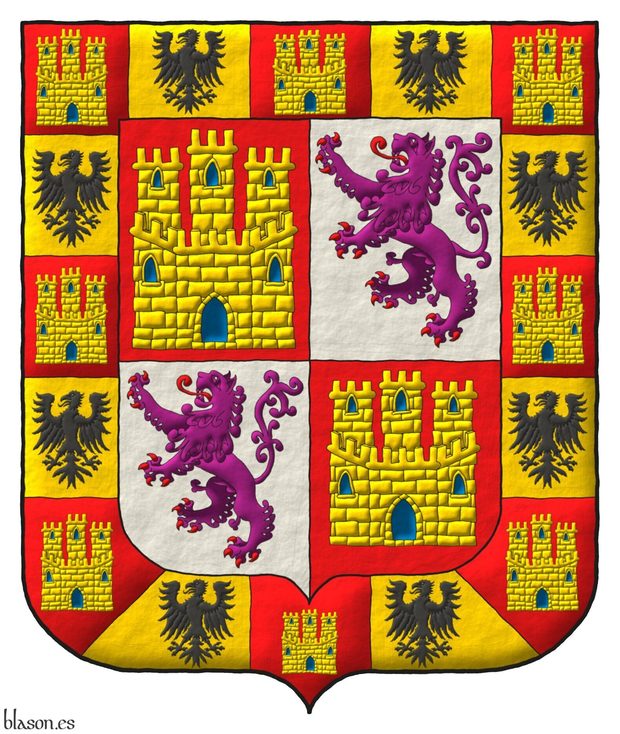
Quarterly: 1 and 4 Gules, a castle triple-towered Or, port and windows Azure, and masoned Sable; 2 and 3 Argent, a lion rampant Purpure, armed and langued Gules; a bordure compony of sixteen sections: eight Gules, a castle triple-towered Or, port and windows Azure, and masoned Sable, eight Or, an eagle displayed Sable.
Escudo cuartelado: 1o y 4o de gules, un castillo de oro, aclarado de azur, mazonado de sable; 2o y 3o de plata, un león rampante de púrpura, armado y lampasado de gules; una bordura componada de dieciseis compones: ocho de gules, un castillo de oro, aclarado de azur, mazonado de sable, ocho de oro, un águila de sable.
Coat of arms emblazoned by me, illuminated with lights and shadows, contoured in Sable, with an ogee outer contour and with a freehand finishing.
Coat of arms of the Infanta Berenguela of Castile, 1228–1279, 5th daughter of the King Ferdinand III of Castile, 1199-1252, and the Queen Beatrice of Swabia, 1205–1235. There are discrepancies regarding the year of her death, with sources suggesting either 1279 or 1288. She bore her father's arms with a bordure compony featuring the arms of Castile and those of her mother, from Swabia. [Menéndez Pidal de Navascués, F.; 1982; page 104 and illustration between pages 112 and 113] writes «We know of a seal of this infanta that displays in the field the royal quarterly, surrounded like a bordure by 4 castles and 4 eagles, alternating», and in the illustration he depicts the bordure with 8 castles and 8 eagles, which is the version I have interpreted. I am particularly fond of compony arms, and this one is, to me, among the most beautiful and quintessentially Castilian.
Blazon keywords: Gules, Or, Azure, Sable, Argent, Purpure, One, Sixteen, Eight, Quarterly, Castle, Triple-towered, Port and windows, Masoned, Lion, Rampant, Armed, Langued, Bordure, Compony and Eagle.
Style keywords: Outlined in sable, Illuminated, Ogee and Freehand.
Classification: Personal, Kingdom of Castile and Leon, Interpreted, Boa and Coat of arms.
Bearer: Berenguela of Castile, Infanta.


Berlin

Argent, a bear rampant Sable, langued and armed Gules.
Escudo de plata, un oso rampante de sable, lampasado y armado de Gules.
Arms interpreted by me, illuminated with lights and shadows, contoured in Sable, with a rounded trapezoidal outer contour and with a freehand finishing.
The coat of arms of the city of Berlin emblazoned by me.
Blazon keywords: Argent, Sable, Gules, One, Bear, Rampant, Langued and Armed.
Style keywords: Outlined in sable, Illuminated, Rounded trapezoid and Freehand.
Classification: Civic, Interpreted, Boa and Coat of arms.
Bearer: Berlin.


Berry of Molland

Berry of Molland, Devonshire.
Or, three fesses Gules.
Escudo de oro, tres fajas de gules.
It is possible that an English-speaking herald would have blazoned it as «Or, three bars Gules.» using the term «bars» instead of «fesses», just as in Castilian one sometimes uses the term «barras» instead of «palos», perhaps because these terms were not completely settled from the outset.
Blazon keywords: Without divisions, Or, Fess and Gules.
Style keywords: Pointed, Illuminated, Outlined in sable and Freehand.
Classification: Interpreted and Personal.
Bearer: Berry of Molland.
Blazon equivalent to: Clement V.


Berry, Austin Charles

Vert, a chevron, between three cross-crosslets; on a chief Argent, three griffins statant Gules, beaked and armed Or.
Escudo de sinople, un cabrio, acompañado de tres cruces recrucetadas; un jefe todo de plata, tres grifos parados de gules, picados y armados de oro.
Coat of arms emblazoned by me with a pointed shape, illuminated, and with a freehand finishing.
Blazon keywords: Vert, One, Chevron, Between, Three, Cross-crosslet, Cross couped, Chief, Argent, Griffin, Statant, Gules, Beaked, Armed and Or.
Style keywords: Pointed, Outlined in sable, Illuminated and Freehand.
Classification: Personal, Interpreted and Coat of arms.
Bearer: Berry, Austin Charles.


Boteler of Warrington

Azure, a bend between six covered cups Or.
Escudo de azur, una banda acompañada de seis copas todo de oro.
Illuminated with lights and shadows and with a freehand finish.
Around 1155, Beatrix de Villers married Richard le Boteler Pincerna, who became the 4th Baron of Warrington. The heir of Beatrix and Richard took the surname «le Boteler» and ruled the Warrington region, bearing arms Azure, a bend between six covered cups Or.
In Castilian, a «copa» has a lid and is referred to as a «covered cup» in English. When it doesn't have a lid, it's called a «cup» in English and a «cáliz» or «copón» in Castilian, the latter being a less preferred term for me. In English, the term «chalice» is also used, especially if it's adorned with gemstones, although that's more of an artistic license.
Naipes Heraclio Fournier is a renowned Spanish playing card manufacturer based in Villareal de Álava. The countless hours I have spent holding its cards in my hands are incalculable, whether playing with friends, opponents, or performing magic tricks. Its influence on my heraldic artwork is significant. For instance, in this covered cup.
The following image shows my covered cup and my two interpretations of his arms: 1) the most commonly viewed, and 2) my alternative layout.
Blazon keywords: Without divisions, Azure, One, Bend, Between, Six, Covered cup and Or.
Style keywords: Freehand, Outlined in sable, Illuminated and Semi-circular.
Classification: Interpreted and Kingdom of England.
Bearer: Boteler of Warrington.


Boyd of Scotland, lineage

Azure, a fess chequey Gules and Argent.
Escudo de azur, una faja ajedrezada de gules y plata.
Coat of arms interpreted by me, highlighted with lights and shadows, contoured in Sable, with a semi-circular external shape and with a freehand finishing.
Coat of arms of the lineage Boyd of Scotland. I have emblazoned it with a fess chequy of 3 rows, symmetric and with 9 columns of squares, provided that its height is 1/3 of the width of the coat of arms.
Blazon keywords: Azure, Gules, Argent, One, Three, Nine, Fess and Chequey.
Style keywords: Outlined in sable, Illuminated, Semi-circular and Freehand.
Classification: Personal, Lineage, Interpreted, Boa and Coat of arms.
Bearer: Boyd of Scotland, lineage.


BPAC II, su cálculo de las barras

My approach to the method of drawing the bends used by the Spanish Army for the BPAC II coat of arms
Bendy sinister of seven.
Escudo, tres barras.
Note that if the classic width were used for the bends, which is 1/3 of the shield's width, then the bends would cover almost the entire field.
The vertical axis of symmetry has been extended above the chief and below the base, and has been divided into segments of 1/4 of the shield's height, «h» in the diagram that illustrates this article. At the ends of these segments, parallel lines have been drawn to the bend sinister diagonal of the shield. Since the shield has a 5x6 proportion, the angle of inclination of these diagonals is 50.2o..
Blazon keywords: Without divisions and Bend sinister.
Style keywords: Semi-circular and Freehand.
Classification: Schema and Military.
Bearer: BPAC II.


Burr, lineage

Or, on a pile issuant from the base Gules a sword point upwards Argent.
Escudo de oro, una pira de gules cargada de una espada alzada de plata.
Arms emblazoned by me, highlighted with lights and shadows, outlined in Sable, with a semi-circular outer contour and with a freehand finishing.
Coat of arms of the lineage Burr emblazoned by me based on the description by [Cadenas y Vicent, V. de; 1987; page 388].
Blazon keywords: Or, Gules, Argent, One, Pile issuant from base, Charged, Sword and Point upwards.
Style keywords: Outlined in sable, Illuminated, Semi-circular and Freehand.
Classification: Personal, Lineage, Interpreted, Boa and Coat of arms.
Bearer: Burr, lineage.


Cabral, lineage

Argent, two goats in pale Purpure, horned Sable.
Escudo de plata, dos cabras en palo de púrpura, acornadas de sable.
Coat of arms depicted by me, highlighted with lights and shadows, contoured in Sable, with an ogee outer contour and with a freehand finishing.
Coat of arms of the lineage Cabral. This coat of arms has been created for Fernando Durán Cabral de Mello d’Alpoim as a preparatory work for his armorial bearings where the arms of Cabral are in the 3rd quarter.
Blazon keywords: Argent, Purpure, Sable, Two, Goat, In pale and Horned.
Style keywords: Outlined in sable, Illuminated, Ogee and Freehand.
Classification: Personal, Lineage, Interpreted, Boa and Coat of arms.
Bearer: Cabral, lineage.


![Ver [Calatrava, Order of] en instituciones citadas. Fortaleza de oro y mazonada de sable.](../css/Fortaleza.Institucion.png)
Calatrava, Order of

The Order of Chivalry of Calatrava is both military and religious, founded in the Kingdom of Castile during the 12th century by Abbot Raymond of Fitero.
The purpose of its foundation was the protection of the town of Calatrava la Vieja, which currently belongs to the municipality of Carrión de Calatrava in Ciudad Real. At the time of the order's foundation, it was an important city, in the middle valley of the river Guadiana and with a strategic position, as it was a necessary passage on the road from Toledo to Córdoba to Toledo and between the west and east of the Iberian Peninsula.
On the origin and antiquity of the Military Order of Calatrava, and the form of its Commandery
[Avilés, J.; 1780b; treatise IV, chapter IV, pages 334] writes «The Military Order of Calatrava was instituted by Don Sancho III, King of Castile (called the Desired), in the year 1158, while he was visiting his Kingdom; and being in Toledo with news of the great army that the Moors were gathering to besiege Calatrava la Vieja (which is called so today to distinguish it from the new one, which was founded later); and as the Templars, to whom this Fortress belonged, did not have sufficient power to resist such a large multitude, they handed it over to King Don Sancho himself so that he could take charge of it, as he did».
[Avilés, J.; 1780b; treatise IV, chapter IV, page 335] continues by telling us «The Abbot of Santa María de Fitero», near the river Pisuerga as he will indicate next, «of the Congregation of Cistercian, in the Bishopric of Palencia (which is a Monastery of St. Bernard, located on the river Pisuerga), named Don Raymond, and Friar Diego Velazquez, his subject Monk, who followed the Court, despite the difficulty of the enterprise, requested it from the King to defend it, which was granted, trusting in the virtue of the Abbot, and the strength of the Monk, who had previously been a great Knight in deeds of Arms, and very practiced in war».
[Avilés, J.; 1780b; treatise IV, chapter IV, page 336] continues «Seeing themselves in such an obligation, and that by themselves they could not fulfill it, they turned to Archbishop Don Juan (who was the fourth of Toledo) for help; and he, granting many indulgences in all his Archbishopric to those who, for themselves and for others, supplied the Place with provisions, in the same way as those who, unable to go due to old age or illness, helped with weapons, horses, and men; and having spread this news, so much help came to them, that when the Moors learned that the number of people exceeded twenty thousand men, they abandoned the conquest, returning to their homes: for this reason, the King ceded the Town of Calatrava to the Abbot of Fitero, and his successors, to defend it from the Moors from then on, confirmed later by King Alfonso IX, his son».
[Avilés, J.; 1780b; treatise IV, chapter IV, page 337] concludes «Having obtained this grace, Abbot Don Raymond brought the most suitable Monks from Fitero to Calatrava, and everything else that was necessary for living and for the defense of the Town and its land, which with the people inclined to war who remained, formed the Order of Chivalry of Calatrava, taking this name from the place where the institution was made, which in Arabic Calatrava means Castle».
Categories: Institution, Interpreted, Religious, Military, Illuminated, Outlined in sable, Freehand, Emblem, Cross of Calatrava, Cross couped and Cross.


Carlos Vidriales, crest, cross and badge of commander
Blazon keywords: Party per pale, Argent, Cross, Sable, Bordure, Motto, Or, Thirteen, Hurt, Hurt, torteau, pellet, pomme and golpe, Azure, Three, In pale, Four, Five, Chief, Fleur de lis, Crest and mantling, Helm, Mantling, Dexter, Doubled, Sinister, Wreath, One, Arm, Armed, Nascent, Grasping, Sword, Between, Two, Wing, Conjoined in fess, Decoration, Suspended and Base (lower 1/3).
Style keywords: Freehand, Semi-circular, Illuminated and Outlined in sable.
Classification: Coat of arms, Interpreted and Personal.
Bearer: Vidriales García y Bustamante, Carlos.


Carmen Giaimo di Prizzi, crown of baroness and motto

Party per pale: 1 Vert, a Castle triple-towered Argent; 2 Gules, two bezants in pale Or. For crest a crown of baroness. Lema: «In Fide et Devotione».
I have interpreted this coat of arms with a semi-circular shape; metals or, argent, colors vert and gules; outlined with sable; and a freehand finish.
Blazon keywords: Party per pale, Vert, One, Castle, Argent, Gules, Two, Bezant and plate, Bezant, In pale, Crown and Motto.
Style keywords: Semi-circular, Freehand and Outlined in sable.
Classification: Interpreted, Personal and Coat of arms.
Bearer: Giaimo di Prizzi, Carmen.


Castilian castle
A Castle Or, triple towered, embattled, port and windows Azure, and masoned Sable.
Un castillo de oro, aclarado de azur, mazonado de sable.
Some of the characteristics of the Castilian castle are specified in the coat of arms in English, for example, «triple towered, embattled», but they are omitted in the Spanish blason, because the Spanish blason considered that the Castilian castle can not be otherwise. These local characteristics, that decades ago were not necessary to specify, could begin to have to be in this global and interconnected heraldic world. [Valero de Bernabé, L.; 2009a] describe the different characteristics between the Castilian, the French, and the English castles among others.
Blazon keywords: Castle, Or, Port and windows, Azure, Masoned and Sable.
Style keywords: Freehand.
Classification: Schema.


Ceballos of Cantabria, lineage

Argent, three bars Sable; within a bordure countercompony Or and Gules. 2 versions for the same blazon.
Escudo de plata, tres fajas de sable; bordura ajedrezada de oro y gules. 2 versiones para el mismo blasón.
Arms depicted by me, illuminated with lights and shadows, contoured in Sable, with a semi-circular external shape and with a freehand finishing.
Ancient arms of the lineage Ceballos of Cantabria emblazoned by me.
Blazon keywords: Argent, Sable, Or, Gules, Three, Bar, Bordure and Chequey.
Style keywords: Outlined in sable, Illuminated, Semi-circular and Freehand.
Classification: Personal, Interpreted, Boa and Coat of arms.
Bearer: Ceballos of Cantabria, lineage.


![Ver [Centro, Val’Quirico, Tlaxcala, Mexico in Twelve Lineages] en enlaces recomendados. Áncora de oro y la divisa enlace.](../css/Ancora.Enlace.png)
Centro, Val’Quirico, Tlaxcala, Mexico in Twelve Lineages
Publication of my heraldic artwork on the blog Twelve Lineages of Soria under the following headline: Coat of arms for the residential town of Centro de Val’Quirico, State of Tlaxcala, Mexico, work by Dr. Antonio Salmerón Cabañas.
Categories: Link, Civic, United Mexican States, Freehand, Or, Sable, Gules, Argent, Mural crown, Crown, Party per bend, Panther and Rampant.
Root: Twelve Lineages of Soria.


Cerda, Carlos de la

Known in England and France as Charles of Spain ~ Charles d'Espagne.
Quarterly: 1 Azure semé of fleurs de lis Or; 2 and 3 Gules, a castle triple towered Or, the port and windows Azure, masoned Sable; 4 Argent, a lion rampant Purpure, armed and langued Gules, crowned Or.
Coat of arms of Charles de la Cerda (1326-1354), this coat of arms also could be blazoned as «Quarterly: 1, Francia; 2 and 3, Castile; 4, Leon.».
Blazon keywords: Quarterly, Azure, Semé, Fleur de lis, Or, Gules, Castle, Port and windows, Masoned, Sable, Argent, Lion, Purpure, Rampant, Armed, Langued, Crown and Crowned.
Style keywords: Semi-circular, Illuminated, Outlined in sable and Freehand.
Classification: Interpreted, Personal, Army and Navy and Kingdom of France.
Bearer: Cerda, Carlos de la.


Clement XII

246th Pope of the Church, from 1730 to 1740. «Clemens XII», named Lorenzo Corsini, born in Florence and rests in St. John Lateran.
Bendy of six Gules and Argent; over all a fess Azure.
Escudo bandado de seis piezas de gules y plata; brochante sobre el todo una faja de azur.
Papal coat of arms interpreted with: a rounded mouth; the field in flat tincture of Argent; the fess and the bands outlined in Sable and illuminated in Gules and Azure; and the whole with a textured finish.
All are ordinaries, including the three bands and the fess, and since the blazon specifies that the fess is overall on the bands, therefore, it is not the Gules bands that are overall on the Azure fess, and they should be painted underneath.
Blazon keywords: Without divisions, Bendy, Six, Gules, Argent, Surmounted, Overall (deprecated), One, Fess and Azure.
Style keywords: Semi-circular, Illuminated, Outlined in sable and Freehand.
Classification: Interpreted, Religious and Papal States.
Bearer: Clement XII.


Clermont, Robert of

Grandson of Blanche of Castile, 6th son of Saint Louis IX, founder of the House of Bourbon, husband of Beatrice of Burgundy, Lady of Bourbon.
Azure semé of fleurs de lis Or, a bend Gules.
Escudo de Azur sembrado de flores de lis de oro, banda gules.
Coat of arms that I have interpreted with:: a semicircular (round) base; the field enamelled in flat Azure; the fleurs-de-lys illuminated in Or; the bend illuminated in Gules; the whole is outlined in Sable; and the freehand drawing.
Blazon keywords: Without divisions, Azure, Or, Semé, Fleur de lis, Bend and Gules.
Style keywords: Semi-circular, Illuminated, Outlined in sable and Freehand.
Classification: Interpreted, Personal, Coat of arms, Kingdom of France and House of Bourbon.
Bearer: Clermont, Robert of.

Colebrand, William de
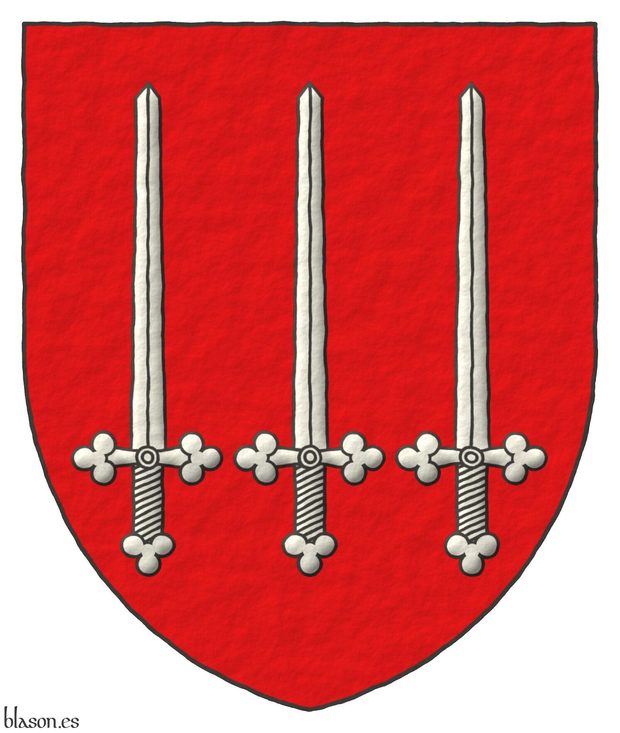
Willame de Colebraund ~ William de Colebrand.
Gules, three Swords Argent, erect, in fess.
Escudo de gules, tres espadas de plata, alzadas, en faja.
Interpreted coat of arms with a free hand finish.
Coat of arms included in [Marshal, L.; 1295; coat of arms number 461], also in [Brault, G. J.; 1997], and time ago in Brian Timms, but not now.
Blazon keywords: Without divisions, Gules, Three, Sword, Argent, Point upwards and In fess.
Style keywords: Pointed, Illuminated, Outlined in sable and Freehand.
Classification: Interpreted and Personal.
Bearer: Colebrand, William de.


Coulot, Fabian

Or, two mullets of six points pierced in fess Gules; in chief a sabre fesswise Sable.
Escudo de oro, dos rosetas de espuela en faja de gules; en jefe, un sable puesto en faja de sable.
Coat of arms emblazoned by me with a semi-circular shape, illuminated, and with a freehand finishing.
Blazon keywords: Or, Two, Mullet of six points pierced, In fess, Gules, In chief, One, Sabre, Sword, Fesswise and Sable.
Style keywords: Outlined in sable, Semi-circular, Illuminated and Freehand.
Classification: Personal, Interpreted and Coat of arms.
Bearer: Coulot, Fabian.


Crest and mantling of Ignacio Pérez de Bartolome
Gules, a lion rampant Or, charged with a pallet gemel chequey Argent and Sable. Crest: Upon a helm with a wreath Or and Gules, a demi-dragon Or, supporting with its sinister a goldfinch speaking proper. Mantling: Gules doubled Or.
Coat of arms designed by me, illuminated with lights and shadows, contoured in Sable, with an ogee external shape and with a freehand finish.
Blazon keywords: Gules, Or, Argent, Sable, One, Lion, Rampant, Charged, Pallet, Gemel, Chequey, Crest and mantling, Crest, Upon (wreath), Helm, Wreath, Demi, Dragon, Perched, Sinister, Goldfinch, Speaking, Proper, Mantling and Motto.
Style keywords: Outlined in sable, Illuminated, Ogee and Freehand.
Classification: Personal, Created, Boa and Coat of arms.
Bearer: Pérez de Bartolome, Ignacio.


Crest and mantling of the Marquis Prato di Arnesano
Or, three pallets Vair. Crest: Upon helm affronty Argent, barred Or, lined Gules, with a wreath Argent, Or and Azur, a crown of Marquis. Mantling: Dexter Azure doubled Or, sinister Azure doubled Argent.
Arms painted by me, highlighted with lights and shadows, contoured in Sable, with an ogee outer contour and with a freehand finishing.
The coat of arms of the Marquis Prato di Arnesano, requested by Andrea Tamburelli Lanzara and painted by me. That the base of the bevor is fimbriated Or is a detail I do not blazon, as I regard it purely as an artistic feature.
Blazon keywords: Or, Three, Pale, Vair, Crest, Upon (wreath), Helm, Affronty, Barred, Lined, Wreath, Crown of Marquis and Crown.
Style keywords: Outlined in sable, Illuminated, Ogee and Freehand.
Classification: Personal, Interpreted, Boa and Coat of arms.
Bearer: Prato di Arnesano, Marquis.


Crest of Alena Rehberger
Or, a roe deer springing Gules, in base a triple mount Vert. Crest: Upon a helm affronty, with a wreath Or and Vert, two roe deers' attires barry of four Gules and Or. Mantling: Vert doubled Or..
Credits:
- Stephan Urs Breu is the designer of the coat of arms.
- Antonio Salmerón y Cabañas is the author of the heraldic art.
Blazon keywords: Or, One, Roe deer, Springing, Gules, In base, Trimount, Vert, Crest and mantling, Helm, Mantling, Wreath, Crest, Two, Roe deers' attires, Barry and Four.
Style keywords: Outlined in sable, Semi-circular, Illuminated and Freehand.
Classification: Personal, Interpreted and Coat of arms.
Bearer: Rehberger, Alena.


Crest of Fernando Marán Bié with its pegasus

Party per fess: 1 Azure, an open book Argent, garnished Or, charged with a mullet Azure; 2 Gules, a tree eradicated between two apples Or; within a bordure embattled Or. Crest: Upon wreath Or, Azure and Gules, a demi-pegasus Argent issuant from flames of fire Gules, fimbriated Or.
Coat of arms depicted by me, highlighted with lights and shadows, contoured in Sable, with a semi-circular outer contour and with a freehand finishing.
Blazon keywords: Azure, Gules, Argent, Or, Six, One, Two, Party per fess, Open, Book, Garnished, Charged, Mullet, Tree, Eradicated, Between, Apple, Bordure, Embattled, Crest, Upon (wreath), Wreath, Demi, Pegasus, Issuant, Flame and Fimbriated.
Style keywords: Outlined in sable, Illuminated, Semi-circular and Freehand.
Classification: Personal, Interpreted, Boa and Coat of arms.
Bearer: Fernando Marán Bié.


Crest of Guy Harold Power
Argent, two arrows points upwards in saltire Sable, barbed and feathered Gules, surmounted of a commando dagger point upwards in pale Gules, hilted and pommelled Sable; on a chief indented Sable, a label of three points Or. Crest: Upon a helm with a wreath Argent and Sable, a demi-man proper, wearing a beret Vert, grasping in his dexter hand a commando dagger point upwards Or, hilted and pommelled Sable. Mantling: Sable doubled Argent.
Blazon keywords: Argent, Two, Arrow, Point upwards, In saltire, Sable, Barbed, Feathered, Gules, Surmounted, One, Dagger, In pale, Hilted, Pommelled, Chief, Indented, Label of three points, Or, Crest and mantling, Helm, Mantling, Wreath, Crest, Male figure, Demi, Proper, Beret, Vert, Grasping, Hand and Dexter.
Style keywords: Pointed, Outlined in sable, Illuminated and Freehand.
Classification: Personal, Interpreted and Coat of arms.
Bearer: Power, Guy Harold.


Crest of Rick Kasparek
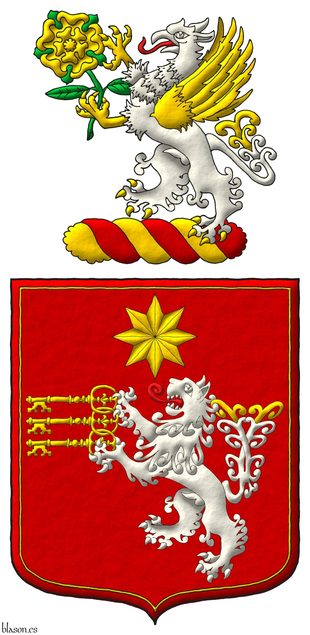
Sanguine, a lion rampant, double queued Argent, tufted Or and langued Gules holding in its paws by the bows three keys fesswise bows interlaced wards to dexter facing downwards Or, in chief a mullet of eight points Or; all within a tressure Or. Crest: Upon a wreath Argent and Gules, a griffin segreant Argent langued Gules, beaked, armed, winged and tufted Or, supporting in its talons a rose Or, slipped and leaved proper.
Coat of arms depicted by me, illuminated with lights and shadows, outlined in Sable, with an ogee outer contour and with a freehand finishing.
Crest and coat of arms of Rick Kasparek emblazoned by me.
Blazon keywords: Sanguine, Argent, Or, Gules, One, Three, Eight, Lion, Rampant, Double queued, Tufted, Langued, Grasping, Paw, Key, Fesswise, Interlaced, In chief, Mullet, Tressure, Crest, Upon (wreath), Wreath, Griffin, Segreant, Beaked, Armed, Winged, Talon, Rose, Slipped, Leaved and Proper.
Style keywords: Outlined in sable, Illuminated, Ogee and Freehand.
Classification: Personal, Interpreted, Boa and Coat of arms.
Bearer: Kasparek, Rick.


Crest, mantling and motto of Dr. Jacques William Normand Delfin
Azure, on three bars wavy Argent, a Norman ship Or, full sail Argent; on a chief Gules, two leopards Or, armed and langued Azure; a bordure Argent charged with eight acorns bendwise Azure. Crest: Upon a helm with a wreath Or and Azure, a cross of Lorraine patty Or. Mantling: Azure doubled Or. Motto: «Marche dans ta voie avec Dieu».
Coat of arms devised by me, highlighted with lights and shadows, outlined in Sable, with an ogee outer contour and with a freehand finishing.
Coat of arms of Dr. Jacques William Normand Delfin. He is from Mexico and his family comes from Falaise in Normandy. This coat of arms has been created by him and me, and emblazoned by me.
Design rationale
The leopards symbolize the family’s origin in Falaise, Normandy, as well as the nobility of heart to help those in need; their raised claw represents the ardor in striving to accomplish the proposed undertakings; their gaze forward stands for sincerity and honesty in daily actions; their walking in pair conveys the enduring unity of the family; and the gold of their skin reflects the purity of the soul, mirrored along the path of life. The Norman drakkar sailing westward symbolizes both the family’s journey to America in search of a new horizon and the quest for knowledge in science, technology, cosmology, theology, and the Universe itself. The oak acorns represent the Breton branch of the family and embody strength, perseverance, chivalry, kindness, loyalty, sacrifice, and faith. The motto proclaims that God may be our Master, Companion, and Guide, the Light along the path, and the Shield against adversity in life’s journey. The Cross of Lorraine honors Saint Joan of Arc, who bore it upon her standard.
Blazon keywords: Azure, Argent, Or, Gules, One, Two, Eight, In base, On, Wavy, Bar, Norman ship, Full sail, Chief, Leopard, Armed, Langued, Bordure, Acorn, Bendwise, Upon (wreath), Helm, Wreath, Cross of Lorraine, Patriarchal cross, Cross couped, Patty, Mantling, Doubled and Motto.
Style keywords: Outlined in sable, Illuminated, Ogee and Freehand.
Classification: Personal, Created, Design rationale, Boa, Coat of arms and Flag.
Bearer: Normand Delfin, Jacques William.


Cross potent, cross moline, and cross of Jerusalem, comparison
A Gules and Or comparison between cross potent, cross moline, and cross of Jerusalem
Blazon keywords: Gules, Or, Cross potent, Cross couped, Cross moline, Cross of Jerusalem and Cross.
Style keywords: Freehand, Outlined in sable and Illuminated.
Classification: Schema.


Crown of Amitay Edward von Stiebel

Quarterly: 1 Or, a lion rampant, facing sinister Sable, armed and langued Gules; 2 and 3 Gules, an anchor proper; 4 Or, a lion rampant Sable, armed and langued Gules; overall, a pile issuant from base Azure charged with a mount proper issuant from water issuant from base Argent, in chief, a mullet of six points Or. Crest: A crown of untitled nobility.
Arms emblazoned by me, highlighted with lights and shadows, contoured in Sable, and with a freehand finishing.
Blazon keywords: Or, Sable, Gules, Azure, Argent, One, Six, Quarterly, Lion, Rampant, Facing sinister, Armed, Langued, Anchor, Proper, Overall, Pile issuant from base, Charged, Mount, Issuant, Water, Issuant from base, In chief, Mullet, Crest, Crown of Noble and Crown.
Style keywords: Outlined in sable, Illuminated, Bull's hide and Freehand.
Classification: Personal, Interpreted, Boa and Coat of arms.
Bearer: Stiebel, Amitay Edward von.


Crown of Castilla-La Mancha
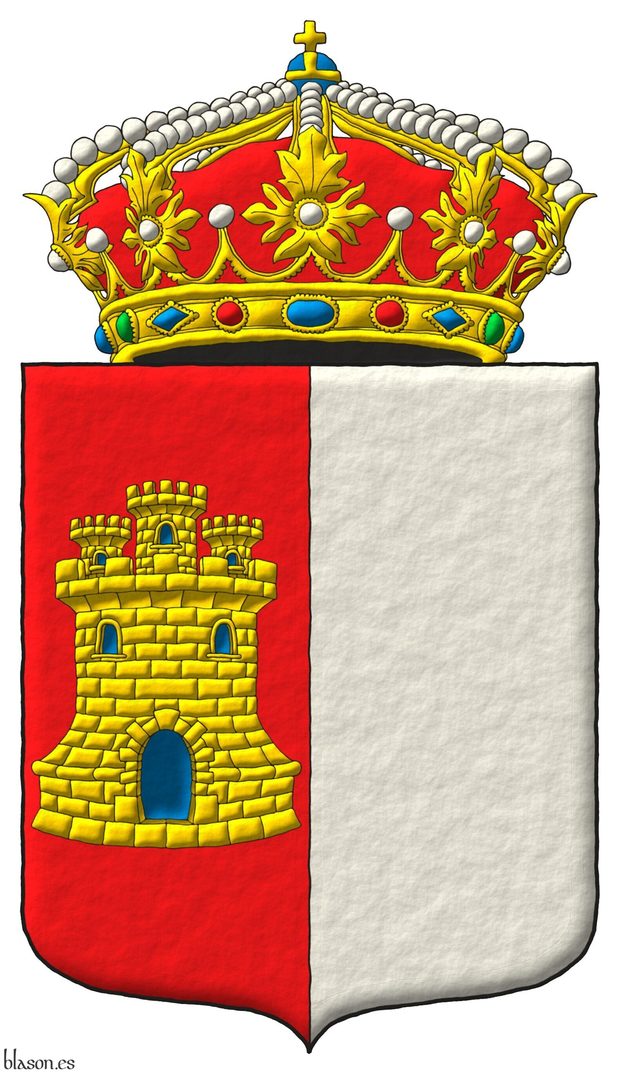
Party per pale: 1 Gules, a castle triple-towered Or, port and windows Azure, masoned Sable; 2 Argent. Crest: A closed royal crown Or.
Coat of arms emblazoned by me, highlighted with lights and shadows, contoured in Sable, with an ogee external shape and with a freehand finishing.
Design rationale
The coat of arms of Castilla-La Mancha was adopted in 1983, it is a recent design. This coat of arms is equal to the flag of Castilla-La Mancha officially approved in 1980 and designed by Ramón José Maldonado y Cocat. The 1st quarter represents Castilla and the 2nd quarter the great plane of La Mancha.
Blazon keywords: Gules, Argent, Or, Azure, Sable, One, Party per pale, Castle, Triple-towered, Port and windows, Masoned, Crest, Closed royal crown and Crown.
Style keywords: Outlined in sable, Illuminated, Ogee and Freehand.
Classification: Civic, Interpreted, Design rationale, Boa and Coat of arms.
Bearer: Castilla-La Mancha.


Crown of Gozo

Argent, upon a base barry wavy of six Argent and Sable, a trimount Sable. Crest: A mural crown Or.
Arms emblazoned by me, highlighted with lights and shadows, contoured in Sable, and with a freehand finish.
Blazon keywords: Argent, Sable, One, Six, Upon, Base, Barry, Wavy, Trimount, Crest, Mural crown and Crown.
Style keywords: Outlined in sable, Illuminated, Bull's hide and Freehand.
Classification: Civic, Interpreted, Boa and Coat of arms.
Bearer: Gozo.


Crown of Her Majesty Queen Elizabeth II of the United Kingdom

Quarterly: 1 and 4 Gules, three lions passant, guardant, in pale Or, armed and langued Azure; 2 Or, a lion rampant Gules, armed and langued Azure, within a double tressure flory counterflory Gules; 3 Azure, a harp Or, stringed Argent. Crest: A crown proper.
Coat of arms depicted by me, illuminated with lights and shadows, outlined in Sable, with an ogee external shape and with a freehand finishing.
Coat of arms of Her Majesty Queen Elizabeth II emblazoned by me. Saint Edward Crown, the fundamental piece used in the anointing ceremony of British monarchs, was reconstructed in 1661 after the Restoration. This crown is distinguished by its four depressed or downward-curving arches, three visible, which rise from a circular base decorated with four cross patty, three visible, alternating with four fleurs de lis, two visible. Like the Tudor, its arches, adorned with pearls, converge at the center to support an orb, a cross on a world. The crown's base is lined with ermine, and the cap or inner lining is traditionally represented in Purpure. It is the heaviest piece among the Crown Jewels and its use is reserved exclusively for the culminating moment of the coronation. The main visual difference between Saint Edward Crown and the Tudor Crown lies in their arches: Saint Edward Crown features depressed arches or downward curves, and its inner cap is typically represented in Purpure. Conversely, the Tudor Crown features ascending or semi-circular arches, and its inner cap is colored Gules.
Blazon keywords: Gules, Or, Azure, One, Three, Quarterly, Leopard, Pale, Armed, Langued, Lion, Rampant, Double tressure, Flory, Counterflory, Harp, Stringed, Saint Eduard crown, Closed royal crown and Crown.
Style keywords: Outlined in sable, Illuminated, Ogee and Freehand.
Classification: Personal, Interpreted, Boa and Coat of arms.
Bearer: Elizabeth II of the United Kingdom.


Crown of His Majesty King Felipe VI of Spain
![Crown of His Majesty King Felipe VI of Spain Quarterly: 1 Gules, a castle triple-towered Or, port and windows Azure, masoned Sable [for Castile]; 2 Argent, a lion rampant Purpure, armed and langued Gules, crowned Or [for Leon]; 3 Or, four pallets Gules [for Aragon]; 4 Gules, a chain orlewise, crosswise, and saltirewise Or, charged in the fess point with an emerald Vert [for Navarre]; enté en point Argent, a pomegranate proper, seeded Gules, slipped and leaved Vert [for Granada]; an inescutcheon Azure, three fleurs de lis Or, 2 and 1, a bordure Gules [for Bourbon]. Crest: A closed royal crown.](../escudo_armas/FelipeVI.17.Corona.TrazoAlzado.jpg)
Quarterly: 1 Gules, a castle triple-towered Or, port and windows Azure, masoned Sable [for Castile]; 2 Argent, a lion rampant Purpure, armed and langued Gules, crowned Or [for Leon]; 3 Or, four pallets Gules [for Aragon]; 4 Gules, a chain orlewise, crosswise, and saltirewise Or, charged in the fess point with an emerald Vert [for Navarre]; enté en point Argent, a pomegranate proper, seeded Gules, slipped and leaved Vert [for Granada]; an inescutcheon Azure, three fleurs de lis Or, 2 and 1, a bordure Gules [for Bourbon]. Crest: A closed royal crown.
Arms depicted by me, highlighted with lights and shadows, contoured in Sable, with a semi-circular external shape and with a freehand finish.
This is my interpretation of the coat of arms of His Majesty King Felipe VI of Spain. In the execution of this coat of arms it was necessary to choose between different design alternatives, such as retaining the oval shape of the central inescutcheon as opposed to a Spanish form, which I prefer to describe as having a semicircular base, both shapes being compatible with the official blazon; from a strictly heraldic point of view, the most correct solution would be for the outer shape of the central inescutcheon to match that of the shield itself, meaning that in this case the inescutcheon should also end in a semicircular base, but the oval inescutcheon is so widely used in ministries, official buildings, and even within the Royal Household itself, that I decided to keep it oval; likewise, there is no fixed rule regarding the number of claws of the lion, as it is often depicted with three claws and at other times with four, the former perhaps being the more primitive convention and the latter the more naturalistic one, and I prefer to depict it with four, since with only three claws the lion appears to me to be less fierce.
Blazon keywords: Gules, Azure, Purpure, Vert, Or, Argent, One, Three, Four, Quarterly, Castle, Triple-towered, Port and windows, Masoned, Lion, Rampant, Crowned, Pallet, Chain, Orlewise, Crosswise, Saltirewise, Charged, In the fess point, Emerald, Enté en point, Pomegranate, Proper, Slipped, Leaved, Inescutcheon, Fleur de lis, Ordered, Bordure, Closed royal crown and Crown.
Style keywords: Outlined in sable, Illuminated, Semi-circular and Freehand.
Classification: Personal, Kingdom of Spain, Interpreted, Boa and Coat of arms.
Bearer: Felipe VI of Spain.


Crown of Luigi Merante Critelli

Gules, a chevron, between in chief two fleurs de lis Or, and in base an escallop Argent. For crest a crown of Baron.
Arms emblazoned by me, highlighted with lights and shadows, contoured in Sable, and with a freehand finish.
Blazon keywords: Gules, Or, Argent, One, Two, Chevron, Between, In chief, Fleur de lis, In base, Escallop, Crown of Baron and Crown.
Style keywords: Outlined in sable, Illuminated and Freehand.
Classification: Personal, Interpreted, Boa and Coat of arms.
Bearer: Merante Critelli, Luigi.


Crown of Marilena Marinanza

Gules, three bars wavy; in chief two mullets above a fess in base Or. Crest: A crown of Noble.
Arms interpreted by me, highlighted with lights and shadows, contoured in Sable, and with a freehand finish.
Coat of arms of Marilena Marinanza, Italy, emblazoned by me.
Blazon keywords: Gules, Or, Three, Two, One, Bar, Wavy, In chief, Mullet, Above, Fess, In base, Crest, Crown of Noble and Crown.
Style keywords: Outlined in sable, Illuminated and Freehand.
Classification: Personal, Interpreted, Boa and Coat of arms.
Bearer: Marinanza, Marilena.


Crown of the city of Bergamo

Party per pale Or and Gules. Crest: A mural crown Or.
Coat of arms emblazoned by me, illuminated with lights and shadows, outlined in Sable, with an ogee outer contour and with a freehand finish.
The coat of arms of the city of Bergamo emblazoned by me. The shield is topped with a mural crown Or, displaying 8 towers, of which 5 are visible, this heraldic crown denotes Bergamo's status as a city.
Blazon keywords: Or, Gules, One, Party per pale, Crest, Mural crown and Crown.
Style keywords: Outlined in sable, Illuminated, Ogee and Freehand.
Classification: Civic, Interpreted, Boa and Coat of arms.
Bearer: Bergamo.


Crown of the Infante Manuel of Castile

Quarterly: 1 and 4 Gules, a hand Carnation, embowed, vambraced and winged Or, holding a sword point upwards Argent, hilted Or; 2 and 3 Argent, a lion rampant Purpure, armed and langued Gules. Crest: An open royal crown.
Coat of arms emblazoned by me, highlighted with lights and shadows, contoured in Sable, with an ogee external shape and with a freehand finish.
Coat of arms of the Infante Manuel of Castile, 1234–1283, 7th son of the King Ferdinand III of Castile, 1199-1252, and the Queen Beatrice of Swabia, 1205–1235. This coat of arms has been emblazoned by me.
Blazon keywords: Gules, Or, Argent, Purpure, One, Quarterly, Hand, Arm, Vambraced, Embowed, Winged, Sword, Point upwards, Hilted, Lion, Rampant, Armed, Langued, Crest, Open royal crown and Crown.
Style keywords: Outlined in sable, Illuminated, Ogee and Freehand.
Classification: Personal, Kingdom of Castile and Leon, Interpreted, Boa and Coat of arms.
Bearer: Manuel of Castile, Infante.


Crown of the municipality of Candasnos

Party per fess, the base per pale: 1 Or, a hurt; 2 Gules and 3 Argent, over both a cross of Malta counterchanged. Crest: A closed royal crown.
Coat of arms painted by me, illuminated with lights and shadows, outlined in Sable, and with a freehand finish.
Arms of the municipality of Candasnos, Huesca, designed by Valeriano Labara Ballestar, approved by the Government of Aragon. It has been an honor for me to emblazon this version for Valeriano Labara. Bibliographic reference [Labara Ballestar, V. C.; 2019; pages 341-368].
Design rationale
The hurt represents what is known as the Good Raft, a symbol of the town and its people, it is a circular cistern of 40 meters in diameter of Roman origin, and the Maltese cross is a symbol of its connection since 1188 to the Royal Monastery of Sijena of Hospitaller nuns of the Order Malta.
Blazon keywords: Or, Azure, Gules, Argent, One, Party per fess, the base per pale, Hurt, Eight-pointed cross, Cross couped, Counterchanged, Crest, Closed royal crown and Crown.
Style keywords: Outlined in sable, Illuminated and Freehand.
Classification: Civic, Interpreted, Design rationale, Boa and Coat of arms.
Bearer: Candasnos, municipality of.


Csernely

Azure, a plough share points downward Argent between, on a base enarched Vert, two bell towers Argent, port and window Sable.
Escudo de azur, una reja de arado bajada de plata acompañada de dos campanarios de plata, aclarados de sable, terrazados de sinople.
Coat of arms emblazoned by me with a shape endend with an ogee arch, illuminated, and with a freehand finishing.
Csernely is a village in Borsod-Abaúj-Zemplén county in Hungary.
The official description, not the blazon, is: «...in the blue field of a shield standing on its snout two silver-coloured church towers with onion-shaped cupolas and crosses on their peaks are rising on a green hill. Between them a silver ploughshare is floating with its point upside down...».
The official description use the word «hagymakupolás» in Hungarian. The official text is «Csernely címere: Csücsköstalpú pajzs kék mezejében zöld halmon két ezüst színu, hagymakupolás templomtorony emelkedik, ...», but the cupolas painted by them do not seem the classic «onion-shaped cupolas».
Notice the mount color Vert over a field color Azure, not uncommon in this heraldic tradition.
Blazon keywords: Azure, One, Plough share, Point downwards, Argent, Between, Two, Bell tower, Port and windows, Sable, Terrace in base and Vert.
Style keywords: Ogee, Outlined in sable, Freehand and Illuminated.
Classification: Civic, Interpreted and Coat of arms.
Bearer: Csernely.


Daubeny, Philip

Philip Daubeney ~ Philip Daubeny.
Gules, a fess of five fusils Argent, in chief three mullets Or.
Escudo de gules, una faja de cinco fusos de plata, en jefe tres estrellas de oro.
Coat of arms interpreted with: the semicircular base shape; the field illuminated in Gules; the fusils illuminated in metal Argent, outlined in Sable; the fess of 5 fusils; the 3 mullets in chief of 5 points, illuminated in Or and outlined in Sable; and the whole with a raised-stroke effect.
The English term «mullet» used in this blazon refers to a 5-pointed, non-wavy star.
Blazon keywords: Gules, Fusil, Argent, In fess, Mullet, Or and In chief.
Style keywords: Semi-circular, Illuminated, Outlined in sable and Freehand.
Classification: Interpreted and Personal.
Bearer: Daubeny, Philip.


Daubeny, Rauf

Ralph de Albini (XIII century) ~ Rauf de Albini.
Gules, a fess of five fusils Argent.
Escudo de gules, una faja de cinco fusos de plata.
Coat of arms interpreted with: the semicircular base shape; the field illuminated in Gules; the fusils illuminated in metal Argent, outlined in Sable; the fess of 5 fusils; and the whole with a raised-stroke effect.
Can be found blazoned in [Roll of Arms, B; 1254-1264; shield number 108], where it says: «Gules: 5 fusils en fess d'argent.».
Blazon keywords: Gules, Fusil, Argent and In fess.
Style keywords: Semi-circular, Illuminated, Outlined in sable and Freehand.
Classification: Interpreted and Personal.
Bearer: Daubeny, Rauf.


Design with a fess between 4 water-bougets
Design ideas
The heraldic art often involves resolving design challenges while maintaining both aesthetic balance and adherence to tradition. The coat of arms illustrated here draws inspiration from the Dethick-Dethicke family arms of Derbyshire, though it features distinct differences. This design explores the placement of water-bougets, a medieval water vessel, in a 2+2 arrangement, with a fess vair.
One key consideration when arranging charges in heraldry is proportionality. In this case, the fess occupies 1/3 of the coat of arms's width and is positioned 1/3 of the height from the chief, rather than at the exact center, allowing the charges to balance harmoniously. The shape of the shield itself also plays a role: rounded shields can accommodate a 2+2 arrangement more comfortably than shields with a pointed base, which are better suited to 2+1 arrangements, this is de case of Dethick's arms.
Another challenge in heraldic design is asymmetry. To address the natural curves of the shield, the water-bougets may vary slightly in size or placement. This intentional asymmetry can help create a visually appealing composition that respects both tradition and the unique constraints of each design, because, heraldry is not only about rules but also about creativity.
Gules, a fess vair between four water-bougets Or, two in chief and two in base.
Escudo de gules, una faja de veros acompañada de cuatro pares de odres de oro, dos en jefe y dos en punta.
Water-bouget
In German, they are called «Wasserschlauch» in English «water-bougets» or «oges», and in French «bouses» or «chantepleures».
There is no specific heraldic term for them in Castilian. Based on «chantepleures», one could use «cantimploras», which are metallic or at least rigid. On the other hand, «oges» could translate as «odres», as they are typically made of leather as in this case. Additionally, since «water-bouget» are designed as a pair to be carried by a donkey or other animal, I have decided to use «par de odres» to convey the idea of one on each side of the animal.
In English, when there is a single charge, that is, a pair of water vessels, it is written in singular as «water-bouget», as can be seen in [Fox-Davies, A. C.; 1909; figure 551]. [Friar, S.; 1987; page 68] defines «bouget» as «...a stylized representation of a yoke supporting two leather waterbags».
Blazon keywords: Gules, One, Fess, Vair, Between, Four, Water-bouget, Or, Two, In chief and In base.
Style keywords: Ratio, Outlined, Outlined in sable, Illuminated, Semi-circular and Freehand.
Classification: Interpreted, Schema and Coat of arms.


Drawing the arcs of a pointed coat of arms
There are several methods to draw a pointed coat of arms, for example, the method of [The Heraldry Society; 2013; page 7]. There are also several pointed coat of arms with the ratio 5/6 between its width b and its height h.
The previous illustation shows my method to draw a 5/6 pointed coat of arms. The center Cd of the dexter arc is 17h/36 = 17b/30 from the top of the shield and its radious is 13h/24 = 13b/20, or what is the same, its diameter is 13h/12 = 13b/10.
The position of the Cs of the sinister arc and its construction is symmetric to the dexter arc with respect to the vertical axis, as shown in the following illustration.
Style keywords: Freehand and Pointed.
Classification: Schema.


Dubai Office of the European Chamber of Digital Commerce

Or, an atom triple-orbited Gules; on a chief Gules, a falcon displayed and jessed Or
Illuminated and a watercolor finishing.
Jessed means with jesses, the thongs by which bells are fastened to the legs of a falcon.
The falcon use to be belled and jessed, with bells and leather strips on the legs. The attributes used to be citted in the blazon when its tincture is different that the main element to which it belongs. In this case, its leather strips are Or, the same tincture than the falcon Or, but I decided to blazoned it «a falcon displayed and jessed Or» to denote jessed but not belled.
Other falcons are also hooded.
Credits: Rudolf Juchter van Bergen Quast is the designer of the coat of arms.
Blazon keywords: Or, One, Atom, Three, Orbital, Gules, Chief, Falcon and Jessed.
Style keywords: Freehand, Outlined in sable, Illuminated and Semi-circular.
Classification: Interpreted, Emirate of Dubai and Coat of arms.
Bearer: Dubai Office of the European Chamber of Digital Commerce.


Durán, lineage

Gules, a pale Or upon six waves Azure and Argent, a bordure Or charged with eight lions' heads erased Gules.
Escudo de gules, un palo de oro sostenido de seis ondas de azur y plata, una bordura de oro cargada de ocho cabezas de león arrancadas de gules.
Coat of arms depicted by me, highlighted with lights and shadows, contoured in Sable, with an ogee external shape and with a freehand finish.
Coat of arms of the lineage Durán. This coat of arms has been created for Fernando Durán Cabral de Mello d’Alpoim as a preparatory work for his armorial bearings where the arms of Durán are in the 1st quarter.
Blazon keywords: Gules, Or, Azure, Argent, One, Six, Eight, Pale, Upon, Wave, Bordure, Charged, Lion, Head and Erased.
Style keywords: Outlined in sable, Illuminated, Ogee and Freehand.
Classification: Personal, Lineage, Interpreted, Boa and Coat of arms.
Bearer: Durán, lineage.


d’Alpoim, family

Azure, five fleurs de lis Or.
Escudo de azur, cinco flores de lis de oro.
Arms painted by me, illuminated with lights and shadows, contoured in Sable, and with a freehand finishing.
«Armas antigas» ~ ancient arms of family d’Alpoim, originally from France, emblazoned for Fernando Durán Cabral de Mello d’Alpoim by me according to his instructions and based on descriptions from armorials such as «Nobiliário da Ilha Terceira» by Eduardo de Campos de Castro de Azevedo Soares, «Pedatura Lusitana», on the noble families of Portugal, by Cristóvão Alão de Morais, the chapter «O Solar dos Alpoins» by A. Nogueira Gonçalves, or «Armaria Portuguesa» that describes it in Portuguese «De azul, cinco flores de lis de oiro» and also in French «D'azur à cinq fleurs-de-lis d'or».
Blazon keywords: Azure, Or, Five and Fleur de lis.
Style keywords: Outlined in sable, Illuminated and Freehand.
Classification: Personal, Interpreted, Boa and Coat of arms.
Bearer: d’Alpoim, family.


Egado, lineage
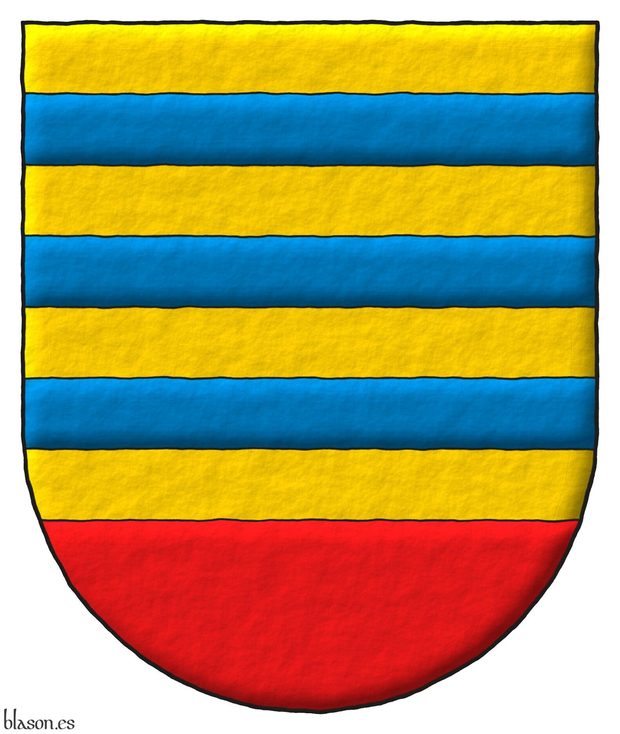
Or, three bars Azure; the base Gules.
Escudo de oro, tres burelas de azur; la punta de gules.
Arms painted by me, illuminated with lights and shadows, contoured in Sable, with a semi-circular outer contour and with a freehand finish.
Coat of arms of the lineage Egado emblazoned by me based on the description by [Cadenas y Vicent, V. de; 1987; page 635].
Blazon keywords: Or, Azure, Gules, Three, Bar and Base (lower 1/3).
Style keywords: Outlined in sable, Illuminated, Semi-circular and Freehand.
Classification: Personal, Lineage, Interpreted, Boa and Coat of arms.
Bearer: Egado, lineage.


![Ver [Emblem of the Society of Heraldic Arts] en instituciones citadas. Fortaleza de oro y mazonada de sable.](../css/Fortaleza.Institucion.png)
Emblem of the Society of Heraldic Arts
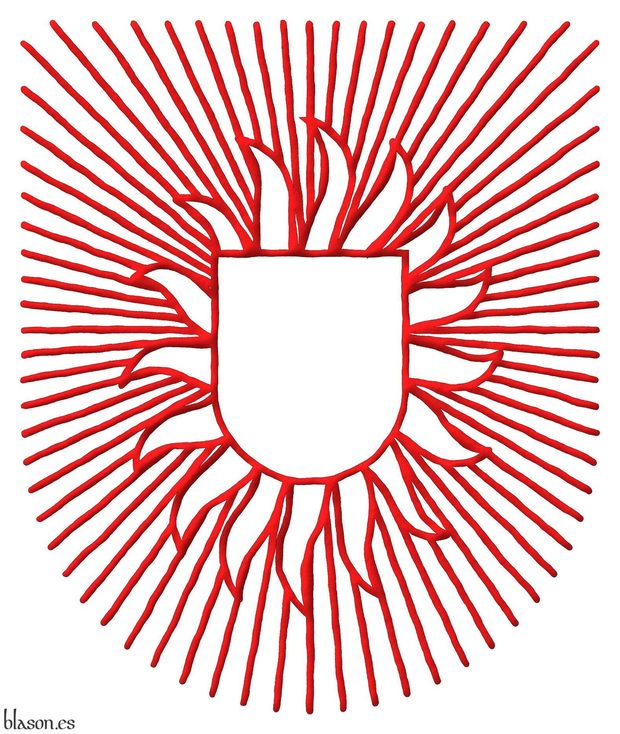
Emblem, an inescutcheon, enflamed in orle of sixteen points and irradiated throughout of sixty-four lines Gules.
Emblema, un escusón, llameante en orla de Dieciséis llamas y radiante de sesenta y cuatro líneas movientes todo de gules.
Its focus on heraldic art, along with its foundation in 1987, makes it a pioneering institution in this field on a global scale.
The Society of Heraldic Arts enjoys significant international recognition among heraldic artists, designers, and craftsmen, and its website is heraldic-arts.com.
Its members cover the full range of activities within heraldry for individuals, personal heraldry, public and private entities, socioeconomic heraldry, as well as municipalities, regions, etc., governance heraldry.
The Society of Heraldic Arts used to publish a quarterly magazine called «The Heraldic Craftsman», which was sent to all its members, but it is no longer in publication. The Society also provides advice on the correct use of heraldry to enhance corporate and personal identity.
Categories: Institution, Interpreted, Socioeconomic, Illuminated, Freehand, Semi-circular, Emblem, Gules, Inescutcheon, Enflamed, In orle, Sixteen, Flame, Irradiated, Sixty-four, Line and Throughout (all sides).
Root: Society of Heraldic Arts.


Eóin S. Morgan, structured and parallel blazons
Coat of arms of Eóin S. Morgan, UE, emblazoned by me, with the blazon written in English and Castilian in a structured way to observe the parallelism between both forms. He is the youngest son of Commander Stephen T. Morgan.
Blazon keywords: Or, Sable, Gules, Azure, Argent, One, Three, Griffin, Segreant, Chief, Invected, Naval crown, Cadency and Crescent.
Style keywords: Outlined in sable, Illuminated and Freehand.
Classification: Personal, Interpreted, Structured and parallel blazons, Boa and Coat of arms.
Bearer: Morgan, Eóin S..


Eschenlauer, Marc

Azure, two lions passant, guardant, winged, each holding in its paws an open book Argent, with the inscription «Pax Tibi Marce Evangelista Meus» Sable distributed on their four pages.
Escudo de azur, dos leopardos alados, teniendo cada uno en sus garras un libro abierto todo de plata, con la inscripción «Pax Tibi Marce Evangelista Meus» de sable distribuida en sus cuatro páginas.
Arms designed by me, illuminated with lights and shadows, outlined in Sable, with an ogee outer contour and with a freehand finish.
Coat of arms of Deacon Mark Eschenlauer designed by him, Fr. Yannick Beuvelet and me, and emblazoned by me.
Blazon keywords: Azure, Argent, Sable, Two, One, Four, Leopard, Winged, Grasping, Paw, Closed book, Book, Inscribed, Page and Motto.
Style keywords: Outlined in sable, Illuminated, Ogee and Freehand.
Classification: Religious, Created, Boa and Coat of arms.
Bearer: Eschenlauer, Marc.


Escutia Sánchez, María Dolores
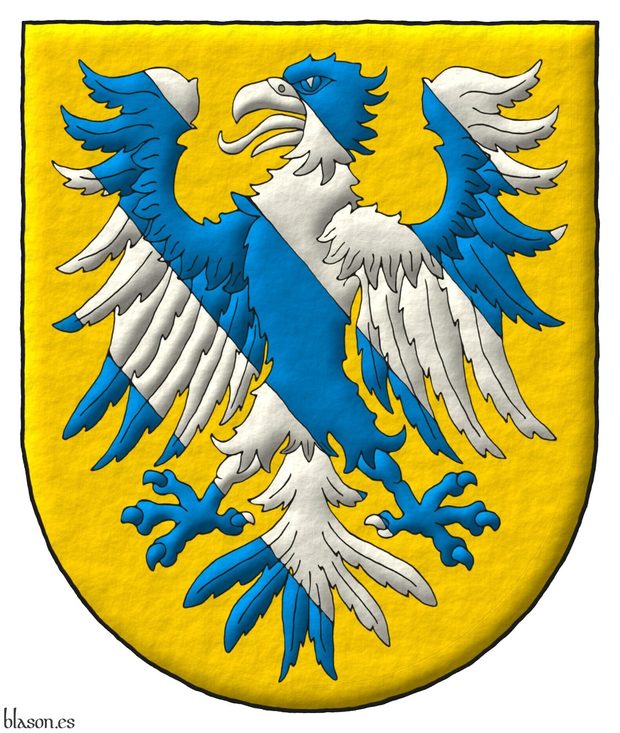
Or, an eagle displayed bendy Azure and Argent.
Escudo de oro, un águila bandada de azur y plata.
Coat of arms interpreted by me, highlighted with lights and shadows, contoured in Sable, with a semi-circular outer contour and with a freehand finishing.
Coat of arms of María Dolores Escutia Sánchez designed by Juan Lanzagorta Vallín and emblazoned by me.
Blazon keywords: Or, Azure, Argent, One, Eagle, Displayed and Bendy.
Style keywords: Outlined in sable, Illuminated, Semi-circular and Freehand.
Classification: Personal, Interpreted, Boa and Coat of arms.
Bearer: Escutia Sánchez, María Dolores.


España Herranz, Angel
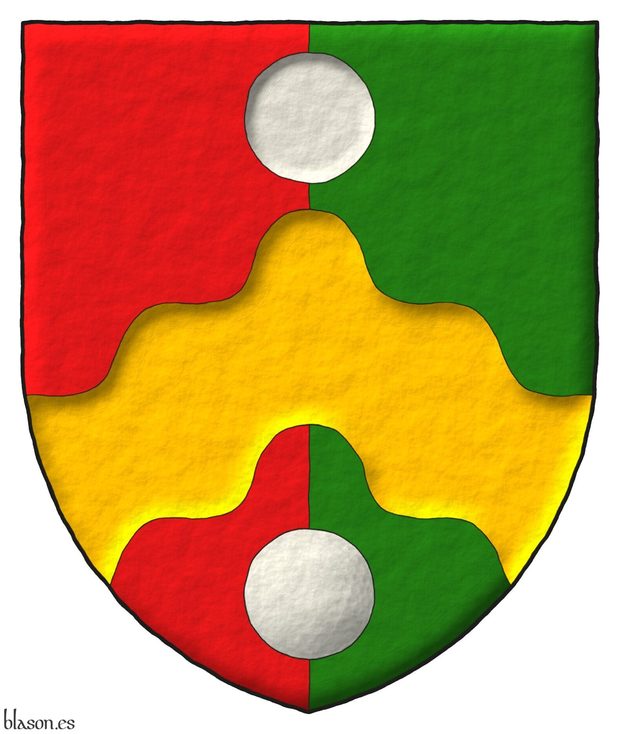
Party per pale Gules and Vert, overall a chevron wavy Or between two plates in pale.
Escudo partido de gules y sinople, brochante sobre el todo un cabrio ondado de oro acompañado de dos bezantes en palo de plata.
Coat of arms designed by me, highlighted with lights and shadows, outlined in Sable, and with a freehand finishing.
Coat of arms of Angel España Herranz designed by him and me, and emblazoned by me.
Design rationale
The first quarter of Gules with the dexter of the chevron Or are España, his surname. In the second quarter, the Vert is the green, the wavy chevron Or a bunker, and the two plates represent a ball and a hole of golf, his passion.
Blazon keywords: Gules, Vert, Or, Argent, One, Two, Party per pale, Overall, Chevron, Wavy, Between, Plate and In pale.
Style keywords: Outlined in sable, Illuminated and Freehand.
Classification: Personal, Created, Boa and Coat of arms.
Bearer: España Herranz, Angel.


Family of Milos Dukat, structured and parallel blazons
Coat of arms of the family of Milos Dukat from Czechia and the Basque Country, designed by them and me, and emblazoned by me, with the blazon written in English and Castilian in a structured way to observe the parallelism between both forms.
Blazon keywords: Azure, Gules, Argent, Or, One, Two, Three, Party per pale, Overall, In chief, Lion, Rampant, Double queued, Armed, Langued, Crowned, In base, Upon, Wavy, Bar, Ship and Full sail.
Style keywords: Outlined in sable, Illuminated, Semi-circular and Freehand.
Classification: Personal, Created, Structured and parallel blazons, Boa and Coat of arms.
Bearer: Dukat, family of Milos.


Farnese, Alessandro
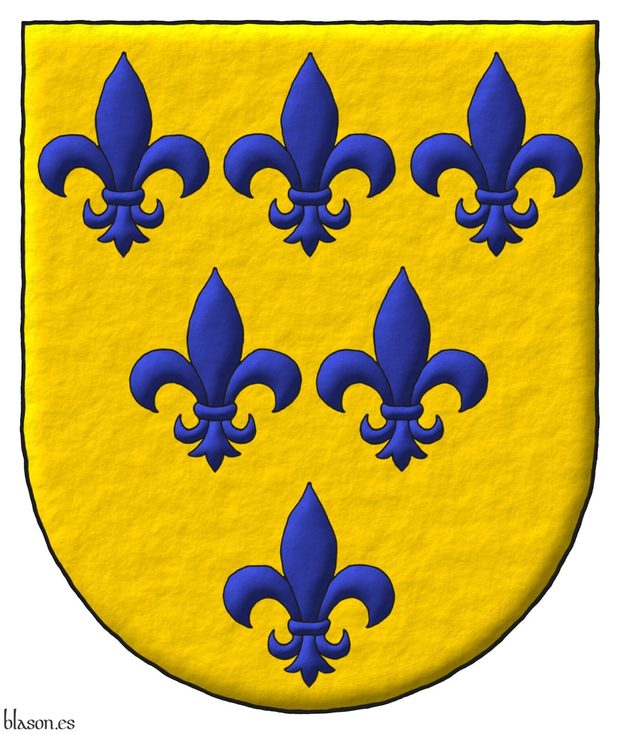
Or, six fleurs de lis Azure, 3, 2, and 1.
Escudo de oro, seis flores de lis de azur, 3, 2 y 1.
Coat of arms depicted by me, highlighted with lights and shadows, contoured in Sable, with a semi-circular outer contour and with a freehand finish.
Coat of arms of Alessandro Farnese, 1545–1592, emblazoned by me. In 1956, the fourth Tercio of the Spanish Legion was created and named Tercio Alessandro Farnese in his honor. The coat of arms of that Tercio features the arms of the Farnese in its central inescutcheon, although with its 6 fleurs de lis arranged in orle.
Blazon keywords: Or, Azure, Six and Fleur de lis.
Style keywords: Outlined in sable, Illuminated, Semi-circular and Freehand.
Classification: Personal, Interpreted, Boa and Coat of arms.
Bearer: Farnese, Alessandro.


Ferdinand III of Castile, open royal crown
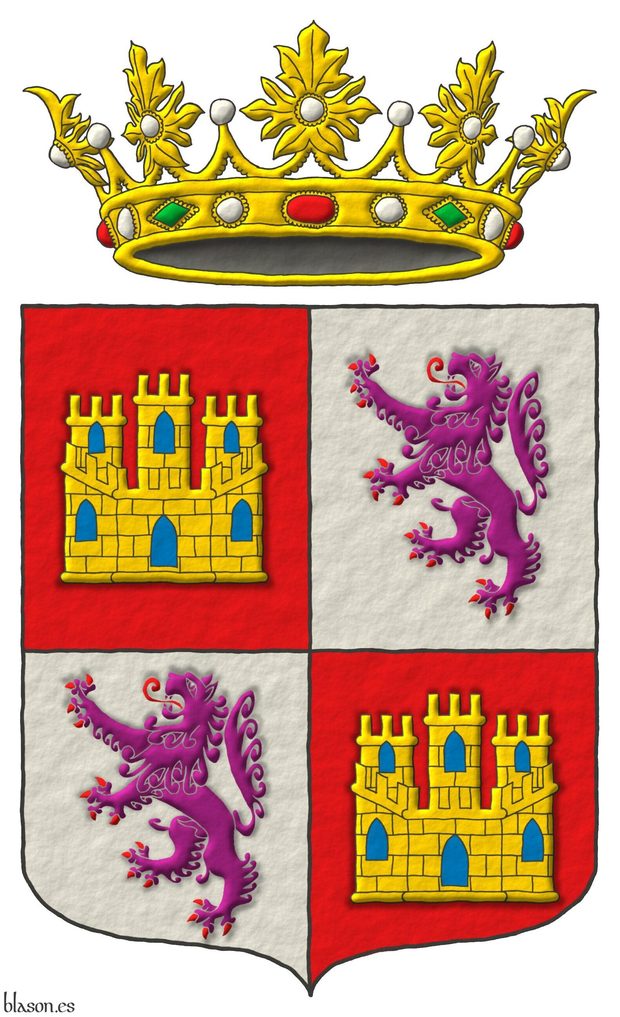
King of Castile from 1217 to 1252 and of León from 1230 to 1252.
Quarterly: 1 and 4 Gules, a castle triple towered Or, port and windows Azure, masoned Sable; 2 and 3 Argent, a lion rampant Purpure, armed and langued Gules. Crest: An open royal crown Or.
Escudo cuartelado: 1o y 4o de gules, un castillo de oro, aclarado de azur, mazonado de sable; 2o y 3o de plata, un león rampante de púrpura, armado y lampasado de gules. Timbrado de una corona real abierta.
Arms of the king, as interpreted as follows: the shield’s shape is pointed and rounded; the field, the castles, the lions, and the crown have been illuminated; only the castles and the lions have been shaded; and the whole composition features a raised-line finish.
Between the years 1217-1229, King Ferdinand III, before adopting this quarterly shield and when he was only King of Castile, in his seals «bears the arms of Leon (family arms) on the shield of the equestrian image and carries on the reverse the emblem of Castile (territorial sign)» [Menéndez Pidal de Navascués, F.; 1988; page 537].
Blazon keywords: Quarterly, Gules, Or, Azure, Sable, One, Castle, Port and windows, Masoned, Argent, Purpure, Lion, Rampant, Armed, Langued, Crest, Open royal crown and Crown.
Style keywords: Ogee, Illuminated, Shaded and Freehand.
Classification: Interpreted, Personal, Coat of arms and Kingdom of Castile and Leon.
Bearer: Ferdinand III of Castile.


Fernandez de Cordoba, Gonzalo

Or, three bars Gules.
De oro, tres fajas de gules.
Arms interpreted by me, highlighted with lights and shadows, contoured in Sable, with a semi-circular external shape and with a freehand finishing.
Coat of arms of Gonzalo Fernandez de Cordoba, 1453–1515, known as «The Great Captain», emblazoned by me. The Tercio Great Captain, 1st of the Spanish Legion, is named in honour of Gonzalo Fernandez de Cordoba, and the coat of arms of the unit bears a central inescutcheon with the arms of «The Great Captain».
Blazon keywords: Or, Gules, Three and Fess.
Style keywords: Outlined in sable, Illuminated, Semi-circular and Freehand.
Classification: Personal, Interpreted, Boa and Coat of arms.
Bearer: Fernandez de Cordoba, Gonzalo.


Fernández Marqués, Enrique, Coat of Arms

Checky of nine Or and Azure, the checks Or: 1st, 3rd, 5th, 7th, and 9th, two cotises Azure; 2nd, a sun Or; 4th, 6th, and 8th, two martlets Or, palewise.
Escudo equipolado de oro y azur: 1o, 3o, 5o, 7o y 9o, dos cotizas de azur; 2o, un sol de oro; 4o, 6o y 8o, dos marletas de oro, en palo.
Coat of arms that I have created with: the shield mouth rounded; the fields enameled in flat tinctures Or and Azure; the cotises, the sun, and the martlets are illuminated in Azure and Or and outlined in Sable; and the whole assembly is executed with a raised-stroke finish.
The original coat of arms design, along with many other heraldic objects, is registered in [Salmerón Cabañas, A.; 2016a; page 3].
Blazon keywords: Chequy of nine squares, Or, Azure, Bendlet, Sun in splendour, Martlet and In pale.
Style keywords: Rounded, Illuminated, Outlined in sable and Freehand.
Classification: Created, Personal and Coat of arms.
Bearer: Fernández Marqués, Enrique.


Five hurts and five pommes
Transform the blazon «Or» into «Or, five Pommes in saltire» and the blazon «Argent» into «Argent, five Hurts in saltire» moving the pommes and hurts through both metals, without breaking the rule of tinctures.
You can change one charge by another one, but only once.
For example, if you change «Sable, a Bend Argent» by «Sable, a Pale Argent», then the Pommes can arrive to «Or» blazon. However, this is not a solution, because the Hurts cannot walk to «Argent» blazon.
Think before you move the cursor or click on the following link and see the solution.
Categories: Riddle, Ogee, Outlined in sable, Freehand, Or, Argent, Vert, Azure, Gules, Sable, Hurt, torteau, pellet, pomme and golpe, Hurt, Pomme, In saltire, Fess, Saltire, Bend sinister, Cross, Pale and Bend.


Five hurts and five pommes, solution
For example, if you change «Azure, a Cross Argent» by «Azure, a Pall Argent», then the Pommes can arrive to «Or» blazon and the Hurts can arrive to «Argent» blazon. You can view both paths azure and vert in the following image.
Other solution is to change «Azure, a Cross Argent» by «Azure, a Bordure Argent».
Categories: Riddle solution, Ogee, Outlined in sable, Freehand, Or, Argent, Vert, Azure, Gules, Sable, Hurt, torteau, pellet, pomme and golpe, Hurt, Pomme, In saltire, Fess, Saltire, Bend sinister, Cross, Pale, Bend and Pall.


Francisco Javier Lasuncion Patus, schema 2x4
Gules, three lozenges Or; a bordure lozengy Gules and Or.
Schema for the design of the coat of arms of Javier Lasuncion Patus. There are only 2 different blazons, one in each row, because the difference between the columns is only in the lights and shadows. Blazon of the first row: Gules, three lozenges Or; a bordure lozengy Or and Gules.
Blazon keywords: Gules, Or, One, Three, Lozenge, Lozengy and Bordure.
Style keywords: Ratio, Outlined in sable, Illuminated, Semi-circular and Freehand.
Classification: Personal, Created, Schema, Boa and Coat of arms.
Bearer: Lasuncion Patus, Francisco Javier.


Freitas, lineage of Portugal

Blazon of the Freitas lineage of Portugal.
Gules, five mullets of six points Or.
Illuminated and a freehand finishing.
It can be found at [Cró, J. do; 1509; page 123].
Blazon keywords: Without divisions, Gules, Five, Mullet and Or.
Style keywords: Freehand, Outlined in sable, Illuminated and Semi-circular.
Classification: Interpreted, Lineage and Kingdom of Portugal.


Full achievement of Jean-Yves de Sainte Croix de la Sabliere
Azure, a cross ermine fimbriated Or, between four fleurs de lis Argent, each enfiled in a crown Or. Crest: Upon a helm befitting his degree, issuant from a crown of Baron, with a wreath Or and Azure, a falcon displayed, belled Azure, crowned Or, holding in its dexter talon an hourglass Or and in its sinister talon a fleur de lis Argent. Mantling: Azure doubled Or. Motto: «Per Crucem Triumphans» Sable, over a scroll Argent, doubled Gules. Supporters: Two lions rampant Or, langued Gules.
Coat of arms depicted by me, illuminated with lights and shadows, contoured in Sable, with a pointed outer contour and with a freehand finish.
G0128, Chief Herald of Arms of Malta's grant for the arms of Jean-Yves, de Sainte Croix de la Sabliere, UK. These arms have been emblazoned by me for such grant.
Blazon keywords: Azure, Or, Argent, Gules, One, Four, Cross, Ermine, Fimbriated, Between, Fleur de lis, Enfiled, Crown, Crest, Upon (wreath), Helm, Issuant, Crown of Baron, Above the shield, Wreath, Falcon, Belled, Crowned, Dexter, Talon, Hourglass, Sinister, Mantling, Doubled, Motto, Scroll, Supporter (animal), Supporter, Lion, Rampant and Langued.
Style keywords: Outlined in sable, Illuminated, Pointed and Freehand.
Classification: Personal, Interpreted, Boa and Coat of arms.
Bearer: Sainte Croix de la Sabliere, Jean-Yves de.


Full achievement of Mario Antonio Guallini
Argent, the letters «GVA» conjoined Sable, a trimount in base Vert; on a chief Azure, three mullets of eight points Or, 1 and 2. Crest: Upon a helm befitting his degree, with a wreath Or and Azure, a crown of Noble. Mantling: Azure doubled Or. Motto: «Guallini».
Coat of arms emblazoned by me, highlighted with lights and shadows, outlined in Sable, with an ogee outer contour and with a freehand finishing.
R0067, Chief Herald of Malta's register of the arms of Mario Antonio Guallini. These arms have been emblazoned by me for such register.
Blazon keywords: Argent, Vert, Sable, Azure, Or, One, Three, Eight, Letter, Conjoined, Trimount, In base, Chief, Mullet, Disordered, Upon (wreath), Helm, Wreath, Crown of Noble, Crown, Mantling, Doubled and Motto.
Style keywords: Outlined in sable, Illuminated, Ogee and Freehand.
Classification: Personal, Interpreted, Boa and Coat of arms.
Bearer: Guallini, Mario Antonio.


Full achievement of Markus Hermann Frank
Party per fess dancetty of three points Gules and Argent, in chief a winnowing fan reversed Or between two fleams addorsed Argent. Crest: Upon a helm befitting his degree issuant from a crown of Baron above the shield, with a wreath Argent and Gules, two arms embowed proper, vested Sable, cuffed Or, holding aloft a winnowing fan reversed Or. Mantling: Gules doubled Argent. Motto: «Ora et Labora». Supporters: Two lions passant, tails addorsed Sable, armed and langued Gules.
Coat of arms depicted by me, illuminated with lights and shadows, outlined in Sable, with a semi-circular outer contour and with a freehand finish.
G0129, Chief Herald of Arms of Malta's grant for the arms of Markus Hermann Frank, USA. These arms have been emblazoned by me for such grant.
Blazon keywords: Gules, Argent, Or, Sable, One, Two, Three, Party per fess, Dancetty, In chief, Winnowing fan, Reversed, Between, Fleam, Addorsed, Crest, Upon (wreath), Helm, Issuant, Crown of Baron, Crown, Above the shield, Wreath, Arm, Embowed, Proper, Vested, Cuffed, Grasping, Mantling, Doubled, Motto, Supporter (animal), Supporter, Lion, Passant, Tail addorsed, Armed and Langued.
Style keywords: Outlined in sable, Illuminated, Semi-circular and Freehand.
Classification: Personal, Interpreted, Boa and Coat of arms.
Bearer: Frank, Markus Hermann.


Full achievement of the Reverend John Muscat
Argent, a tree eradicated proper, in chief an escallop reversed Gules, between two flies pilewise proper. Crest: A galero Sable with two cords, one on each side, each with six tassels Gules. Motto: «No Fear In Love». Behind the shield, the cross of the Holy Sepulchre of Jerusalem. The shield is surrounded by the cross of a Knight Commander of the Holy Sepulchre of Jerusalem.
Arms interpreted by me, highlighted with lights and shadows, contoured in Sable, with a pointed external shape and with a freehand finish.
G0117, Chief Herald of Arms of Malta's grant for the arms of the Reverend John Muscat, Honorary Monsignor of the Canon Chapter, Roman Catholic Cathedral of the Assumption, Gozo. These arms have been emblazoned by me for such grant.
Blazon keywords: Argent, Gules, One, Two, Six, Tree, Eradicated, Proper, In chief, Escallop, Between, Fly, Pilewise, Crest, Galero, Cord, Tassel, Motto, Behind the shield, Cross, Surrounded and Decoration.
Style keywords: Outlined in sable, Illuminated, Pointed and Freehand.
Classification: Religious, Interpreted, Boa and Coat of arms.
Bearer: Muscat, John.


Gangoiti, lineage

Azure, in chief a label Or, and in base a fleur de lis Argent.
Escudo de azur, en jefe un lambel de oro y en punta una flor de lis de plata.
Coat of arms painted by me, illuminated with lights and shadows, contoured in Sable, with a semi-circular outer contour and with a freehand finishing.
Coat of arms of the lineage Gangoiti emblazoned by me based on the description by [Cadenas y Vicent, V. de; 1987; page 770].
Blazon keywords: Azure, Or, Argent, One, In chief, Label, In base and Fleur de lis.
Style keywords: Outlined in sable, Illuminated, Semi-circular and Freehand.
Classification: Personal, Lineage, Interpreted, Boa and Coat of arms.
Bearer: Gangoiti, lineage.


Garcia-Bosch-de Morales-de Sola née Adriaensen, Heidi
![Garcia-Bosch-de Morales-de Sola née Adriaensen, Heidi Party per pale: 1 Gules, a bend sinister debruised by an inescutcheon Or charged with a bend Azure charged with five fusils palewise Argent, in base on a triangle Argent the Sacred Heart of Jesus proper [for Adriaensen]; 2 Azure, a fleur de lis Argent above a doe sejeant proper surrounded by twelve mullets in orle Or [granted by Bourbon-Parma].](../escudo_armas/G0084.21.Lozenge.FreeHand.jpg)
Party per pale: 1 Gules, a bend sinister debruised by an inescutcheon Or charged with a bend Azure charged with five fusils palewise Argent, in base on a triangle Argent the Sacred Heart of Jesus proper [for Adriaensen]; 2 Azure, a fleur de lis Argent above a doe sejeant proper surrounded by twelve mullets in orle Or [granted by Bourbon-Parma].
Coat of arms emblazoned by me with a lozenge shape, illuminated, and with a free hand finishing.
G0084, Chief Herald of Malta's grant of Heidi Garcia-Bosch-de Morales-de Sola née Adriaensen's arms, whose coat of arms has been emblazoned by me.
Blazon keywords: Party per pale, Gules, One, Bend sinister, Or, In base, Triangle, Argent, Charged, Sacred Heart of Jesus, Heart enflamed, Heart, Enflamed, Proper, Overall, Inescutcheon, Bend, Azure, Five, Fusil, Palewise, Doe, Sejant, Above, Fleur de lis, Surrounded, Twelve, Mullet and In orle.
Style keywords: Outlined in sable, Illuminated, Freehand and Rhombus.
Classification: Personal, Interpreted and Coat of arms.
Bearer: Garcia-Bosch-de Morales-de Sola née Adriaensen, Heidi.


Germany, Federal Republic of

Or, a eagle displayed Sable, beaked, langued, armed and membered Gules.
Escudo de oro, un águila de sable, picada, lampasada, armada y membrada de gules.
Coat of arms painted by me, highlighted with lights and shadows, outlined in Sable, and with a freehand finish.
Coat of arms for the Federal Republic of Germany emblazoned by me.
Blazon keywords: Or, Sable, Gules, One, Eagle, Displayed, Beaked, Langued, Armed and Membered.
Style keywords: Outlined in sable, Illuminated and Freehand.
Classification: Civic, Interpreted, Boa and Coat of arms.
Bearer: Germany, Federal Republic of.


Giannelli and Mariana von Atzingen Gorga, Alessandro

Party per pale: 1 Azure, on two swords in saltire Argent, hilted Or, an oil lamp (oleum lucerna) Or, its eyelet Argent, enflamed of three flames proper; 2 Gules, at the nombril, a barbel naiant Argent between in chief a fleur de lis Or, and in base a trimount Vert.
Escudo partido: 1o de azur, dos espadas en sotuer de plata, guarnecidas de oro sumadas de una lámpara de aceite (oleum lucerna) de oro, con su orificio de plata, encendida de tres llamas al natural; 2o de gules, en el ombligo, un barbo nadante de plata acompañado en jefe de una flor de lis de oro y en punta de un monte de tres peñas moviente de la punta de sinople.
Coat of arms painted by me, highlighted with lights and shadows, contoured in Sable, with a pointed outer contour and with a freehand finishing.
G0093, Chief Herald of Arms of Malta's grant for the coat of arms of Alessandro Giannelli and Mariana von Atzingen Gorga. This coat of arms has been emblazoned by me.
Blazon keywords: Azure, Argent, Or, Gules, Vert, Two, One, Party per pale, Sword, In saltire, Hilted, Oil lamp, Enflamed, Flame, Proper, At the nombril, Barbel, Naiant, Between, In chief, Fleur de lis, In base and Trimount.
Style keywords: Outlined in sable, Illuminated, Pointed and Freehand.
Classification: Personal, Interpreted, Boa and Coat of arms.
Bearer: Giannelli and Mariana von Atzingen Gorga, Alessandro.


Gifra, Vittorio
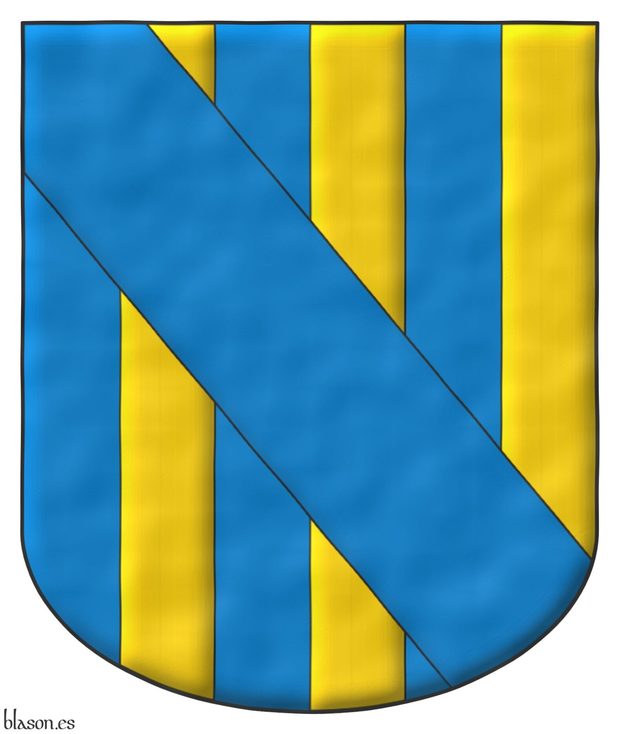
Paly of six Azure and Or; over all a bend Azure.
Escudo palado de seis piezas de azur y oro; brochante sobre el todo una banda de azur.
Blazon keywords: Paly, Six, Azure, Or, Surmounted, Overall (deprecated) and Bend.
Style keywords: Semi-circular, Freehand, Illuminated and Outlined in sable.
Classification: Coat of arms, Interpreted and Personal.
Bearer: Gifra, Vittorio.


Gilbert des Essarts

Gules, a chevron Or.
Escudo de gules, un cabrio de oro.
Arms painted by me, highlighted with lights and shadows, contoured in Sable, with a pointed outer contour and with a freehand finishing.
Arms of Gilbert des Essarts, France, emblazoned by me. Gilbert des Essarts was married to Marguerite Damartin, their alliance, marriage, took place in 1279, the tomb of Gilbert des Essarts and Marguerite Damartin is located in the chapel of la Poutiere, where the burial place of the house of Essarts is situated.
Blazon keywords: Gules, Or, One and Chevron.
Style keywords: Outlined in sable, Illuminated, Pointed and Freehand.
Classification: Personal, Kingdom of France, Interpreted, Boa and Coat of arms.
Bearer: Gilbert des Essarts.


Globe, Richard

Sanguine semy of nails Or.
Escudo de sanguíneo sembrado de clavos de oro.
Coat of arms interpreted and emblazoned by me with a pointed shape, illuminated, and with a freehand finishing.
Blazon keywords: Without divisions, Sanguine, Semé, Nail and Or.
Style keywords: Freehand, Outlined in sable, Illuminated and Pointed.
Classification: Interpreted and Kingdom of Denmark.
Bearer: Globe, Richard.


Gorges, Ralph de

Azure, four concentric annulets Argent.
Escudo de azur, cuatro anilletes concéntricos de plata.
Coat of arms depicted by me, highlighted with lights and shadows, outlined in Sable, with a rounded trapezoidal external shape and with a freehand finishing.
The coat of arms of Ralph de Gorges emblazoned by me.
Blazon keywords: Azure, Argent, Four, Moon, With human face, Environed, Concentric and Annulet.
Style keywords: Outlined in sable, Illuminated, Rounded trapezoid and Freehand.
Classification: Personal, Interpreted, Boa and Coat of arms.
Bearer: Gorges, Ralph de.


Graaf, Jay Geoffrey De

Party per fess, 1 Gules, a stag rampant, issuant from base proper, in the dexter chief a Maltese cross Argent; 2 Azure, a mullet of seven points Argent.
Escudo cortado: 1o de Gules, un ciervo rampante, moviente de la punta al natural, en la diestra del jefe, una cruz de Malta de plata; 2o de azur, una estrella de siete puntas de plata.
Coat of arms emblazoned by me, illuminated with lights and shadows, contoured in Sable, with a pointed outer contour and with a freehand finishing.
G0131, augmentation of G0042, Chief Herald of Arms of Malta's grant of the coat of arms of Jay Geoffrey De Graaf, Australia. The augmentation consists of the addition of a Maltese cross Argent in the dexter chief. This coat of arms has been emblazoned by me.
Blazon keywords: Gules, Azure, Argent, One, Party per fess, Stag, Rampant, Issuant from base, Proper, In the dexter chief, Eight-pointed cross, Cross couped and Mullet.
Style keywords: Outlined in sable, Illuminated, Pointed and Freehand.
Classification: Personal, Interpreted, Boa and Coat of arms.
Bearer: Graaf, Jay Geoffrey De.


Gregorio Lanzagorta Llaguno
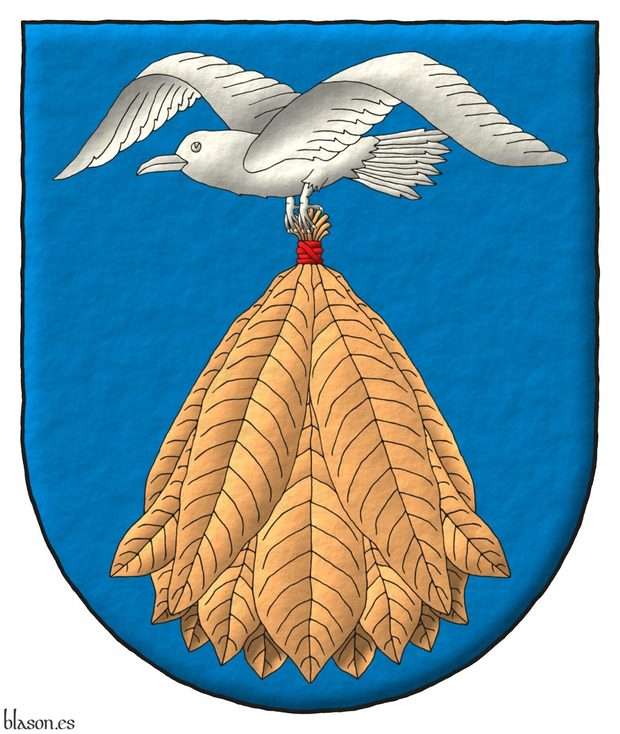
Azure, a seagull volant Argent, carrying in its feet a sheaf of tobacco proper, bound Gules.
Escudo de azur, una gaviota volante de plata, llevando entre sus patas una gavilla de tabaco al natural, liada de gules.
Arms painted by me, highlighted with lights and shadows, outlined in Sable, with a semi-circular outer contour and with a freehand finishing.
The coat of arms of Gregorio Lanzagorta Llaguno, harbor of San Blas, and cigar maker in Nayarit, Mexico. This coat of arms was designed by Juan Lanzagorta Vallín and painted by me.
Blazon keywords: Azure, Argent, Gules, One, Seagull, Volant, Grasping, Foot (palmiped), Sheaf of tobacco, Proper and Bound.
Style keywords: Outlined in sable, Illuminated, Semi-circular and Freehand.
Classification: Personal, Interpreted, Boa and Coat of arms.
Bearer: Gregorio Lanzagorta Llaguno.


Grimaldi, François

François Grimaldi ~ Francisco Grimaldi ~ Francesco Grimaldi.
Fusilly Argent and Gules.
Escudo fusado de plata y gules.
Coat of arms interpreted with: the semicircular base shape; the field of plain metal Argent; the fusils illuminated in Gules, outlined in Sable; the fusilly of proportion 3 x 5; and the whole with a raised-stroke effect.
Unlike how I have blazoned it here, this coat of arms can be found blazoned in [Arco y García, F. del; 1996b; page 10] as «Fusilly Argent and Gules».
He was the Genoese leader of the Guelphs who conquered the so-called Rock of Monaco on January 8, 1297, at night. To enter his fortress and have the gates opened for him, he dressed as a Franciscan monk along with his cousin Rainier I, Lord of Cagnes, and thus entered with his group of armed men. That is why the coat of arms of the Principality of Monaco has as supporters 2 Franciscan monks unsheathing their swords.
Francesco Grimaldi had no children, so after his death in 1309, he was succeeded by his cousin Rainier I, with whom he entered Monaco, and it is from Rainier I that the Grimaldi family and the Princes of Monaco who have governed the Principality ever since descend.
Blazon keywords: Fusilly, Argent and Gules.
Style keywords: Semi-circular, Illuminated, Outlined in sable and Freehand.
Classification: Interpreted and Personal.
Bearer: Grimaldi, François.


Gryffindor House with a lion

Party per pale Gules and Or, overall a lion rampant counterchanged.
Escudo partido de gules y oro, un león rampante del uno al otro.
Imaginary arms of Gryffindor with the following characteristics: the mouth of the shield is rounded; the shield is party per pale; the field is enameled in flat tinctures of Gules and Or; the lion is illuminated in Or and Gules and outlined in Sable; and it is made with a hammered metal effect.
Blazon keywords: Party per pale, Or, Gules, Lion, Rampant and Counterchanged.
Style keywords: Rounded, Illuminated, Outlined in sable and Freehand.
Classification: Interpreted, Imaginary, Coat of arms and Harry Potter saga.
Imaginary bearer: Gryffindor at Hogwarts.


Gudja, municipality of
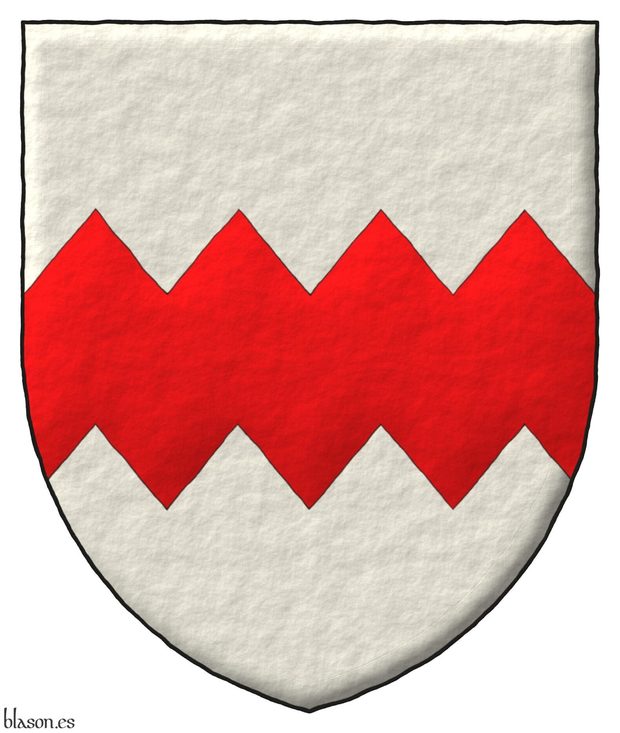
Argent, a fess dancetty of four points Gules.
Escudo de plata, una faja encajada de cuatro piezas de gules.
Coat of arms depicted by me, highlighted with lights and shadows, contoured in Sable, with a pointed outer contour and with a freehand finish.
G0138, Chief Herald of Arms of Malta's grant of the coat of arms of the municipality of Gudja, Malta. This coat of arms has been emblazoned by me and has been published in the Malta Government Gazette, number 21486, page 10730, with the blazon «Argent a fess dancetty of four points counterdancetty of three points all Gules».
Blazon keywords: Argent, Gules, Four, Fess and Dancetty.
Style keywords: Outlined in sable, Illuminated, Pointed and Freehand.
Classification: Civic, Interpreted, Boa and Coat of arms.
Bearer: Gudja, municipality of.


Henry of Castile, Infante

Quarterly: 1 and 4 Gules, a castle triple-towered Or, port and windows Azure, and masoned Sable; 2 and 3 Argent, a cross flory Purpure.
Escudo cuartelado: 1o y 4o de gules, un castillo de oro, aclarado de azur, mazonado de sable; 2o y 3o de plata, una cruz flordelisada de púrpura.
Coat of arms emblazoned by me, illuminated with lights and shadows, contoured in Sable, with an ogee external shape and with a freehand finish.
Coat of arms of the Infante Henry of Castile, 1230–1303, 6th offspring of the King Ferdinand III of Castile, 1199-1252, and the Queen Beatrice of Swabia, 1205–1235. He bore his father's arms, replacing the lion Purpure of the Kingdom of León with a cross flory Purpure, likely due to his close association with the Order of Calatrava, whose emblem is a cross flory Gules. However, he retained the metal Argent field in the 2nd and 3rd quarters and the lion's purpure color, suggesting this was more of a conceptual change than a quartering by alliance with the Order of Calatrava.
Blazon keywords: Gules, Or, Azure, Sable, Argent, Purpure, One, Quarterly, Castle, Triple-towered, Port and windows, Masoned, Cross flory and Cross couped.
Style keywords: Outlined in sable, Illuminated, Ogee and Freehand.
Classification: Personal, Kingdom of Castile and Leon, Interpreted, Boa and Coat of arms.
Bearer: Henry of Castile, Infante.


Hérail, Gilbert

Argent, a cross Azure.
Escudo de plata, una cruz de azur.
Coat of arms emblazoned by me with a semi-circular shape, illuminated, and with a freehand finishing.
Blazon keywords: Argent, One, Cross and Azure.
Style keywords: Outlined in sable, Illuminated, Semi-circular and Freehand.
Classification: Religious, Military, Knights Templar, Interpreted and Coat of arms.
Bearer: Hérail, Gilbert.


![Ver [Heraldic blog of David B. Appleton] en enlaces recomendados. Áncora de oro y la divisa enlace.](../css/Ancora.Enlace.png)
Heraldic blog of David B. Appleton

Appleton Studios
David B. Appleton studies, researches, teaches, and writes about heraldry, and through his blog, he shares his heraldic knowledge with us, as well as through publications and presentations.
David B. Appleton is open to questions from his readers and provides advice on heraldic topics in which he specializes.
His blog is Blog.AppletonStudios.com and his website is AppletonStudios.com, from which he offers his services related to the world of heraldry, its dissemination, and knowledge.
Since 2009, David B. Appleton's heraldic blog has been an endless source of knowledge, images, ideas, curiosities, original reflections, and links to heraldic sites selected by him.
Heraldry: Musing on an esoteric topic
David B. Appleton stands out for his continuous analysis of all types of heraldic manifestations, which he finds everywhere, in the world we live in: from those we have inherited from ancient times to the fiercely current, from books to cinema, from fashionable clothing to urban furniture, from east to west and north to south, including those that appear in logos and emblems, those using traditional techniques and those created or disseminated through new technologies, on ships, sports cars, and airplanes, on porcelain, facades, and stained glass, on television, on t-shirts and coins, in auctions and universities, in comics and sports, etc. with a systematic publication rhythm, more than 2 posts per week, nothing heraldic escapes the record and genuine analysis of David B. Appleton on Blog.AppletonStudios.com, which I highly recommend.
Categories: Link, Interpreted, Personal, Coat of arms, Without divisions, Freehand, Soft metal, Illuminated, Outlined in sable, Canting, Heraldry and heralds, Argent, Azure, Gules, Vert, Chevronel, Between, Apple, Slipped and Leaved.
External links:
- Interpretation of his coat of arms.
- Interpretation by Xavier García at Appleton Studios.
- Interpretation by Xavier García at Dibujo Heráldico with his blazon in English and Spanish.
Root: Appleton, David B..


Howard II, Dr. James Patrick

Argent, a tetrahedron Azure, pierced by a sword bendwise, point downwards Or, garnished Azure.
Escudo de plata, un tetraedro de azur, atravesado de una espada puesta en banda, bajada de oro, guarnecida de azur.
Arms emblazoned by me, illuminated with lights and shadows, outlined in Sable, with an ogee external shape and with a freehand finishing.
G0102, Chief Herald of Arms of Malta's grant for the coat of arms of Dr. James Patrick Howard II, USA. This coat of arms has been emblazoned by me.
Blazon keywords: Argent, Azure, Or, One, Tetrahedron, Geometric solid, Pierced, In bend, Sword, Point downwards and Garnished.
Style keywords: Outlined in sable, Illuminated, Ogee and Freehand.
Classification: Personal, Interpreted, Boa and Coat of arms.
Bearer: Howard II, Dr. James Patrick.


Hufflepuff at Hogwarts

Hard work, patience, justice, and loyalty.
Party per pale: 1 Or, a badger rampant Sable; 2 Sable, a badger rampant, regardant Or.
Escudo partido: 1o de oro, un tejón rampante de sable; 2o de sable, un tejón rampante, contornado de oro.
Imaginary arms of the student House Hufflepuff at Hogwarts School of Witchcraft and Wizardry, made with the following differential characteristics compared to other representations: the mouth of the coat of arms is rounded; the shield is party per pale; the field and the badgers are enameled in flat tinctures of Sable and Or; the badgers, facing Dexter and Sinister, are outlined by the field; and the whole is finished with a raised-stroke effect.
This imaginary coat of arms of the Hufflepuff House at Hogwarts has been interpreted without taking much into account other of the multiple realizations that have been produced and disseminated.
Blazon keywords: Party per pale, Or, Sable, Badger, Rampant and Regardant.
Style keywords: Rounded, Plain tincture, Outlined in the field tincture and Freehand.
Classification: Interpreted, Imaginary, Coat of arms and Harry Potter saga.
Imaginary bearer: Hufflepuff at Hogwarts.


ISCH Certification for Manel González López
The Commoners' Certification of Arms for Manel Gonzalez Lopez with his coat of arms emblazoned by me.
Quarterly: 1 and 4 Gules, a Castle triple towered Or, port, windows and masoned Sable; 2 and 3 Or, thirteen Torteaus, three, three, three, three, and one.
Blazon keywords: Quarterly, Gules, One, Castle, Or, Port and windows, Masoned, Sable, Thirteen and Torteau.
Style keywords: Ogee, Freehand and Outlined in sable.
Classification: Interpreted, Personal, Certification and Heraldic document.
Bearer: González López, Manel.


Israel

Israel~ישראל.
Azure, a Menorah between two olive branches Argent; in base the legend
«ישראל» Argent.
Interpreted coat of arms: with a rounded and pointed shape; illuminated with metal argent and color azur; outlined with sable; and a Watercolor finish.
Blazon keywords: Without divisions, Azure, One, Menorah, Argent, Accosted, Two, Branch, Olive tree, Tree and Motto (identification).
Style keywords: Ogee, Illuminated, Outlined in sable and Freehand.
Classification: Coat of arms, Interpreted, Civic and State of Israel.
Bearer: Israel.


Jamilena
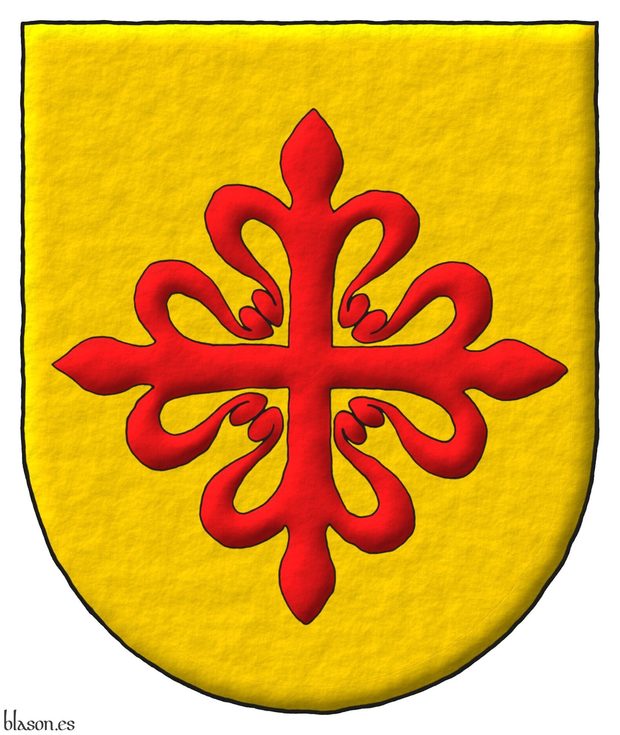
Coat of arms of the municipality of Jamilena, province of Jaén.
Or, a cross of Calatrava.
Escudo de oro, una cruz de Calatrava.
Coat of arms interpreted as follows: the shield's shape is a semicircular arch; the field is illuminated in metal Or; the cross of Calatrava is outlined in Sable and illuminated in Gules; and the entire piece has a rough line finish.
Blazon keywords: Without divisions, Or, Cross of Calatrava, Cross couped and Cross.
Style keywords: Semi-circular, Illuminated, Outlined in sable and Freehand.
Classification: Interpreted, Civic and Coat of arms.
Bearer: Jamilena.


Janovsti of Janovic of Czechia, lineage
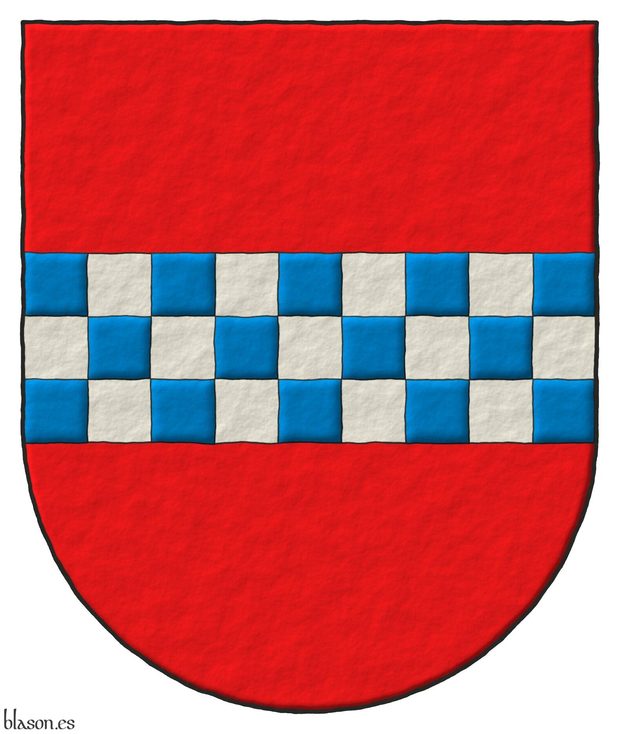
Gules, a fess chequey Azure and Argent.
Escudo de gules, una faja ajedrezada de azur y plata.
Arms emblazoned by me, highlighted with lights and shadows, contoured in Sable, with a semi-circular outer contour and with a freehand finish.
Coat of arms of the lineage Janovsti of Janovic of Czechia. It is also the coat of arms of the lineage Klenovsky of Klenove of Czech. I have emblazoned it with a fess chequy of 3 rows, symmetric and with 9 columns of squares, provided that its height is 1/3 of the width of the coat of arms.
Blazon keywords: Gules, Azure, Argent, One, Three, Nine, Fess and Chequey.
Style keywords: Outlined in sable, Illuminated, Semi-circular and Freehand.
Classification: Personal, Lineage, Interpreted, Boa and Coat of arms.
Bearer: Janovsti of Janovic of Czechia, lineage.
Blazon equivalent to: Lindsay of Scotland, lineage.


Javier Fernández-Cortés y Fonseca, motto and nobility of Asturias
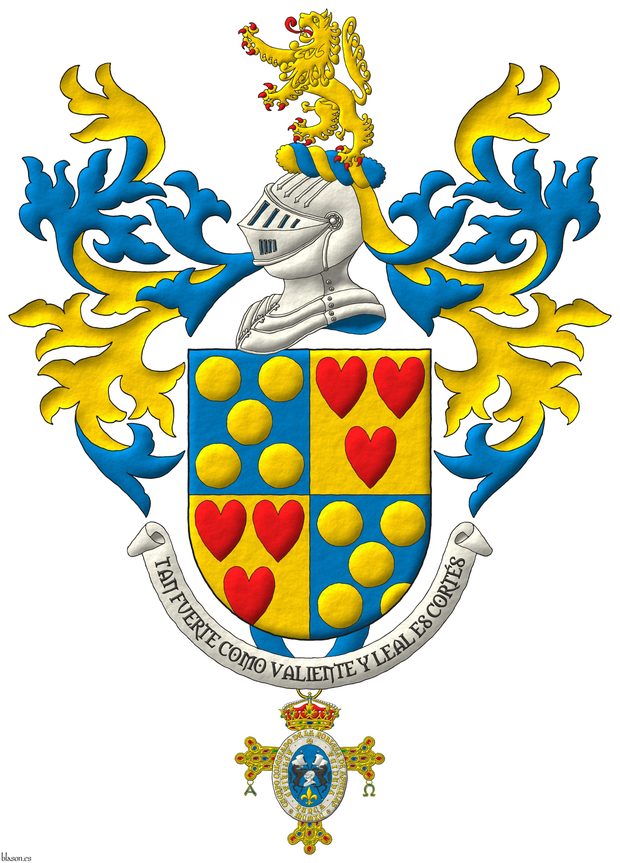
Quarterly: 1 and 4 Azure, five Bezants in saltire; 2 and 3 Or, three hearts Gules ordered. Crest: Upon a Helm Argent with a Wreath Or and Azure a Lion rampant Or, langued and armed Gules. Mantling: Azure doubled Or. Suspended from the base the insignia of the Cuerpo de la Nobleza del Principado de Asturias. Lema: «Tan fuerte como valiente y leal es Cortés».
Blazon keywords: Quarterly, Azure, Five, Bezant, Bezant and plate, In saltire, Or, Three, Heart, Gules, Ordered, Crest and mantling, Helm, Argent, Mantling, Wreath, Lion, Rampant, Langued, Armed, Suspended, Base (lower 1/3), Decoration and Motto.
Style keywords: Freehand, Semi-circular, Illuminated and Outlined in sable.
Classification: Coat of arms, Interpreted and Personal.
Bearer: Fernández-Cortés y Fonseca, Javier.


Jean-Philippe Sendat

Gules, a lion rampant Or, langued and armed Vert; a bordure Azure charged with six escallops Argent. Moto: «Vade Fortis Anime».
Escudo de gules, un león rampante de oro, lampasado y armado de sinople; una bordura de azur cargada de seis veneras de plata. Lema: «Vade Fortis Anime».
Coat of arms emblazoned by me, highlighted with lights and shadows, contoured in Sable, with a pointed external shape and with a freehand finishing.
Blazon keywords: Gules, Or, Vert, Azure, Argent, One, Six, Lion, Rampant, Langued, Armed, Bordure, Charged, Escallop and Motto.
Style keywords: Outlined in sable, Illuminated, Pointed and Freehand.
Classification: Personal, Interpreted, Boa and Coat of arms.
Bearer: Sendat, Jean-Philippe.


Joan de Okinton

John de Octon ~ Joan de Okinton.
Or, three cinquefoils Gules.
Escudo de oro, tres quinquefolios de gules.
Included in [Vincent, MS; 1285; number 620] also known as [St. George's Roll; 1285; number 620].
Blazon keywords: Without divisions, Or, Three, Cinquefoil, Gules and Ordered.
Style keywords: Triangular curved, Illuminated, Outlined in sable and Freehand.
Classification: Interpreted and Personal.
Bearer: Juan de Octon.


John Brady, structured and parallel blazons
The coat of arms of John Brady from Ireland, designed and emblazoned by me.
Blazon keywords: Sable, Or, Argent, Azure, One, Three, Party per chevron, Dexter, Chief, Sun in splendour, Sinister, Hand, Couped, Wrist, Bendwise, Proper, In base, Brach hound, Dog, Head and Disordered.
Style keywords: Outlined in sable, Illuminated and Freehand.
Classification: Personal, Created, Structured and parallel blazons, Boa and Coat of arms.
Bearer: Brady, John.


John I of England

John Lackland ~ Juan sin Tierra ~ Sans-Terre.
Gules, three lions, passant, guardant, in pale Or, armed and langued Azure.
Escudo de gules, tres leopardos en palo de oro, armados y lampasados de azur.
Existing arms interpreted as follows: the mouth of the coat of arms is semicircular (round); the field has been enamelled in a flat tint of Gules; the three leopards are outlined in Sable and illuminated in Or and Azure; and the whole is executed with a raised-stroke effect.
Regarding this version of the shield of John I, [Humphery-Smith, C.; 1983] writes that «Richard's younger brother John... bore two lions because he was a junior member of the Plantagenet line», thus showing his belonging to a second level of the ruling family, although, after his brother Richard I of England, he not only ended up being king but it was also his line of succession that continued to reign in England.
Blazon keywords: Without divisions, Gules, Or, Azure, Three, Leopard, Armed, Langued and In pale.
Style keywords: Semi-circular, Illuminated, Outlined in sable and Freehand.
Classification: Interpreted, Personal, Coat of arms, House of Plantagenet and Kingdom of England.
Bearer: John I of England.


John Stuart, schema 2x3
Or, a fess chequey Argent, charged with an ermine spot, and Azure, between in chief two cross patty Gules, in base a thistle proper; a diminished bordure Azure.
The coat of arms of Reverend John Stuart, XVIII century, emblazoned by me in 3 approaches: 1) Classic bordure: Using a bordure with a width equal to 1/6 of the coat of arms' base. In the image, this is marked with texts and lines in Vert. Notice that the squares in columns 2 and 8 are split by the inner border of the bordure, which is unfortunate as it disrupts the design. 2) Diminished bordure: Using a narrower bordure with a width equal to 2/3 of the classic bordure, corresponding to 1 square of the fess chequey. In the image, this is marked with texts and lines in Gules. This approach avoids splitting any squares, allows for larger figures, and is my preferred solution. In England, diminished bordures, often simply blazoned as bordure, are more common than in Castile. 3) Without squares splitted: Retaining the classic bordure but shifting the fess chequey 1/2 square to either dexter or sinister to prevent splitting squares. However, this sacrifices the symmetry of the design. This last adjustment was used in the hatchment of Reverend John Stuart in St. George's Cathedral, Kingston, Ontario, 1785.
Blazon keywords: Or, Argent, Azure, One, Three, Nine, Two, Fess, Chequey, Charged, Ermine spot, Between, In chief, Cross, Patty, In base, Thistle, Proper and Diminished bordure.
Style keywords: Ratio, Outlined in sable, Illuminated, Semi-circular and Freehand.
Classification: Personal, Interpreted, Schema, Boa and Coat of arms.
Bearer: Stuart, John.


John XXI
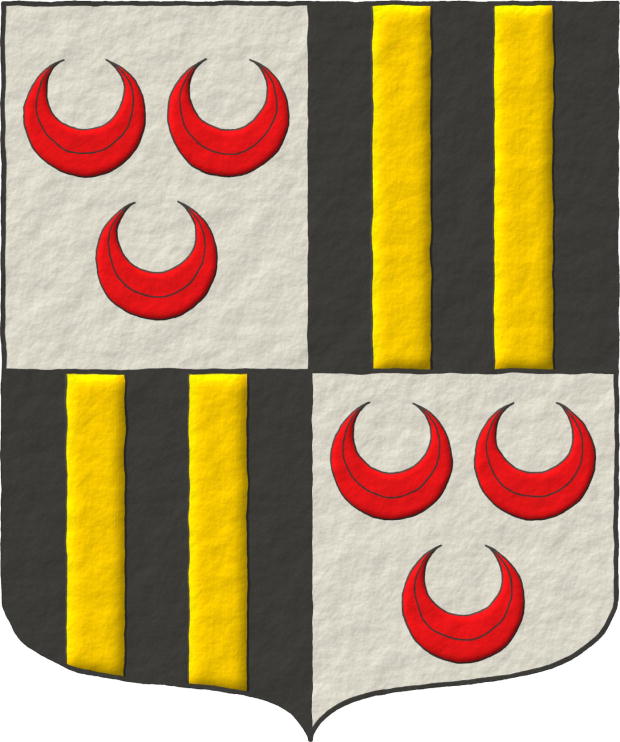
187th Pope of the Church, from 1276 to 1277. «Johannes XXI», born Pedro Julião, also known as Pedro Hispano, born in Lisbon, Portugal.
Quarterly: 1 and 4 Argent, three crescents Gules; 2 and 3 Sable, two pallets Or.
Escudo cuartelado: 1o y 4o de plata, tres crecientes de gules; 2o y 3o de sable, dos palos de oro.
Coat of arms with: a shield with a pointed and rounded top; the field in plain Argent and Sable; the figures outlined in Sable and illuminated in Gules and Or; and the whole in an elevated line style.
John XXI should have actually been John XX, but Cardinal Pedro Julião, upon being elected pope, decided to skip the number XX and called himself John XXI, with the aim of correcting what was believed to be a historical error, which in the end was not so.
This historical error consisted of the belief in the existence of 2 popes named John XIV, as seemed to be deduced from the records of the «Liber Pontificalis». They were therefore referred to as: the 1st John XIV and the 2nd John XIV bis.
By skipping the number XX, John XXI believed he was correcting this historical error. But the reality is that there was only one Pope John XIV, the same pope with 2 entries in the «Liber Pontificalis», the 1st entry during the time of his pontificate in freedom and the 2nd entry for the time he exercised his pontificate in prison, imprisoned by his enemy, the so-called «antipope» Boniface VII, who, in turn, managed to occupy the papal throne twice, separated by a decade, in 974 and in 984, somewhat like a double «antipope».
Therefore, John XXI, instead of correcting a historical error, made one, and for this reason, there is no Pope John XX in all of history, nor can there ever be one.
Blazon keywords: Quarterly, Argent, Three, Crescent, Gules, Ordered, Sable, Two, Pale and Or.
Style keywords: Ogee, Illuminated, Outlined in sable and Freehand.
Classification: Interpreted, Religious and Papal States.
Bearer: John XXI.


Juchter van Bergen Quast, Rudolph Andries Ulrich

Gules, three Leopards faces Or, the whole within a Border Or with two Bars Gules.
Escudo de gules, tres cabezas de leopardo de oro; una bordura de oro con dos burelas de gules.
Interpreted coat of arms: with a pointed shape; illuminated with metal or and color gules; outlined with sable; and a freehand finish.
Blazon keywords: Gules, Three, Head, Leopard, Or, Ordered, Bordure, Two and Bar.
Style keywords: Freehand, Pointed, Illuminated and Outlined in sable.
Classification: Coat of arms, Interpreted and Personal.
Bearer: Juchter van Bergen Quast, Rudolph Andries Ulrich.


Kingdom of Jerusalem

Metal Or over metal Argent.
Argent, a cross potent cantoned of four crosslets potent Or.
Escudo de plata, una cruz potenzada cantonada de cuatro cruces potenzadas todas de oro.
Illuminated with lights and shadows and with a freehand finish.
Perhaps the most classic example of non-compliance with the heraldic rule of tinctures having metal Or over metal Argent. In [Galdiano L.; Century XVII; folio 6], you can see a version of the arms of Jerusalem with the field in Gules, which would indeed follow the rule of tinctures as it is metal on color.
Blazon keywords: Without divisions, Argent, One, Cross potent, Cross couped, Cantoned, Four and Or.
Style keywords: Freehand, Outlined in sable, Illuminated, Semi-circular and Metal on metal.
Classification: Interpreted and Civic.
Bearer: Kingdom of Jerusalem.


La Forcade, Pierre de

Pierre de La Forcade ~ Pierre de Forcade (XV century).
Lozengy Or and Azure, a pale Gules.
Escudo losanjado oro y azur, un palo de gules.
Coat of arms interpreted with: the semicircular base shape; the field of plain metal Or; the lozenges illuminated in Azure, outlined in Sable and with their 4 angles at 90o; the lozengy of proportion 5 x 6; the pale illuminated in Gules and outlined in Sable; and the whole with a raised-stroke effect.
Blazon keywords: Lozengy, Or, Azure, Pale and Gules.
Style keywords: Semi-circular, Illuminated, Outlined in sable and Freehand.
Classification: Interpreted and Personal.
Bearer: La Forcade, Pierre de.


Lanzagorta Aras, Juan

Party per pale bendy wavy Azure and Or and bendy wavy Azure and Argent, overall three fish naiant in pale Argent.
Escudo partido: 1o bandado ondado de azur y oro; 2o bandado ondado de azur y plata; brochante sobre el todo tres peces nadantes en palo de plata.
Arms emblazoned by me, highlighted with lights and shadows, contoured in Sable, with a semi-circular external shape and with a freehand finishing.
Coat of arms of Juan Lanzagorta Aras designed by Juan Lanzagorta Vallín and emblazoned by me. In the case of bendy fields like these, it is not immediately clear whether they should be blazoned as bendy Azure and Or and bendy Azure and Argent, or rather as bendy Or and Azure and bendy Argent and Azure. I have followed the criterion of starting to list the tinctures from the dexter chief of each quarter, and for that reason I blazon them as bendy, in this case wavy bendy, Azure and Or and wavy bendy Azure and Argent, since in both quarters it is Azure that begins at the dexter chief.
Blazon keywords: Azure, Or, Argent, Three, Party per pale, Bendy, Wavy, Overall, Fish, Naiant and In pale.
Style keywords: Outlined in sable, Illuminated, Semi-circular and Freehand.
Classification: Personal, Interpreted, Boa and Coat of arms.
Bearer: Lanzagorta Aras, Juan.


Lanzagorta Escutia, Juan Bautista

Azure, a chief wavy and barry wavy of twelve Azure and Argent debruised and interlaced by a fish urinant Argent.
Escudo de azur, un jefe ondado y burelado ondado de doce piezas de azur y plata, resaltado y entrelazado de un pez sumergido de plata.
Coat of arms of Juan Bautista Lanzagorta Escutia designed by Juan Lanzagorta Vallín and emblazoned by me. It recalls the sad story of a shipwreck.
Blazon keywords: Azure, Argent, One, Twelve, Chief, Wavy, Barry, Debruised, Interlaced, Fish and Urinant.
Style keywords: Ratio, Outlined, Outlined in sable, Illuminated, Semi-circular and Freehand.
Classification: Personal, Interpreted, Boa and Coat of arms.
Bearer: Lanzagorta Escutia, Juan Bautista.


Lanzagorta Vallín, Juan

Argent masoned Sable, a chevron Azure, in chief a wolf and a she-wolf combatant Sable.
Escudo de plata mazonado de sable, un cabrio de azur, en jefe un lobo y una loba afrontados de sable.
Coat of arms emblazoned by me, outlined in Sable, with details that emulate low and hollow relief, with an ogee external shape and with a freehand finish.
Coat of arms of Juan Lanzagorta Vallin designed by him and emblazoned by me. The chevron Azure symbolizes the firmament seen through an open hole in the masoned wall, like a window open to the sky.
Credits: Juan Lanzagorta Vallin is the designer of the coat of arms.
Blazon keywords: Azure, Argent, Sable, One, Two, Masoned, Chevron, In chief, Wolf, She-wolf and Combatant.
Style keywords: Outlined in sable, Ogee and Freehand.
Classification: Personal, Interpreted, Boa and Coat of arms.
Bearer: Lanzagorta Vallín, Juan.


László Linnet Regina
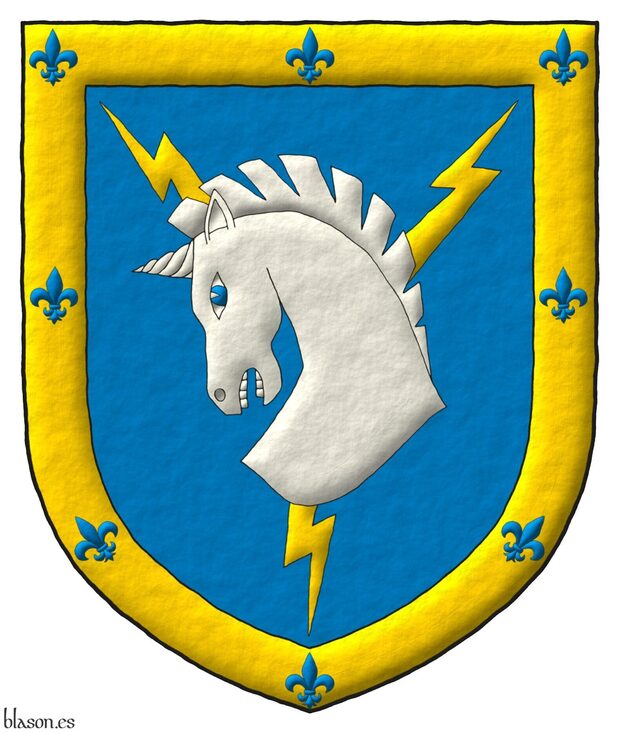
Azure, three lightning flashes in pall Or, debruised by a unicorn's head couped Argent, the eyes Azure; a bordure Or charged with eight fleurs de lis Azure.
Escudo de azur, tres rayos en perla de oro, resaltados de una cabeza de unicornio cortada de plata; una filiera de sable, cargada de ocho flores de lis de oro.
Arms depicted by me, illuminated with lights and shadows, outlined in Sable, with a pointed external shape and with a freehand finishing.
This is the coat of arms of László Linett Regina designed by her and emblazoned by me.
Blazon keywords: Azure, Or, Argent, Three, One, Eight, Lightning flash, In pall, Debruised, Unicorn, Head, Couped, The eyes, Bordure and Fleur de lis.
Style keywords: Outlined in sable, Illuminated, Pointed and Freehand.
Classification: Personal, Interpreted, Boa and Coat of arms.
Bearer: László Linnet Regina.


![Ver [Latidos Podencos] en criterios utilizados. Unicornio saltante sobre la divisa, criterio.](../css/Unicornio.Criterio.png)
Latidos Podencos
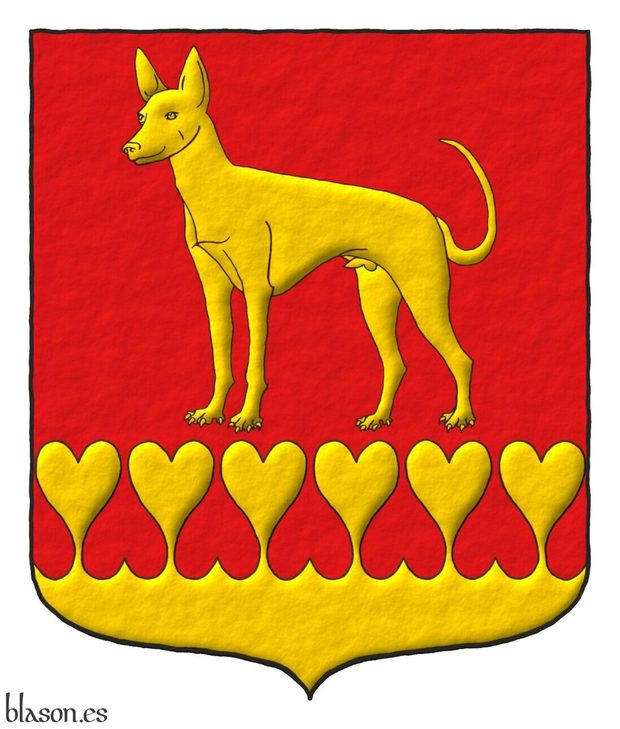
Gules: a warren hound parado statant Or; a base hearty Or.
Escudo de gules: un podenco parado de oro; la campaña encajada de corazones de oro.
Coat of arms that I have created with: the shield’s shape pointed and rounded; its field painted in flat tint gules; the warren hound and the base hearty are illuminated Or and delineated Sable; and the whole is executed in raised-line drawing.
Symbolism
A base made of generous hearts Or, interlocked with hearts Gules, red as blood, gives its support to a Spanish warren hound standing upon it. They are the hearts of those who love, protect and care for the hounds, intertwined with the hearts of the hounds whose noble heartbeats are evoked in the motto.
The founders of this Spanish warren hound shelter did not wish for a dog armed and langued, since those heraldic attributes would imply that the animal is not truly in need of protection. They preferred instead to highlight the podenco’s loyalty and faithfulness.
Types of lines of division
In English heraldry, ordinary lines of partition such as «almenado» ~ «embattled», «acanalado» ~ «invected», or «angrelado» ~ «engrailed» have well-established names. There is, however, no general rule for blazoning lines formed by repeated and more elaborate figures, such as fir trees, fleurs de lis, or other shapes.
Each case tends to receive a descriptive or newly coined term, such as «sapiné» or «flory» «flory counterflory», in these last two cases depending on whether the figures all point in one direction or alternate upward and downward.
Note that in «sapiné» the charm lies precisely in that alternation: the fir trees point alternately upward and downward, so that the figures interlock with each other.
Therefore, if a new figure appears, such as the heart in this case, with hearts pointing upward, one might say «hearty» or, more specifically, «hearty counterhearty»; but following the example of «sapiné», we shall simply blazon «hearty».
For example, the line formed by dovetail shapes, called «dovetailed» in English, is blazoned in Spanish as «encajada de colas de milano», even changing the name of the bird. Note that in this case they interlock precisely because some point upward and others downward, hence their use in joinery, cabinetry, and related arts.
In Spanish there are classical terms for the most common forms, such as «almenado», «acanalado» or «angrelado», with «encajado» ~ «dancetty» being perhaps the most characteristic, where the angles interlock alternately upward and downward.
When facing new or uncommon shapes, instead of inventing a new term we prefer to use the basic one, «encajado», adding afterwards the specific figure that forms the interlock, for example, «encajado de abetos» ~ «sapiné».
Thus, in this case we blazon «the base hearty», with the hearts alternating upward and downward, just as in the traditional «encajado» the angles alternate both ways.
Blazon keywords: Without divisions, Gules, Or, Warren hound, Dog, Base, Base (lower 1/3), Dancetty and Heart.
Style keywords: Ogee, Illuminated, Outlined in sable and Freehand.
Classification: Created, Socioeconomic, Design rationale, Criterion and Coat of arms.
Bearer: Latidos Podencos.


Laydin, lineage

Azure, five flies in saltire Or.
Escudo de azur, cinco moscas puestas en sotuer de oro.
Arms painted by me, highlighted with lights and shadows, contoured in Sable, with an ogee outer contour and with a freehand finish.
This is the coat of arms of the lineage Laydin emblazoned by me, as described in [Cadenas y Vicent, V. de; 1987; page 989], whose blazon is equivalent to that of the Zendreros lineage, also described in [Cadenas y Vicent, V. de; 1987; page 1941].
Blazon keywords: Azure, Or, Five, Fly and In saltire.
Style keywords: Outlined in sable, Illuminated, Ogee and Freehand.
Classification: Personal, Lineage, Interpreted, Boa and Coat of arms.
Bearer: Laydin, lineage.


Lazaro of Aragon, lineage

Gules, a castle triple-towered Or, masoned Sable, issuant from its port a dragon passant Vert, in chief a pelican in her piety Argent, vulned Gules.
Escudo de gules, un castillo de oro, mazonado de sable y saliendo por su puerta un dragón pasante de sinople, en jefe un pelícano desplegado de plata, la piedad de gules.
Coat of arms interpreted by me, highlighted with lights and shadows, outlined in Sable, with a semi-circular outer contour and with a freehand finishing.
Ancient arms of the lineage Lazaro of Aragon emblazoned by me.
Blazon keywords: Gules, Or, Vert, Argent, One, Castle, Triple-towered, Masoned, Issuant (port), Dragon, Passant, In chief, Pelican in her piety and Pelican.
Style keywords: Outlined in sable, Illuminated, Semi-circular and Freehand.
Classification: Personal, Lineage, Interpreted, Boa and Coat of arms.
Bearer: Lazaro of Aragon, lineage.


Leonor Plantagenet and Alfonso VIII
[ Gules, a castle triple towered Or, port and windows Azure, masoned Sable ] accolé with [ Gules, three lions, passant, guardant, in pale Or, armed and langued Azure ].
[ Escudo de gules, un castillo de oro, aclarado de azur, mazonado de sable ] acolado de un [ escudo de gules, tres leopardos en palo de oro, armados y lampasados de azur ].
Arms of the King and Queen of Castile interpreted with: the escutcheons' shapes pointed and rounded; the field of each shield, the castle, and the three leopards enamelled in flat tints of Gules and metal Or, with windows, claws, and tongues in Azure; and the whole composition finished with a raised line technique.
[Medél, R.; 1846; page 38] provides a heraldic description of the leopard.
Blazon keywords: Without divisions, Gules, Or, Azure, Three, Leopard, Armed, Langued, In pale, Sable, One, Castle, Port and windows and Masoned.
Style keywords: Ogee, Plain tincture, Outlined in sable, Tilted shield and Freehand.
Classification: Interpreted, Personal, Accolé arms, House of Plantagenet, Kingdom of England and Kingdom of Castile.
Bearer: Leonor Plantagenet.


Leonor Princess of Asturias
![Leonor Princess of Asturias Quarterly: 1 Gules, a castle triple-towered Or, port and windows Azure, masoned Sable [for Castile]; 2 Argent, a lion rampant Purpure, armed and langued Gules, crowned Or [for Leon]; 3 Or, four pallets Gules [for Aragon]; 4 Gules, a chain orlewise, crosswise, and saltirewise Or, charged in the fess point with an emerald Vert [for Navarre]; enté en point Argent, a pomegranate proper, seeded Gules, slipped and leaved Vert [for Granada]; an inescutcheon Azure, three fleurs de lis Or, 2 and 1, a bordure Gules [for Bourbon]; the whole debruised by a label of three points Azure.](../escudo_armas/LeonorPA.21.CoA.TrazoAlzado.jpg)
Quarterly: 1 Gules, a castle triple-towered Or, port and windows Azure, masoned Sable [for Castile]; 2 Argent, a lion rampant Purpure, armed and langued Gules, crowned Or [for Leon]; 3 Or, four pallets Gules [for Aragon]; 4 Gules, a chain orlewise, crosswise, and saltirewise Or, charged in the fess point with an emerald Vert [for Navarre]; enté en point Argent, a pomegranate proper, seeded Gules, slipped and leaved Vert [for Granada]; an inescutcheon Azure, three fleurs de lis Or, 2 and 1, a bordure Gules [for Bourbon]; the whole debruised by a label of three points Azure.
Escudo cuartelado: 1o de gules, un castillo de oro, aclarado de azur, mazonado de sable [de Castilla]; 2o de plata, un león rampante de púrpura, lampasado y armado de gules, coronado de oro [de León]; 3o de oro, con cuatro palos de gules [de Aragón]; 4o de gules, una cadena puesta en orla, en cruz y en sotuer de oro, cargada en el centro de una esmeralda de sinople [de Navarra]; entado en punta de plata, una granada al natural, tajada de gules, tallada y hojada de sinople [de Granada]; un escusón de azur, tres flores de lis de oro, 2 y 1, una bordura de gules [de Borbón]; brisado de un lambel de tres pendientes de azur.
Arms emblazoned by me, illuminated with lights and shadows, contoured in Sable, with a semi-circular outer contour and with a freehand finishing.
This is the coat of arms of Her Royal Highness Doña Leonor Princess of Asturias, Princess of Girona, and Princess of Viana, heiress of the throne of Spain as the elder daughter of King Felipe VI and Queen Letizia. This version of her coat of arms has been emblazoned by me. The coat of arms of the Princess of Asturias is the same as her father's, the King, but with a mark of cadency which, in heraldic terms, is also know as brisure. In this case, the cadency mark is a label Azure with three points, which will be removed in due course. The label of three points is the main and most classic of the brisures, usually assigned to the eldest heir. It is said to originate from a piece of cloth the son would tie at the top of his shield to distinguish it from his father's. Other common brisures include the crescent, the mullet of five point, the marlet, the annulet, or the fleur de lis. In addition to these simple brisures, there are also combined brisures, which are brisures charged with another or others. For example, a crescent charged with a fleur de lis. Labels may also have their points charged with other marks. Many cadency systems become more complicated as generations progress and branches open up, so they tend to be rarely used except in very clear cases like this one.
Blazon keywords: Gules, Azure, Purpure, Vert, Or, Argent, One, Three, Four, Quarterly, Castle, Triple-towered, Port and windows, Masoned, Lion, Rampant, Crowned, Pallet, Chain, Orlewise, Crosswise, Saltirewise, Charged, In the fess point, Emerald, Enté en point, Pomegranate, Proper, Slipped, Leaved, Inescutcheon, Fleur de lis, Ordered, Bordure, Cadency and Label of three points.
Style keywords: Outlined in sable, Illuminated, Semi-circular and Freehand.
Classification: Personal, Kingdom of Spain, Interpreted, Boa and Coat of arms.
Bearer: Leonor Princess of Asturias.


Lindsay of the Byres, lineage

Gules, a fess chequey Azure and Argent, in chief three mullets of five points Argent.
Escudo de gules, una faja ajedrezada de azur y plata, en jefe tres estrellas de cinco puntas de plata.
Arms interpreted by me, highlighted with lights and shadows, outlined in Sable, with a semi-circular outer contour and with a freehand finish.
Coat of arms of the lineage Lindsay of the Byres. I have emblazoned it with a fess chequy of 3 rows, symmetric and with 9 columns of squares, provided that its height is 1/3 of the width of the coat of arms.
Blazon keywords: Gules, Azure, Argent, One, Three, Nine, Fess, Chequey, In chief and Mullet.
Style keywords: Outlined in sable, Illuminated, Semi-circular and Freehand.
Classification: Personal, Lineage, Interpreted, Boa and Coat of arms.
Bearer: Lindsay of the Byres, lineage.


Lineage Mark of Germany, schema 1x2
Or, a fess chequey Gules and Argent.
Coat of arms of the lineage Mark of Germany. Symmetrical geometry of a fess chequey of 3 traits: a) The height of the fess is 1/3 of the width of the coat of arms. b) The fess is chequey with 3 traits. c) Therefore, the height of each trait is calculated as 1/3 x 1/3 = 1/9 of the width of the coat of arms. d) In a square, the height is equal to the width. e) Consequently, the width of each square in the chequey is also 1/9 of the width of the coat of arms. f) The first trait must contain 9 squares, as the width of the fess allows for an exact division into 9 equal squares, 9 being an odd number. g) If the first square is Gules, the last square of the same row will also be Gules, ensuring symmetry in the design.
Blazon keywords: Or, Gules, Argent, One, Three, Nine, Fess and Chequey.
Style keywords: Ratio, Outlined, Outlined in sable, Plain tincture, Illuminated, Semi-circular and Freehand.
Classification: Personal, Lineage, Interpreted, Schema, Boa and Coat of arms.
Bearer: Mark of Germany, lineage.


Lineage Peraza of Cantabria, structured and parallel blazons
Ancient arms of the lineage Peraza of Cantabria emblazoned by me, with the blazon written in English and Castilian in a structured way to observe the parallelism between both forms.
Blazon keywords: Or, Vert, Sable, Holm oak, Eradicated, Fructed, In front (tree), Trunk, Boar, Passant and In pale.
Style keywords: Outlined in the field tincture, Illuminated, Semi-circular and Freehand.
Classification: Personal, Lineage, Interpreted, Structured and parallel blazons, Boa and Coat of arms.
Bearer: Peraza of Cantabria, lineage.


Lineage Rothstein

Gules, two chevronels, in chief three mullets Argent. Motto: «Semper Supra».
Escudo de gules, dos tenazas de plata, en jefe tres estrellas todo de plata. Lema: «Semper Supra».
Arms painted by me, highlighted with lights and shadows, outlined in Sable, with a pointed external shape and with a freehand finish.
Blazon keywords: Gules, Argent, Two, Three, Chevronel, In chief, Mullet and Motto.
Style keywords: Outlined in sable, Illuminated, Pointed and Freehand.
Classification: Personal, Lineage, Interpreted, Boa and Coat of arms.
Bearer: Rothstein, lineage.


Lobo, María

Argent, five wolves passant Sable; a bordure Azure, charged with eight saltires couped Or.
Escudo de plata, cinco lobos pasantes de sable; una bordura de azur, cargada de ocho aspas de oro.
Arms emblazoned by me, highlighted with lights and shadows, contoured in Sable, with an ogee outer contour and with a freehand finishing.
Coat of arms of María Lobo, Lady of the House of Alvito. This coat of arms has been emblazoned by me. The arms are traditionally associated with the Lobo family of Alvito and are documented in Castilian and Portuguese heraldic and genealogical sources. These arms were equally used by other members of the House of Alvito, such as Ruy Dias Lobo and his descendants. I have emblazoned this coat of arms at the request of Fernando Durán Cabral de Mello d’Alpoim, as he counts the Lobo lineage of Alvito among his ancestors. It is not necessary to say the arrangement of the wolves which is in saltire, that is, 2, 1 and 2, since it is the default arrangement in heraldry for 5 equal charges.
Blazon keywords: Argent, Sable, Azure, Or, Five, Eight, Wolf, Passant, Bordure, Charged, Saltire and Couped.
Style keywords: Outlined in sable, Illuminated, Ogee and Freehand.
Classification: Personal, Interpreted, Boa and Coat of arms.
Bearer: Lobo, María.


Logic, modus ponendo ponens and fess

Azure, Azure implies Vert, therefore Vert.
Or, on a fess ermine, a potent fesswise Gules, between in dexter a hurt, in sinister a pomme; in chief a hurt, in base a pomme.
Escudo oro, una faja de armiños, cargada de una potenza puesta en faja de gules, acompañada a la diestra de un roel de azur, a la siniestra de un roel de sinople; en jefe un roel de azur, en punta un roel de sinople.
Variant of the imaginary coat of arms of Logic with: a semicircular (round) base; its field and fess enameled with plain Or and Argent; the 4 pieces and the figure illuminated in Azure, Gules, and Vert and outlined in Sable; and the whole with a raised-stroke effect.
Blazon keywords: Without divisions, Fess, Or, Ermine, Azure, Vert, Gules, Hurt, torteau, pellet, pomme and golpe, Potent, Fesswise, In chief, In base and Between.
Style keywords: Illuminated, Outlined in sable and Freehand.
Classification: Created, Imaginary and Coat of arms.
Imaginary bearer: Logic.


Lory Santiago-Vazquez, structured and parallel blazons
The coat of arms of Lory Santiago-Vazquez emblazoned by me
Blazon keywords: Azure, Argent, One, Three, Party per fess, Wavy, Dolphin, Naiant and Escallop.
Style keywords: Outlined in sable, Illuminated, Pointed and Freehand.
Classification: Personal, Interpreted, Structured and parallel blazons, Boa and Coat of arms.
Bearer: Santiago-Vazquez, Lory.


Loubet del Bayle, Jean-Christophe

Or, a wolf passant Gules; on a chief Gules, three bells Or.
Escudo de oro, un lobo pasante de gules; en un jefe de gules, tres campanas de oro.
Coat of arms painted by me, highlighted with lights and shadows, outlined in Sable, with a semi-circular external shape and with a freehand finish.
The coat of arms of Jean-Christophe Loubet del Bayle emblazoned by me.
Blazon keywords: Or, Gules, One, Three, Wolf, Passant, Chief and Bell.
Style keywords: Outlined in sable, Illuminated, Semi-circular and Freehand.
Classification: Personal, Interpreted, Boa and Coat of arms.
Bearer: Loubet del Bayle, Jean-Christophe.


Malvin de Montazet, lineage of Languedoc
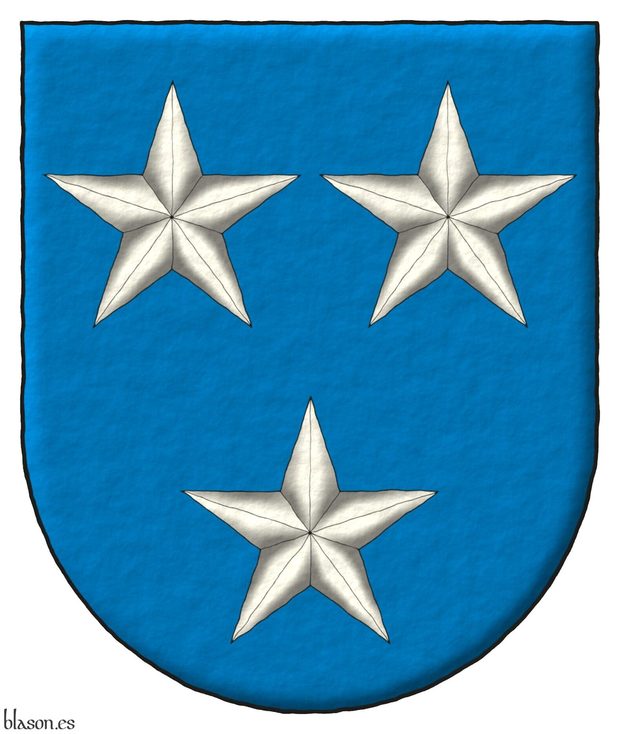
Blazon of the Malvin de Montazet lineage of Languedoc, France.
Azure, three mullets Argent, 2 and 1.
Illuminated and a freehand finishing.
Its French blazon «d'azur, à trois étoiles d'argent, 2 et 1» can be found at [Rietstap, J. B.; 1861; page 140].
Blazon keywords: Without divisions, Azure, Three, Mullet, Argent and Ordered.
Style keywords: Freehand, Outlined in sable, Illuminated and Semi-circular.
Classification: Interpreted, Lineage and Kingdom of France.


María Asunción de León González

Azure, a moon with human face environed by nine concentric annulets Argent.
Escudo de azur, una luna figurada circundada de nueve anilletes concéntricos, todo de plata.
Arms designed by me, highlighted with lights and shadows, outlined in Sable, with a rounded trapezoidal external shape and with a freehand finishing.
Blazon keywords: Azure, Argent, One, Nine, Moon, With human face, Environed, Concentric and Annulet.
Style keywords: Outlined in sable, Illuminated, Rounded trapezoid and Freehand.
Classification: Personal, Created, Boa and Coat of arms.
Bearer: María Asunción de León González.


Martin S. J. Goldstraw, tartan 3x3
Argent, on a chevron Gules three feathers Argent, between three swords erect Gules. Motto: «Ab Initio Goostrey».
This is the coat of arms of Martin Goldstraw emblazoned by me over his family tartan. This tartan was designed by Don Smith and is registered in the Scottish Register of Tartans, 2002.
Blazon keywords: Without divisions, Argent, Gules, Chevron, Charged, Sword, Point upwards, Ordered, Between, Quill and Motto.
Style keywords: Rounded, Illuminated, Outlined in sable and Freehand.
Classification: Interpreted, Personal, Cheshire County and Tartan.
Bearer: Goldstraw, Martin S. J..


Martos García, J. C., crest
Party per fess: 1 Gules, five swords erect, in fess Argent; 2 Vairy Or and Gules. Crest: Upon a helm with a wreath Or and Gules, a lion rampant Or, armed, langued, the fangs and the eyes Gules, grasping in its sinister paw a key Argent. Mantling: Gules doubled Or. Motto: «Veritas filia temporis» Gules over a scroll Argent.
Escudo cortado: 1o de gules, cinco espadas alzadas, en faja de plata; 2o verado de oro y gules. Timbrado de un yelmo, adornado de dos lambrequines de gules doblados de oro, un burelete de oro y gules, cimado de un león rampante de oro, armado, lampasado, fierezado y encendido de gules, teniendo en la siniestra una llave de plata. Lema: «Veritas filia temporis» de gules sobre una filacteria de plata.
Coat of arms with its crest made as follows: a pointed base; its two fields enamelled with flat inks, Gules and Or; the rest illuminated and outlined in Sable; the torse and mantling diapered with chinapiería; and the whole in raised-stroke.
Blazon keywords: Party per fess, Gules, Or, Argent, Five, Sword, Point upwards, In fess, Vairy, Crest and mantling, Helm, Mantling, Wreath, Crest, Lion, Rampant, Armed, Langued, The fangs, The eyes, Sinister, Grasping, Key and Motto.
Style keywords: Pointed, Illuminated, Outlined in sable and Freehand.
Classification: Created, Personal and Coat of arms.
Bearer: Martos García, Juan Carlos.


Mascarenhas, lineage of Portugal

Blazon of the Mascarenhas lineage of Portugal.
Gules, three bars Or.
Illuminated and a freehand finishing.
It can be found at [Cró, J. do; 1509; page 77].
Blazon keywords: Without divisions, Gules, Three, Fess and Or.
Style keywords: Freehand, Outlined in sable, Illuminated and Semi-circular.
Classification: Interpreted, Lineage and Kingdom of Portugal.


Maximilian Silvestri, structured and parallel blazons
The coat of arms of Maximilian Silvestri emblazoned by me.
Blazon keywords: Argent, Or, Gules, One, Demi, Savage, Carnation, Issuant, Base, Crined, Bearded, Vested, Tenné, Wreathed, Leaf, Grasping, Dexter, Closed book, Book, Bookmark, Garnished, Mortar, Pestle, Club, Leaved, Fructed, Chief and Wavy.
Style keywords: Outlined in sable, Illuminated, Semi-circular and Freehand.
Classification: Personal, Interpreted, Structured and parallel blazons, Boa and Coat of arms.
Bearer: Silvestri, Maximilian.


Mayrl, Kurth

Vert, an eagle displayed Argent, beaked, langued, membered and armed Gules; on a chief wavy Argent, three plantain plants issuant from the line of division Vert.
Escudo de sinople, un águila de plata, picada, lampasada, membrada y armada de gules; un jefe ondado de plata cargado de tres plataneras salientes de sinople.
Arms painted by me, highlighted with lights and shadows, contoured in Sable, and with a freehand finishing.
Blazon keywords: Vert, Argent, Gules, One, Three, Eagle, Displayed, Beaked, Langued, Membered, Armed, Chief, Wavy, Plantain plant, Issuant and Line of division.
Style keywords: Outlined in sable, Illuminated and Freehand.
Classification: Personal, Interpreted, Boa and Coat of arms.
Bearer: Mayrl, Kurth.


Melo, lineage
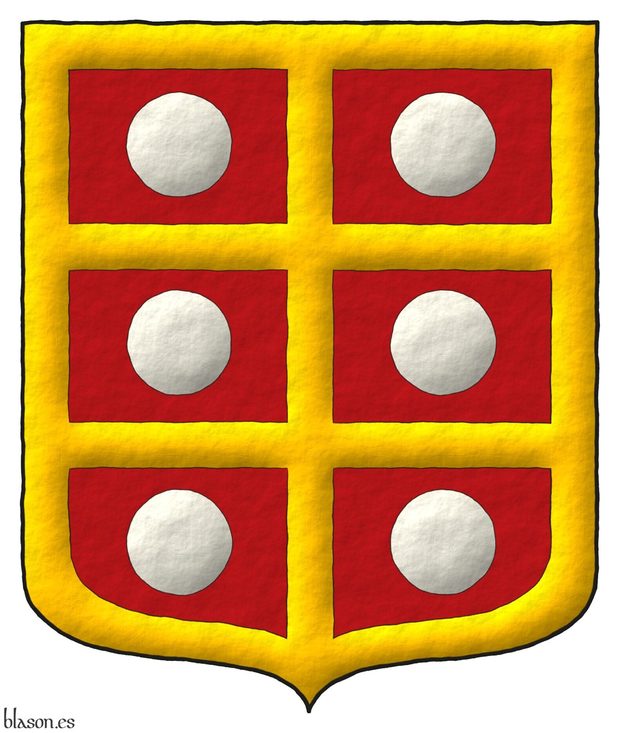
Gules, a double cross throughout Or cantoned by six plates, a bordure Or.
Escudo de gules, una cruz doble y plena de oro cantonada de seis bezantes de plata, una bordura de oro.
Coat of arms emblazoned by me, highlighted with lights and shadows, contoured in Sable, with an ogee outer contour and with a freehand finish.
Coat of arms of the lineage Melo. This coat of arms has been created for Fernando Durán Cabral de Mello d’Alpoim as a preparatory work for his armorial bearings where the arms of Melo are in the 4th quarter.
Blazon keywords: Gules, Or, Argent, One, Six, Double cross throughout, Cantoned, Plate and Bordure.
Style keywords: Outlined in sable, Illuminated, Ogee and Freehand.
Classification: Personal, Lineage, Interpreted, Boa and Coat of arms.
Bearer: Melo, lineage.


Michael W. Morgan, structured and parallel blazons
Coat of arms of Michael W. Morgan, UE, emblazoned by me, with the blazon written in English and Castilian in a structured way to observe the parallelism between both forms. He is the eldest son of Commander Stephen T. Morgan.
Blazon keywords: Or, Sable, Gules, Azure, Argent, One, Three, Griffin, Segreant, Chief, Invected, Naval crown, Cadency and Label of three points.
Style keywords: Outlined in sable, Illuminated and Freehand.
Classification: Personal, Interpreted, Structured and parallel blazons, Boa and Coat of arms.
Bearer: Morgan, Michael W..


Montesa, Cavalry Regiment

Coat of arms of the Armored Cavalry Regiment Montesa No. 3, RCAC-3, in 2016.
Or, a cross of Montesa.
Escudo de oro, una cruz de Montesa.
Coat of arms interpreted as follows: the shape of the shield is a semi-circular arch; the field has been illuminated in metal Or; the cross of Montesa is outlined in Sable and illuminated in Gules and Sable; and the whole has a raised line finish.
Blazon keywords: Without divisions, Or, Cross of Montesa, Cross couped and Cross.
Style keywords: Semi-circular, Illuminated, Outlined in sable and Freehand.
Classification: Interpreted, Military, Army and Navy and Coat of arms.
Bearer: Montesa, Cavalry Regiment.


![Ver [Montesa, Order of] en instituciones citadas. Fortaleza de oro y mazonada de sable.](../css/Fortaleza.Institucion.png)
Montesa, Order of

The Order of Saint Mary of Montesa and Saint George of Alfama, known as the Order of Montesa, was founded in the 14th century by the King of Aragon, James, as a military and religious order, to which he donated a castle in Valencia from which they took their name.
To endow the new Order of Montesa, the assets of the Order of the Templars, dissolved by Pope Clement V, were used. This is recounted by [Avilés, J.; 1780b; page 342] writing that Montesa was created «from the incomes and ruin of the Templars; as their Order was being extinguished, at the request of the Kings, so that said incomes would not leave the Kingdom.».
The order established within the Castle of Montesa, which previously belonged to the Templars, their convent and church of the Order, the palace of their Master, their barracks for fighting men, being able to form up to a couple of thousand of them in their parade ground. Their first Master, for 70 days since he died just over two months after his appointment, was Guillermo de Eril.
The origin and antiquity of the Military Order of Montesa, and the form of its Encomienda.
[Avilés, J.; 1780b; treatise IV, chapter VI, page 341] describes it as follows «The Military Order of Montesa was instituted in the year 1317 by the King of Aragon, Don Jaime II, and confirmed in the same year by Pope John XXII.».
Categories: Institution, Interpreted, Religious, Military, Illuminated, Outlined in sable, Freehand, Emblem, Cross of Montesa, Cross couped and Cross.


Navarre

Escudo de gules, un carbunclo cerrado, pomelado de oro; cargado en el centro de una esmeralda en forma de losange de sinople.
Original coat of arms of Navarre interpreted with: a semicircular (round) base; the field in flat Gules; the pommetty carbuncle illuminated in Or and outlined in Sable; the emerald illuminated in Vert and also outlined in Sable; and the whole finished with a raised-stroke effect.
In the armorial [Urfé; Siglo XV; indexed on folio 151, but actually written on 142] the arms of Navarre are blazoned in French as «de gueles à l'escarboucle d'or pommelée alumée de sinoble en la moyenne en guise d'esmeraude», it only gives the blazon, since this armorial is not illustrated.
An image of the original French blazon text can be seen in the article Blazon of Navarre in the Urfé armorial.
The interpretation of the arms of Navarre shown here is based on the one illustrated in the armorial [Bosque, J. del; 1540; folio 1 of the 1613 numbering], which is its main plate, with the arms of the king of Navarre surrounded by the coats of arms of the lineages and manors of his «ricoshombres», twelve lineages in total.
In [Menéndez Pidal de Navascués, F.; 1963] one can consult his view on what is, probably, the real origin of the arms of Navarre, which he bases on:
- The existence of a defensive element of the shield called the boss, placed at its center. This element already existed in classical Rome, on the shields of the legionaries and, in addition, it could serve to keep small valuables inside.
- The later reinforcement of this boss with 8 spokes, that is, 4 diameters set vertically, horizontally, bendwise and bendwise sinister, giving rise to a radiated boss to strengthen the shield.
- This radiated boss on rich shields could be very elaborate and even be adorned with gems, thus becoming an ornamental element.
- The evolution of the radiated boss from a defensive and ornamental element to the so-called carbuncle, but now as a heraldic element with a radial structure. Originally the carbuncle was a mystical stone, comparable to the ruby, that emitted an intense light capable of illuminating the knight in the darkness of night. Heraldically the name carbuncle is used to denote a scheme of radial rays and not the marvellous stone that emitted them and from which it borrows its name.
- This eight-rayed carbuncle, joined at the ends forming a closure, like an orle, and decorated with pommels, on a field Gules, and with an emerald overall at its center is what constitutes the arms of Navarre.
Regarding the importance of the radiated boss and the carbuncle, not only in the arms of Navarre but in heraldry in general, [Menéndez Pidal de Navascués, F.; 1963] goes a step further when he writes «although it has never been pointed out, it seems evident to us the influence of this piece on the classic partitions of the shield, contained in the four diametral lines that compose it». He makes us see that «cortado, partido, tronchado y tajado» and, therefore also, «cuartelado, en sotuer y jironado», do not have their origin in the different ways of striking a shield with a sword, as illustrated, for example, in [Avilés, J.; 1725a; plate 18, illustrations 23, 24, 25 and 25], but in different ways of selecting, as delimiters, the four diameters of the carbuncle.
Blazon keywords: Without divisions, Gules, One, Carbuncle, Pommelled, Or, Charged, In the fess point, Emerald, Vert and Lozenge.
Style keywords: Freehand, Illuminated and Outlined in sable.
Classification: Interpreted, Civic and Coat of arms.
Bearer: Navarre.


Nicholas Malmains

Nicolás Malmains ~ Nicholas Malmains ~ Nicol Malemeins.
Gules, three dexter hands turned up, and appaumée Ermine.
Escudo de gules, tres manos diestras levantadas y apalpadas de armiños.
Included in [Vincent, MS; 1285; number 622] also known as [St. George's Roll; 1285; number 622].
Blazon keywords: Without divisions, Gules, Three, Hand, Dexter, Ermine, Turned up, Appaumée and Ordered.
Style keywords: Semi-circular, Illuminated, Outlined in sable and Freehand.
Classification: Interpreted and Personal.
Bearer: Nicolás Malmains.


Norsk Heraldisk Forening, coat of arms

Gules, two axes addorsed Argent, hafted Or, issuant from the base; overall, at the nombril, an escutcheon Or.
Escudo de gules, dos hachas adosadas de plata, fustadas de oro, movientes de la punta; brochante sobre el todo, en el ombligo, un escudete de oro.
Interpretation I have made with the following characteristics: the escutcheon is semicircular, in the classic Castilian style; its field is illuminated with the tincture gules; its 2 axes and escutcheon are outlined in sable and illuminated with the metal Or, and the axe heads in Argent; and the execution is in a raised line style.
Hafted or shated
The term «hafted» in English is specifically used for weapons with handles, such as axes and hammers. This refers to the part of the weapon where the user grips, which is typically made of wood or metal and is essential for wielding the weapon effectively. The haft is integral to the weapon's function, providing the necessary leverage and control during use.
On the other hand, «shafted» is a term used in English for weapons with a shaft, which is a longer, slender part of the weapon, as seen in spears, arrows, and sometimes in lances. The shaft is usually the primary structural component, providing the length and reach, while also serving as the backbone of the weapon.
In both cases, the term indicates that this part of the weapon is of a different tincture from the rest of the figure.
In Castilian, however, both «hafted» and «shafted» translate to «fustadas», which broadly refers to a similar concept where the handle or shaft is of a different color than the head or blade.
Then, I prefer using «hafted» when referring to axes and hammers due to the specificity of the term in English.
This contrasts with the term «guarnezidas» ~ «hilted», which is used for swords, indicating a different color for the guard or hilt, rather than for the shaft or handle.
Addorsed, back to back
For the arrangement of the axes in relation to each other, the one on the dexter facing dexter, the one on the sinister facing sinister, I use the term «addorsed» as it is the most common, but I previously used «back to back», which is said of «two animals, rampant, with their backs against each other, each facing the opposite flank. Two keys are also described as back to back when they are positioned with the bits outward, each to its side; the same applies to sickles, or scythes and generally to all long objects that have two faces, like two axes...» [Avilés, J.; 1780a; page 98], this being the case for the axes in this shield.
«Dalla» is a synonym for «scythe» used in and originating from Aragon and Navarra, [Real Academia Española; 2001].
In the English blazon, «adosadas», «de espaldas», is rendered as «addorsed», from the French «adossé», which is said, for example, when «two animals turned back to back» and some also use «endorsed».
Blazon keywords: Without divisions, Gules, Axe, Argent, Hafted, Or, Addorsed, Issuant from base, Overall, At the nombril and Escutcheon.
Style keywords: Semi-circular, Illuminated, Outlined in sable and Freehand.
Classification: Interpreted, Socioeconomic and Coat of arms.
Bearer: Norsk Heraldisk Forening.


o-XI, video of the heraldic starmap
The starship of this video is based on the «Narcissus», the lifeboat of the «Nostromo», designed by Ron Cobb for the film «Alien». The music is «Also sprach Zarathustra», Opus 30, from Richard Strauss, interpreted by Kevin MacLeod.
Credits:
- Kevin MacLeod is the author of the music.
- Ron Cobb is the designer of the original starship.
Blazon keywords: Quarterly, Sable, Or, One, Letter, Two, Wolf, Passant, In pale, Number, Unicorn, Mullet and Compass rose.
Style keywords: Semi-circular and Freehand.
Classification: Video, Map, Created and Personal.
Bearer: Salmerón Cabañas, Antonio.


Ormazabal of the Basque Country, lineage

Or, a tower Gules, embattled, masoned and with a turret Sable.
Escudo de oro, una torre de gules, almenada, mazonada y donjonada de sable.
Coat of arms emblazoned by me, highlighted with lights and shadows, outlined in Sable, with a semi-circular outer contour and with a freehand finishing.
Ancient arms of the lineage Ormazabal of the Basque Country emblazoned by me.
Blazon keywords: Or, Gules, Sable, One, Tower, Embattled, Masoned and With a turret.
Style keywords: Outlined in sable, Illuminated, Semi-circular and Freehand.
Classification: Personal, Lineage, Interpreted, Boa and Coat of arms.
Bearer: Ormazabal of the Basque Country, lineage.


Orrantia of the Basque Country, lineage

Vert, a bend sinister Argent.
Escudo de sinople, una barra de plata.
Coat of arms emblazoned by me, illuminated with lights and shadows, outlined in Sable, with a semi-circular outer contour and with a freehand finishing.
Coat of arms of the lineage Orrantia of the Basque Country emblazoned by me.
Blazon keywords: Vert, Argent, One and Bend sinister.
Style keywords: Outlined in sable, Illuminated, Semi-circular and Freehand.
Classification: Personal, Lineage, Interpreted, Boa and Coat of arms.
Bearer: Orrantia of the Basque Country, lineage.


Oschoven of the Rhin
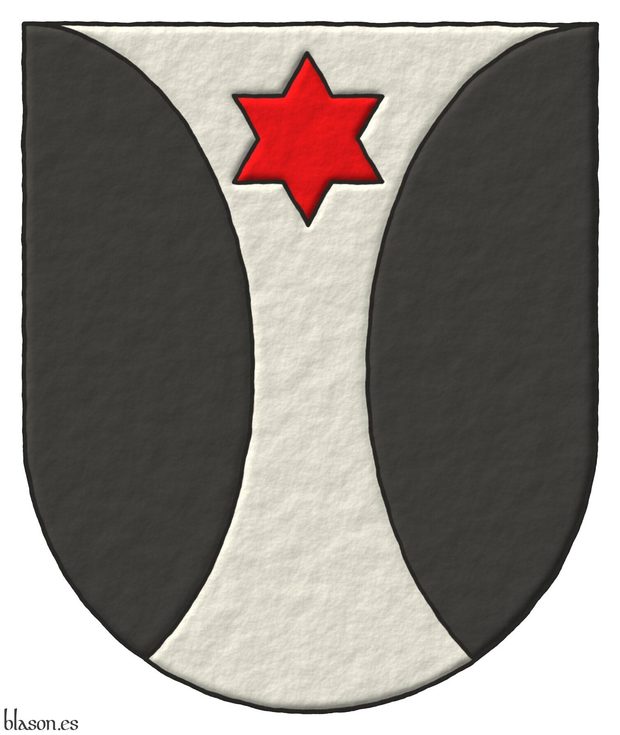
Argent, flanched Sable, in chief a mullet of six points Gules.
Escudo de plata, flanqueado curvo de sable, en jefe una estrella de seis rayos de gules
Coat of arms interpreted with: a semicircular (round) base; illuminated in the tinctures Argent, Gules, and Sable; all outlined in Sable; and finished with a raised-stroke effect.
[Avilés, J.; 1725a; pages 92 and figure 197] blazons it as «Argent, and a six-pointed star Gules in chief, flanched in oval Sable». When he illustrates it in [Avilés, J.; 1725a; figure 197], the space left between both flanches is only 1/5 of the base of the coat of arms; this is feasible because the only charge is a mullet in chief. If there were more charges, it would be necessary to leave more space, for example, 1/3 of the base of the shield.
«Oschoven au Rhein» in the book [Menestrier, C. F.; 1659; page 315], it is blazoned «d'argent flanqué arrondi de sable à vne molette de mesme en chef», so the mullet would be Sable, bacause «de mesme» is written, and with a hole in the middle, this hole does not exits in other sources.
In the book [Rietstap, J. B.; 1861], it is blazoned «Argent, flanched in round Sable, Argent charged in chief of a mullet Gules», and in French «d'argent, flanqué en rond de sable, l'argent chargé en chef d'une étoile de gueules».
Some time ago I used to blazon it in English as «Argent, in chief a mullet of six points Gules, between two flanches Sable».
Blazon keywords: Argent, Sable, Gules, Mullet, Chief and Flanched.
Style keywords: Semi-circular, Illuminated, Outlined in sable and Freehand.
Classification: Interpreted and Personal.
Bearer: Oschoven of the Rhin.


Osona, lineage
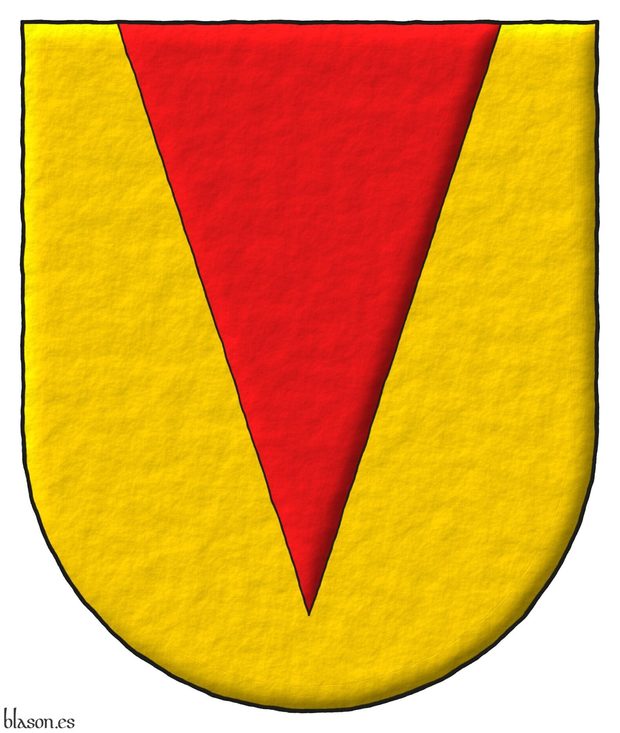
Or, a pile Gules.
Escudo de oro, una pila de gules.
Coat of arms emblazoned by me, illuminated with lights and shadows, contoured in Sable, with a semi-circular external shape and with a freehand finishing.
Coat of arms of the lineage Osona emblazoned by me based on the description by [Cadenas y Vicent, V. de; 1987; page 1325].
Blazon keywords: Or, Gules, One and Pile.
Style keywords: Outlined in sable, Illuminated, Semi-circular and Freehand.
Classification: Personal, Lineage, Interpreted, Boa and Coat of arms.
Bearer: Osona, lineage.


Philip of Castile, Infante

Quarterly: 1 and 4 Gules, a castle triple-towered Or, port and windows Azure, and masoned Sable; 2 and 3 Or, an eagle displayed Sable.
Escudo cuartelado: 1o y 4o de gules, un castillo de oro, aclarado de azur, mazonado de sable; 2o y 3o de oro, un águila de sable.
Arms painted by me, illuminated with lights and shadows, outlined in Sable, with an ogee external shape and with a freehand finish.
Coat of arms of the Infante Philip of Castile, 1231–1274, 7th offspring of the King Ferdinand III of Castile, 1199-1252, and the Queen Beatrice of Swabia, 1205–1235. This coat of arms has been emblazoned by me and can be consulted in [Messía de la Cerda y Pita, L.; 1990; page 146] with the field Or in the 2nd and 3rd quarters. He bears a quarterly shield combining the first quarter of his father’s arms, Castile, with his mother’s arms. Among all his siblings, he is the one who most closely combines the arms of both parents.
Blazon keywords: Gules, Or, Azure, Sable, One, Quarterly, Castle, Triple-towered, Port and windows, Masoned and Eagle.
Style keywords: Outlined in sable, Illuminated, Ogee and Freehand.
Classification: Personal, Kingdom of Castile and Leon, Interpreted, Boa and Coat of arms.
Bearer: Philip of Castile, Infante.


Quartered arms of Bernard de Tremelay

Quarterly: 1 and 4 Argent, a cross patty Gules; 2 and 3 Or, a chief Gules
Escudo cuartelado: 1o y 4o de plata, una cruz patada de gules; 2o y 3o de de oro, un jefe de gules.
Blazon keywords: Or, Chief, Gules, Quarterly, Argent, One, Cross patty and Cross couped.
Style keywords: Outlined in sable, Semi-circular, Illuminated and Freehand.
Classification: Religious, Military, Knights Templar, Interpreted and Coat of arms.
Bearer: Tremelay, Bernard de.


Quartered arms of Bertrand de Blanchefort

Quarterly: 1 and 4 Argent, a cross patty Gules; 2 and 3 Barry of four per pale counterchanged Or and Gules.
Escudo cuartelado: 1o y 4o de plata, una cruz patada de gules; 2o y 3o de contrafajado de cuatro piezas de oro y gules.
Blazon keywords: Barry per pale counterchanged, Four, Or, Gules, Quarterly, Argent, One, Cross patty and Cross couped.
Style keywords: Outlined in sable, Semi-circular, Illuminated and Freehand.
Classification: Religious, Military, Knights Templar, Interpreted and Coat of arms.
Bearer: Blanchefort, Bertrand de.


Quarterly Or and Argent and quarterly Gules and Argent, comparison
The rule of tincture, «metal should not be put on metal, nor color on color», is the most famous rule of the heraldry. In the divisions of the field, for example, party per fess, party per pale, quartered, etc., the tinctures are beside each other, not one on top of the other, because the divisions are not charges, so the rule of tincture does not apply. Although as a rule of aesthetics may be useful in the case of divisions.
Blazon keywords: Quarterly, Argent, Gules and Or.
Style keywords: Freehand, Outlined in sable, Plain tincture and Illuminated.
Classification: Schema.


Rage from Discord

Azure, two arrows in saltire points upward, the arrow bendwise Or, the arrow bend sinisterwise Argent, overall a double vajra per saltire Or and Argent charged with a bezant per saltire curved Or and Argent.
Escudo de azur, dos flechas alzadas en sotuer, la flecha puesta en banda de oro, la flecha puesta en barra de plata, brochante sobre el todo una vajra doble cuartelada en sotuer de oro y plata cargada de un bezante cuartelado en sotuer curvilíneo de oro y plata.
Coat of arms interpreted and emblazoned by me with different shapes and a freehand finishing.


Blazon keywords: Azure, Two, Arrow, Point upwards, In saltire, Bendwise, Or, Bend sinisterwise, Argent, Overall, One, Double vajra, Quarterly per saltire, Charged, Bezant and plate and Curved.
Style keywords: Outlined in sable, Illuminated, Freehand, Rounded, Ogee and Pointed.
Classification: Interpreted and Coat of arms.
Bearer: Rage from Discord.


![Ver [Registro Internacional de Armas Gentilicias] en instituciones citadas. Fortaleza de oro y mazonada de sable.](../css/Fortaleza.Institucion.png)
Registro Internacional de Armas Gentilicias

RIAG
Argent, a cross patty Gules, cantoned of four mullets of eight points Azure; on a chief Sable, an elephant passant Or.
The Registro Internacional de Armas Gentilicias, is also known as RIAG, and riag.com.es is it domain.
It is a private register of coat of arms founded in 2006 in Seville, Spain by the herald Ignacio Koblischek Zaragoza.
Categories: Institution, Socioeconomic, Semi-circular, Illuminated, Outlined in sable, Outlined in the field tincture, Freehand, Argent, Diminished cross, Patty, Gules, Cantoned, Mullet, Eight, Azure, Chief, Sable, Elephant, Passant and Or.


Reino de Portugal differenced by a baston Sable
![Reino de Portugal differenced by a baston Sable Argent, five escutcheons in cross Azure, each charged with five plates in saltire; a bordure Gules, charged with seven castles triple-towered Or, 3, 2, and 2 [for Portugal]; the whole debruised by a baston Sable.](../escudo_armas/PortugalR.39.Conopial.Brisado.TrazoAlzado.jpg)
Argent, five escutcheons in cross Azure, each charged with five plates in saltire; a bordure Gules, charged with seven castles triple-towered Or, 3, 2, and 2 [for Portugal]; the whole debruised by a baston Sable.
Arms emblazoned by me, highlighted with lights and shadows, outlined in Sable, with an ogee outer contour and with a freehand finish.
Coat of arms of the Kingdom of Portugal differenced by a baston Sable, as it appears in the arms of the House of Noronha. In the Arquivo Heráldico Genealógico of the Viscount Sanches de Baena this brisure is blazoned as «é por diferença um filete de negro sobreposto em banda», while in the Armaría Portuguesa it is described as «um filete negro em contrabanda». This latter term may be confusing, as «contrabanda» corresponds to the bend sinister, that is, the opposite diagonal. For the purpose of blazoning this coat of arms I use the heraldic term «baston» in English ~ «bastón» in Spanish ~ «bande batonnée» in French ~ «bastone» in Italian, denoting a bend reduced to 1/4 of its normal width. It should be recalled that the diminished bend properly speaking is the «bendlet», whose width ranges between 1/2 and 1/3 of that of the bend; the baston, being thinner, is therefore more suitable and proportionate for this shield. This coat of arms has been emblazoned for Fernando Durán Cabral de Mello d’Alpoim by me as a preparatory work for his armorial bearings. In that coat of arms, the inescutcheon of the House of Noronha bears this differenced Portugal arms in the 1st and 4th quarters.
Blazon keywords: Argent, Azure, Gules, Or, Sable, One, Five, Seven, Escutcheon, In cross, Charged, Plate, In saltire, Bordure, Castle, Triple-towered, Cadency and Baston.
Style keywords: Outlined in sable, Illuminated, Ogee and Freehand.
Classification: Civic, Interpreted, Boa and Coat of arms.
Bearer: Portugal, Reino de.


Renaud de Vichiers
Vair. Behind the shield an eight-pointed cross patty Gules.
Blazon keywords: Vair, Behind the shield, One, Eight-pointed cross, Cross couped and Gules.
Style keywords: Outlined in sable, Illuminated, Semi-circular and Freehand.
Classification: Religious, Military, Knights Templar, Interpreted and Coat of arms.
Bearer: Vichiers, Renaud de.


Reverend Nilda Ernestina Lucca de Anaya
Azure, a chevron Or, between in chief a cross potent cantoned of crosslets, and a lion rampant, and in base a Celtic Trinity knot Argent. Crest: A galero Sable, with two cords, each with one tassel Gules and Sable.
Credits: Ernesto Juan Anaya is the designer of the coat of arms and Antonio Salmerón y Cabañas is the author of the heraldic art.
Blazon keywords: Azure, One, Chevron, Or, Between, In chief, Cross of Jerusalem, Cross couped, Cross potent, Cantoned, Four, Crosslet, Lion, Rampant, In base, Celtic Trinity knot, Knot, Celtic, Trinity, Crest and mantling, Galero, Cord and Tassel.
Style keywords: Outlined in sable, Illuminated, Pointed and Freehand.
Classification: Religious, Interpreted and Coat of arms.
Bearer: Lucca de Anaya, Nilda Ernestina.


Rex Lancefield

Paly of six Gules and Argent; overall, a fess Or charged with a lance Gules. Motto: «Inter Primos».
Escudo palado de seis piezas de gules y plata; brochante sobre el todo, una faja de oro cargada de una lanza de gules. Lema: «Inter Primos».
Arms interpreted by me, illuminated with lights and shadows, outlined in Sable, with a chasuble outer contour and with a freehand finish.
Canting arms of Rex Lancefield emblazoned by me under the directions of his descendant Erik Paul Arnelien. I usually employ the English term «spear», but as this is a case of canting arms for Rex Lancefield, I have written the blazon in English using the term «lance» instead of «spear», since «Lancefield» begins with «lance».
Blazon keywords: Gules, Argent, Or, Six, One, Paly, Overall, Fess, Charged, Spear and Motto.
Style keywords: Outlined in sable, Illuminated, Chasuble and Freehand.
Classification: Personal, Interpreted, Boa and Coat of arms.
Bearer: Lancefield, Rex.


Ricardo de Mandeville, fretty of 3 + 3
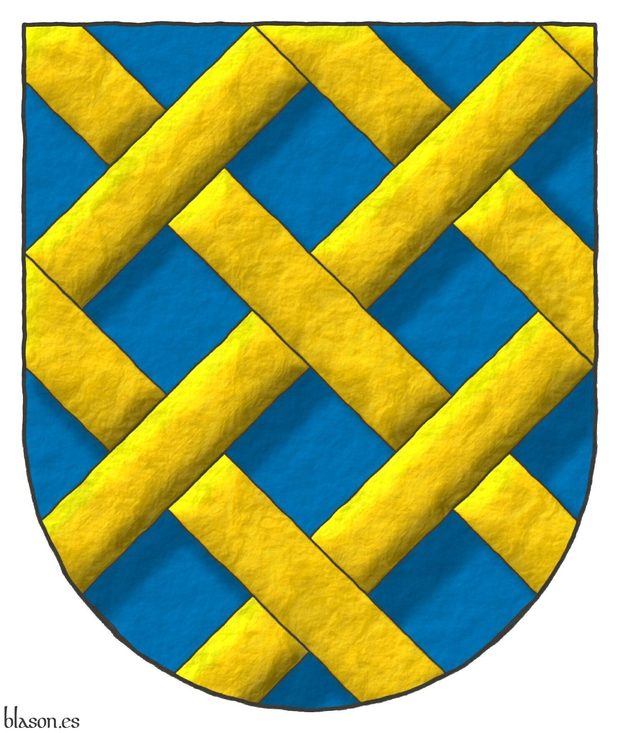
Azure fretty Or.
Escudo de azur fretado de oro.
Blazon keywords: Without divisions, Azure, Fretty and Or.
Style keywords: Semi-circular, Illuminated, Outlined in sable, Shaded, Freehand and Soft metal.
Classification: Interpreted and Personal.
Bearer: Ricardo de Mandeville.


Richard Allen Stowe, crest

Vert, a pall raguly Or between three leopards' faces Or. Crest: Upon a wreath Or and Vert, on a coronet Or a leopard's face Or between two wings Sable.
Escudo de sinople, una perla ecotada de oro entre tres cabezas de leopardo de oro. Timbrado de un burelete de oro y sinople surmontado de una corona de oro surmontada de una cabeza de leopardo de oro acompañada de dos medios vuelos de sable.
Watercolor finishing.
Blazon keywords: Vert, One, Pall, Raguly, Or, Three, Head, Leopard, Crest and mantling, Wreath, Above, Crown, Between, Two, Wing and Sable.
Style keywords: Illuminated, Freehand, Pointed and Outlined in sable.
Classification: Coat of arms, Interpreted and Personal.
Bearer: Stowe, Richard Allen.


Richard I of England

Lionheart ~ Corazón de León ~ Cœur de Lion.
Escudo de gules, dos leones de oro, afrontados, armados y lampasados de azur.
Coat of arms interpreted as follows: the mouth drawn as a semicircular (round) base; the field enamelled in a flat tint of Gules; the two lions outlined in the colour of the field and illuminated in Or and Azure; and the whole finished with a watercolour effect.
He was born in 1157, being the third of eight children of Henry II of England and Eleanor of Aquitaine, elder brother of Eleanor Plantagenet. He was king of England between 1189 and 1199, although he spent much of his life far from it; in fact, during his ten-year reign, he was on English soil only twice, which together did not amount even to six months. He died in 1199 in Normandy.
In 1198, during the Battle of Gisors, he supposedly used, as watchword or as motto, the expression «Dieu et mon Droit ~ God and my right». This phrase refers to his refusal to bow before Emperor Henry VI, since by his rank Richard acknowledged only God as superior. Later, Henry V of England adopted it as his motto, and since then it has been used by the British monarchy.
According to [Humphery-Smith, C.; 1983], Richard the Lionheart was the first English king who can be proved to have borne arms, although some of his predecessors may also have had them. He bases his statement on the existence of two seals of Richard I: on one, Richard bears a shield with a rampant lion, and on the other there already appear the three lions that are the forerunners of the arms of England. The use of this second seal does not imply that he stopped using the first.
In contrast, there are also British authors who maintain that his shield actually bore two affronted lions; this hypothesis is based on the lion on his first seal facing to sinister. That latter hypothesis is the one interpreted in this shield, remaining a purely artistic interpretation and without my entering into a complex and open discussion about how, when, and why the three leopards, «leones pasantes ~ lions passant» for the English, appeared —a discussion in which there are various alternatives— ranging from the combination of his hereditary arms to the wish to have more lions than his younger brother, who would later be King John I of England, to possible influences from other European realms.
This version of Richard I’s shield is similar to the imaginary shield of Hector of Troy, Gules with two lions Or affronté, which is a term used when «two things are placed facing each other, like two Lions, two Dogs, or other animals that look at one another» [Avilés, J.; 1725a; page 32].
Blazon keywords: Without divisions, Gules, Lion, Or, Combatant, Armed, Langued and Azure.
Style keywords: Semi-circular, Illuminated, Outlined in sable and Freehand.
Classification: Interpreted, Personal, Coat of arms, House of Plantagenet and Kingdom of England.
Bearer: Richard I of England.


Richard, Richard

Or, six annulets Gules, 3, 2, and 1.
Escudo de oro, seis anilletes de gules, ordenados 3, 2 y 1.
Coat of arms emblazoned by me with a semi-circular shape, illuminated, and with a freehand finishing.
Blazon keywords: Or, Six, Annulet, Gules, Ordered, Three, Two and One.
Style keywords: Outlined in sable, Semi-circular, Illuminated and Freehand.
Classification: Religious, Military, Knights Templar, Interpreted and Coat of arms.
Bearer: Richard, Richard.


Rivas of Aragon, lineage

Argent, on a cross Gules five fleurs de lis Or.
Escudo de oro, una cruz de gules cargada de cinco flores de lis de oro.
Arms depicted by me, illuminated with lights and shadows, contoured in Sable, with a semi-circular outer contour and with a freehand finish.
Ancient arms of the lineage Rivas of Aragon emblazoned by me. Alternative blazon: «Argent, a cross Gules charged with five fleurs de lis Or».
Blazon keywords: Argent, Gules, Or, One, Five, Cross, Charged and Fleur de lis.
Style keywords: Outlined in sable, Illuminated, Semi-circular and Freehand.
Classification: Personal, Lineage, Interpreted, Boa and Coat of arms.
Bearer: Rivas of Aragon, lineage.


Robert de Craon
Lozengy Or and Gules. Behind the shield a cross patty Gules.
Blazon keywords: Lozengy, Or, Gules, Behind the shield, One, Cross patty and Cross couped.
Style keywords: Outlined in sable, Illuminated, Semi-circular and Freehand.
Classification: Religious, Military, Knights Templar, Interpreted and Coat of arms.
Bearer: Craon, Robert de.


Robert de Malet
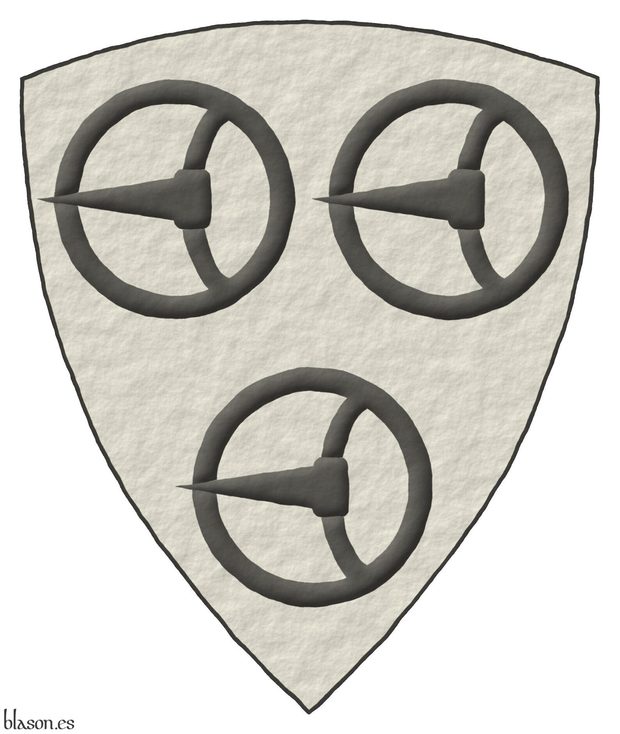
Roberto de Malet ~ Robert de Malet
Argent, three buckles Sable.
Escudo de plata, tres hebillas de sable.
Included in [Vincent, MS; 1285; number 595] also known as [St. George's Roll; 1285; number 595].
Blazon keywords: Without divisions, Argent, Three, Buckle, Sable and Ordered.
Style keywords: Triangular curved, Illuminated and Freehand.
Classification: Interpreted and Personal.
Bearer: Roberto de Malet.


Robert Sales
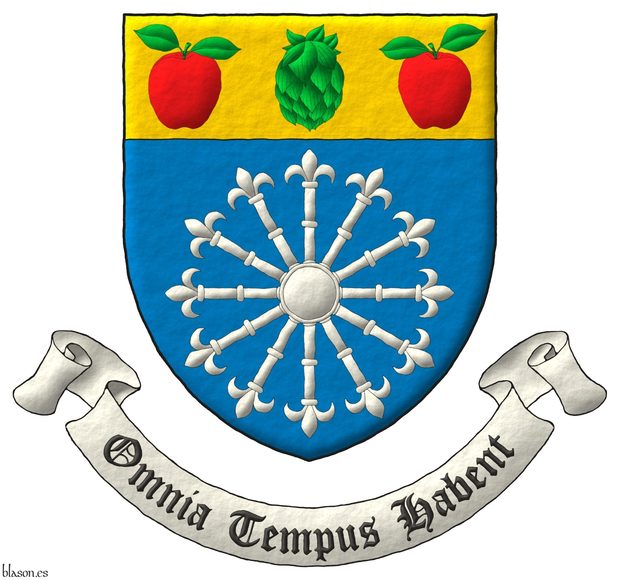
Azure, a carbuncle of twelve rays Argent; on a chief Or, a hop cone Vert between two apples Gules, slipped and leaved Vert. Motto: «Omnia tempus habent».
Escudo de azur, un carbunclo de doce rayos de plata; en un jefe de oro, una flor de lúpulo de sinople acompañada de dos manzanas de gules, talladas y hojadas de sinople. Lema: «Omnia tempus habent».
Blazon keywords: Azure, Carbuncle, Twelve, Argent, Chief, Or, Hop cone, Flower, Vert, Between, Two, Apple, Gules, Slipped, Leaved and Motto.
Style keywords: Outlined in sable, Illuminated, Pointed and Freehand.
Classification: Personal, Created, Coat of arms and Latin language.
Bearer: Sales, Robert Edward.


Rodelo lineage from Galicia

Gules, six wagon-wheels Or, 2, 2, and 2.
Escudo de gules, seis ruedas de carro de oro, 3 y 3.
Coat of arms emblazoned by me with a pointed ended shape, illuminated, and with a freehand finishing.
Another alternative way of writing this same blazon is the following: «Gules, six wagon-wheels Or, arranged in two pallets».
Blazon keywords: Gules, Six, Wagon-wheel and Or.
Style keywords: Outlined in sable, Illuminated, Freehand and Pointed.
Classification: Lineage, Interpreted, Canting and Coat of arms.
Bearer: Rodelo lineage from Galicia.


Royal arms of Scotland

Or, a lion rampant Gules, armed and langued Azure; a double tressure flory counterflory Gules.
Illuminated and a leather finishing.
This coat of arms can be seen in [Bergshammars; 1440; page 4] and in [Lutzelbourg, N. de; 1530; page 26].
Blazon keywords: Or, One, Lion, Gules, Armed, Langued, Azure, Double tressure, Flory and Counterflory.
Style keywords: Freehand, Outlined in sable, Plain tincture and Pointed.
Classification: Civic, Kingdom of Scotland, Interpreted and Coat of arms.
Bearer: Scotland.


Royal Association of Hidalgos of Spain, emblem

Emblem, two two-handed swords in saltire Argent, hilted Or. Crest: A royal crown Or.
Emblema, dos mandobles en sotuer de plata, guarnecidos de oro. Timbrado de una corona real.
Emblem interpretation with: the two-handed swords placed along the diagonals of an imaginary rectangle, with a 5x6 proportion, like a shield, that is, with angles of 50.2°, between the axis of the two-handed swords and the imaginary base of the emblem, unlike the original emblem where the two-handed swords are on the diagonals of a square, therefore with angles of 45°; the two-handed swords and the closed royal crown are outlined in Sable, illuminated and the whole with a raised-stroke execution.
This emblem of the Royal Association of Hidalgos of Spain has 2 two-handed swords that, unlike usual swords, due to their great length and weight, their fencing must be two-handed, hence their name.
The Spanish word «mandoble» comes from «mano doble», meaning «double hand», and refers to a sword wielded with both hands, the equivalent of the English «two-handed sword».
It is known that they are two-handed swords because the 2 that appear in the emblem have a crescent or crossguard in their iron. This crescent is called in Castilian «falsaguarda» and also «ganchos de parada» and its functionality is to protect from the slashes that the opponent could give close to the blade of the two-handed sword.
Blazon keywords: Two-handed sword, Argent, Hilted, Or, In saltire, Crest, Closed royal crown and Crown.
Style keywords: Illuminated, Outlined in sable and Freehand.
Classification: Interpreted, Socioeconomic and Emblem.
Bearer: Royal Association of Hidalgos of Spain.


Royal Council of the Orders of Chivalry, emblem

Royal Council of the Orders of Chivalry, of Santiago, Calatrava, Alcantara, and Montesa.
Emblem quarterly per saltire: 1, a cross of Saint James; 2, a cross of Calatrava; 3, a cross of Alcantara; 4, a cross of Montesa.
Emblema cuartelado en sotuer: 1o, una cruz de Santiago; 2o, una cruz de Calatrava; 3o, una cruz de Alcántara; 4o, una cruz de Montesa.
Interpretation of the emblem of the Royal Council with: its four crosses outlined in Sable, illuminated in Gules, Vert, and Sable; and a heavily hammered metal finish.
There is another version of this emblem of the Royal Council with the crosses of its four orders of Santiago, Calatrava, Alcantara, and Montesa outlined in Or instead of Sable.
Blazon keywords: Cross, Quarterly per saltire, Cross of Saint James, Cross couped, Cross of Calatrava, Cross of Alcantara and Cross of Montesa.
Style keywords: Illuminated, Outlined in sable and Freehand.
Classification: Interpreted, Socioeconomic and Emblem.
Bearer: Royal Council of the Orders of Chivalry.


![Ver [Royal Spanish Academy] en instituciones citadas. Fortaleza de oro y mazonada de sable.](../css/Fortaleza.Institucion.png)
Royal Spanish Academy

Emblem of the Royal Spanish Academy
Emblemb Argent, a crucible Argent, enflamed and on a bonfire hoguera Gules and Or.
Emblema de plata, un crisol de plata, llameante y sumado a una hoguera de gules y oro.
Painted by me with a raised-stroke finish, with an oval shape and with a thin golden edge around it which is purely ornamental.
The Royal Spanish Academy, also known by its acronym RAE, is made up of 46 full members, all elected for life to occupy seats designated by letters of the Spanish alphabet.
In addition to the full members, the Royal Spanish Academy also has corresponding members and other associated members, which completes its structure as the main regulatory institution of the Spanish language.
Categories: Institution, Interpreted, Socioeconomic, Oval, Illuminated, Outlined in sable, Freehand, Emblem, Without divisions, Argent, One, Crucible, Enflamed, Bonfire, Gules and Or.


Sancho of Castile, Infante

Party per pale: 1 Gules, a castle triple-towered Or, port and windows Azure, and masoned Sable; 2 Argent, a lion rampant Purpure, armed and langued Gules.
Escudo partido: 1o de gules, un castillo de oro, aclarado de azur, mazonado de sable; 2o de plata, un león rampante de púrpura, armado y lampasado de gules.
Arms emblazoned by me, highlighted with lights and shadows, contoured in Sable, with an ogee outer contour and with a freehand finish.
Coat of arms of the Infante Sancho of Castile, 1233–1261, 8th offspring of the King Ferdinand III of Castile, 1199-1252, and the Queen Beatrice of Swabia, 1205–1235. Unlike his siblings, he does not use a quarterly shield but rather impaled arms of Castile and Leon.
Blazon keywords: Gules, Or, Azure, Sable, Argent, Purpure, One, Party per pale, Castle, Triple-towered, Port and windows, Masoned, Lion, Rampant, Armed and Langued.
Style keywords: Outlined in sable, Illuminated, Ogee and Freehand.
Classification: Personal, Kingdom of Castile and Leon, Interpreted, Boa and Coat of arms.
Bearer: Sancho of Castile, Infante.


![Ver [Santiago, Order of] en instituciones citadas. Fortaleza de oro y mazonada de sable.](../css/Fortaleza.Institucion.png)
Santiago, Order of

The Order of Chivalry of Santiago is both military and religious. It was founded in the Kingdom of León during the 12th century, although there is a difference of opinion regarding its exact year of foundation. It is named after the patron saint of Spain, James the Greater.
The purpose of its foundation was the protection of the Way of Saint James and the pilgrims who traveled it, and to participate militarily in the advancement of the reconquest of the Iberian Peninsula.
Of the Military Order of Santiago of the Sword, of its origin, and antiquity, as well as the form of its Commandery
[Avilés, J.; 1780b; treatise IV, chapter II, page 325] writes «The oldest authentic instrument that is found regarding the origin of the Order of Chivalry of Santiago of the Sword», observe how José de Avilés e Iturbide refers to the order in the masculine form, «is the donation made in the years of 848», note how the Marquess of Avilés does not doubt the antiquity of this order and even in other subsequent paragraphs, he dates it even earlier than currently believed, «made to the Church of Santiago by the King of León Don Ramiro in memory of the famous victory he achieved against the Moors in the battle of Clavijo (two leagues from Logroño), as evidenced by its Privilege, for having seen this Holy Apostle armed and mounted on a Horse, fighting in defense of the Christians; to whose devotion, and in this recognition, the said Order was instituted, taking from it its origin and name, as well as the same Cross that the Saint bore on his chest, and Shield, represented in the form of a Sword, of red color», gules ~ red, «for the blood shed of the Infidels, of whom Don Rodrigo Ximenez, Archbishop of Toledo, in his Chronicle Book VII says»: «Kubet ensis sanguine Arabum».
Drawing with a single stroke
Cross of Saint James the Greater drawing by me with a single stroke. This is the reason why it is asymmetrical, it has the base tip crooked, there are some sides higher than others, and it shows the failure of my pulse in a certains turns.
It is by far my most downloaded and copied painting, the most used on websites, citing me or not, the most used in hotels advertising, parish sheets... and even on T-shirts.
Categories: Institution, Interpreted, Religious, Military, Illuminated, Outlined in sable, Freehand, Emblem, Cross of Saint James, Cross couped and Cross.


Savoy, Duchy of

Gules, a cross Argent.
Escudo de gules, una cruz de plata.
Coat of arms of the House of Savoy and the Duchy of Savoy, which I have interpreted as follows: the shield has a semicircular (round) base; the field is illuminated in flat tincture Gules; the cross is illuminated in Argent; and the whole coat of arms is rendered with a raised-stroke effect.
This coat of arms is both familial and political, for it is also the coat of arms of the French departments of Savoy and Haute-Savoie, both belonging to the Rhône-Alpes region.
The cross in this shield is an honourable ordinary, for it is a full cross, the result of combining a fess and a pale. This full cross is wide and reaches the edges of the shield and is therefore large enough to bear charges. For this reason these ordinaries are called “honourable,” because they may be honoured with additional charges. In English heraldry they are known as «ordinaries», [The Heraldry Society; 2013; page 11].
This coat of arms is recorded in the armorial [Marshal, L.; 1295; shield number 32] together with the text «Le Counte de Sauveys, Gules a cross argent, Amadeus V, Comte de Savoie».
Blazon keywords: Without divisions, Gules, Argent and Cross.
Style keywords: Semi-circular, Illuminated and Freehand.
Classification: Interpreted, Personal, Coat of arms and House of Savoy.
Bearer: Savoy, Duchy of.


Simon de Crombe

Simon de Croome ~ Simon de Crombe.
Argent, a Chevron Gules, on a Chief Gules, three escallops Argent, in fess.
Escudo de plata: un cabrio de gules; el jefe de azur, tres veneras de plata, en faja.
Included in [Vincent, MS; 1285; number 623] also known as [St. George's Roll; 1285; number 623].
The 3 escallops are in the chief then the description «in fess» are not really needed.
Blazon keywords: Without divisions, Argent, One, Chevron, Gules, Chief, Three, Escallop and In fess.
Style keywords: Semi-circular, Plain tincture, Outlined in sable and Freehand.
Classification: Interpreted and Personal.
Bearer: Simón de Croome.


Simon de Ver

Simon de Vere ~ Simon de Ver.
Gules, three cinquefoils Argent.
Escudo de gules, tres quinquefolios de plata.
Included in [Vincent, MS; 1285; number 85] also known as [St. George's Roll; 1285; number 85].
Blazon keywords: Without divisions, Gules, Three, Cinquefoil, Argent and Ordered.
Style keywords: Semi-circular, Illuminated, Shaded, Outlined in sable and Freehand.
Classification: Interpreted and Personal.
Bearer: Simón de Vere.


Sir Robert Knollys (1325-1407), first post
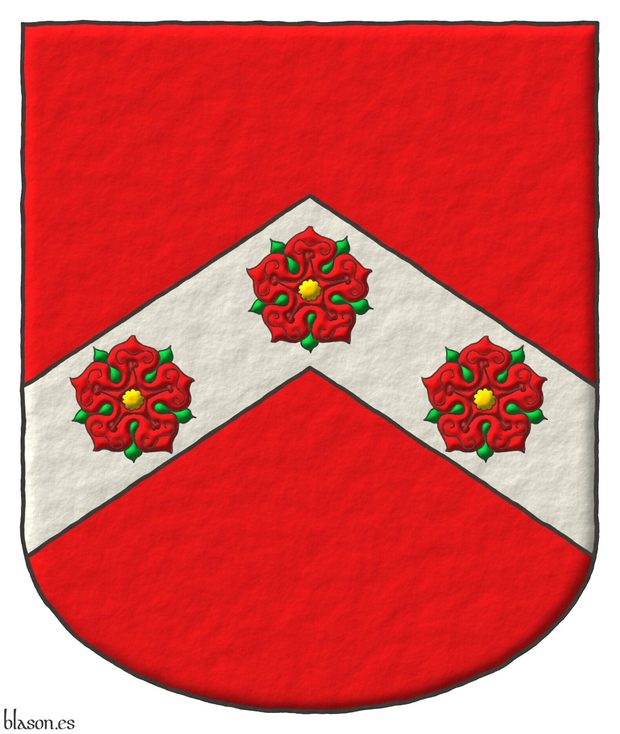
Sir Robert Knollys ~ Sir Robert Knolles (1325-1407).
Gules, on a chevron Argent three roses Gules, barbed Vert, and seeded Or.
Escudo de gules, un cabrio de plata cargado de tres rosas de gules, barbadas de sinople y botonadas de oro.
Coat of arms interpreted with: the rounded form; the field illuminated in Gules; the chevron illuminated in Argent metal and outlined in Sable; the roses illuminated in Gules, Vert and Or and outlined in Sable; and the whole with a raised-stroke effect.
Sir Robert Knollys was an English man-at-arms who was born in the County of Cheshire in 1325 and died in Sculthorpe, Norfolk, in 1407, and whose military career was framed within the Hundred Years' War between England and France.
Blazon keywords: Without divisions and Gules.
Style keywords: Rounded, Illuminated, Outlined in sable and Freehand.
Classification: Interpreted, Personal, Kingdom of England and Army and Navy.
Bearer: Knollys, Robert.


Sky, Laird

Party per chevron Vert and Or, in chief a sackbut fesswise Or, in base a thistle slipped and leaved proper.
Escudo de sinople, mantelado en punta de oro, en jefe un sacabuche de oro puesto en faja, en punta un cardo de sinople, florido de púrpura.
Illuminated, freehand finishing, and the inner of the thistle is outlined in the metal Or of its field.
Note the different way of writing the blazon in English and Castilian, «...a thistle slipped and leaved proper» ~ «...un cardo de sinople, florido de púrpura».
Blazon keywords: Vert, Party per chevron, Or, In chief, Sackbut, Fesswise, In base, Thistle, Leaved, Slipped and Proper.
Style keywords: Freehand, Outlined in sable, Outlined in the field tincture, Illuminated and Pointed.
Classification: Personal, Interpreted and Coat of arms.
Bearer: Sky, Laird.


Sneddon, Jon
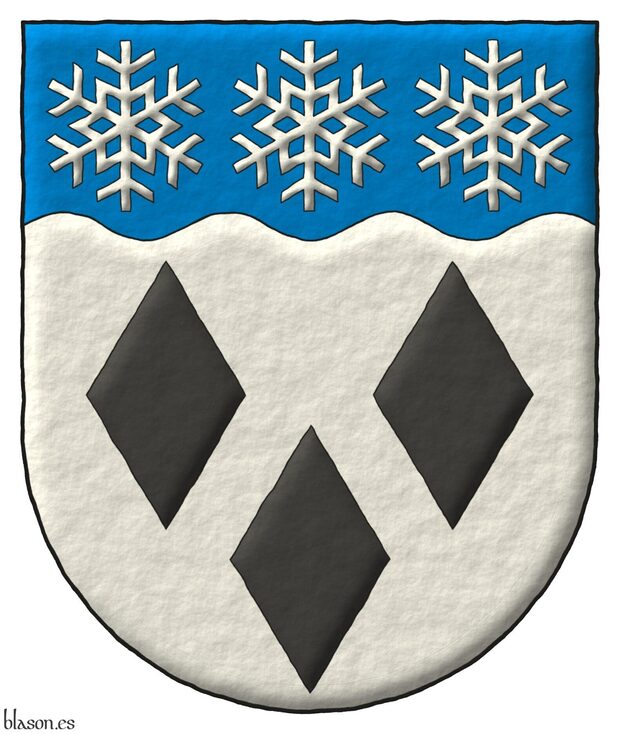
Argent, three lozenges Sable; on a chief wavy Azure, three snowflakes Argent.
Escudo de plata, tres losanjes de sable; en un jefe ondeado de azur, tres copos de nieve de plata.
Arms depicted by me, illuminated with lights and shadows, contoured in Sable, with a semi-circular external shape and with a freehand finish.
Coat of arms of Jon Sneddon emblazoned by me.
Blazon keywords: Argent, Sable, Azure, Three, Lozenge, Chief, Charged, Wavy, Snowflake and Ordered.
Style keywords: Outlined in sable, Illuminated, Semi-circular and Freehand.
Classification: Personal, Interpreted, Boa and Coat of arms.
Bearer: Sneddon, Jon.


Spain, Kingdom of
![Spain, Kingdom of Quarterly: 1 Gules, a castle triple-towered Or, port and windows Azure, masoned Sable [for Castile]; 2 Argent, a lion rampant Purpure, armed and langued Gules, crowned Or [for Leon]; 3 Or, four pallets Gules [for Aragon]; 4 Gules, a chain orlewise, crosswise, and saltirewise Or, charged in the fess point with an emerald Vert [for Navarre]; enté en point Argent, a pomegranate proper, seeded Gules, slipped and leaved Vert [for Granada]; an inescutcheon Azure, three fleurs de lis Or, 2 and 1, a bordure Gules [for Bourbon].](../escudo_armas/EspanaR.21.Escudo.TrazoAlzado.jpg)
Quarterly: 1 Gules, a castle triple-towered Or, port and windows Azure, masoned Sable [for Castile]; 2 Argent, a lion rampant Purpure, armed and langued Gules, crowned Or [for Leon]; 3 Or, four pallets Gules [for Aragon]; 4 Gules, a chain orlewise, crosswise, and saltirewise Or, charged in the fess point with an emerald Vert [for Navarre]; enté en point Argent, a pomegranate proper, seeded Gules, slipped and leaved Vert [for Granada]; an inescutcheon Azure, three fleurs de lis Or, 2 and 1, a bordure Gules [for Bourbon].
Escudo cuartelado: 1o de gules, un castillo de oro, aclarado de azur, mazonado de sable [de Castilla]; 2o de plata, un león rampante de púrpura, lampasado y armado de gules, coronado de oro [de León]; 3o de oro, con cuatro palos de gules [de Aragón]; 4o de gules, una cadena puesta en orla, en cruz y en sotuer de oro, cargada en el centro de una esmeralda de sinople [de Navarra]; entado en punta de plata, una granada al natural, tajada de gules, tallada y hojada de sinople [de Granada]; un escusón de azur, tres flores de lis de oro, 2 y 1, una bordura de gules [de Borbón].
Coat of arms painted by me, illuminated with lights and shadows, contoured in Sable, with a semi-circular external shape and with a freehand finishing.
Arms of the Kingdom of Spain emblazoned by me. Although in the official blazon text it is blazoned as a point vert, and as a point what is painted in a way that it is not known whether it is a large point or an uncutt circular emerald, in the blazon I have described it as an emerald both in Spanish and in English, since the point does not have a clear heraldic existence in Spanish and even less so in English.
Blazon keywords: Gules, Azure, Purpure, Vert, Or, Argent, One, Three, Four, Quarterly, Castle, Triple-towered, Port and windows, Masoned, Lion, Rampant, Crowned, Pallet, Chain, Orlewise, Crosswise, Saltirewise, Charged, In the fess point, Emerald, Enté en point, Pomegranate, Proper, Slipped, Leaved, Inescutcheon, Fleur de lis, Ordered and Bordure.
Style keywords: Outlined in sable, Illuminated, Semi-circular and Freehand.
Classification: Civic, Kingdom of Spain, Interpreted, Boa and Coat of arms.
Bearer: Spain, Kingdom of.


Structured blazon of the arms of Myriam Spiteri Debono
Personal coat of arms of Her Excellency Myriam Spiteri Debono, President of Malta, grant G0134 by Dr. Charles A. Gauci, Chief Herald of Arms of Malta. These arms have been emblazoned by me for this grant. This coat of arms has been emblazoned by me. I have written the blazon in English and Castilian in a structured way to observe the parallelism between both forms.
Blazon keywords: Or, Azure, Gules, Argent, Vert, Bleu celeste, One, Two, Three, Tierced per pale, Fess, Lion, Passant, Sword, Point upwards, Base, Tree, Eradicated, Proper, Sinister, Male figure, Loincloth, Spear, In chief, Mullet, In fess, Two hands clasped, Dagger, Hilted, In base, Sprig, Olive tree, Fesswise, Crest, Upon (wreath), Helm, Wreath, Escutcheon, Ensigned by, Wavy, Bar, Arch, Interlaced, Mantling, Rampant, Compartment, Motto, Surrounded, Decoration and Grand collar.
Style keywords: Outlined in sable, Illuminated, Pointed and Freehand.
Classification: Personal, Interpreted, Structured and parallel blazons, Boa and Coat of arms.
Bearer: Spiteri Debono, Myriam.


Talbot, lineage of England

Blazon of the Talbot lineage of England.
Escudo de gules, un león rampante dentro de una bordura angrelada todo oro.
Gules, a lion rampant within a bordure engrailed Or.
Illuminated with lights and shadows and with a freehand finish.
[Rietstap, J. B.; 1861] writes it in French as «de gueules, au lion d'or, à la bordure engrelée du même». y [Burke, J.; 1836; volume 3, pages 359-360] writes it in English as «Gu. a lion rampant, within a bordure engr. or».
Blazon keywords: Without divisions, Gules, One, Lion, Rampant, Within, Bordure, Engrailed and Or.
Style keywords: Freehand, Outlined in sable, Illuminated and Semi-circular.
Classification: Interpreted, Lineage and Kingdom of England.


Tercio Alessandro Farnese

Azure, a cross of Burgundy Or; an inescutcheon Or, six fleurs de lis in orle Azure.
Escudo de azur, una cruz de Borgoña de oro; un escusón de oro, seis flores de lis en orla de azur.
Coat of arms interpreted by me, illuminated with lights and shadows, contoured in Sable, with a semi-circular external shape and with a freehand finishing.
Coat of arms of the Tercio Alessandro Farnese, 4th of the Spanish Legion, emblazoned by me. In honor of Alessandro Farnese, the central inescutcheon bears in orle the 6 fleurs de lis of the Farnese family.
Blazon keywords: Azure, Or, One, Six, Cross of Burgundy, Cross couped, Inescutcheon, Fleur de lis and In orle.
Style keywords: Outlined in sable, Illuminated, Semi-circular and Freehand.
Classification: Military, Interpreted, Boa and Coat of arms.
Bearer: Tercio Alessandro Farnese.


The American College of Heraldry, blazon

Azure, a saltire between, in chief and in base, two thistle couped Argent; an inescutcheon Gules.
Escudo de azur, un sotuer acompanado, en jefe y en punta, de dos cardos de nuridos todo de plata; un escusón de gules.
Coat of arms interpreted with the following characteristics: the shape of its shield is semicircular; the field is a flat tint of Azure; the two thistles and the saltire are illuminated of the metal Argent and outlined in Sable; the inescutcheon is illuminated of the colour Gules and, also, outlined in Sable; and the whole with a mother-of-pearl finish with a raised stroke.
Inescutcheon ~ escusón
The English term «inescutcheon» corresponds to our Spanish term «escusón». It is called an inescutcheon when there is only one and it is placed in the abyss of the shield.
Escutcheon ~ escudete
The English term «escutcheon» corresponds to our Spanish term «escudete». It is used when there are several, for example, 3. Although in this case there is only one, this is the term used in the official blazon of this coat of arms, as will be seen below.
Thistle ~ cardo
This coat of arms of The Heraldry Society of Scotland was registered and granted ~ «granted» on 7th September 1977, by «The Court of the Lord Lyon», which is the official college of arms for Scotland, lyon-court.com, with the following blazon: «Azure, on a saltire argent between two thistles slipped argent, one in chief and one in base, an escutcheon gules» and it contains 2 thistles, which is the national flower of Scotland, and a saltire Argent on an Azure field, like the flag of Scotland.
Slipped ~ nurido
The usual way of representing the thistle ~ «thistle» in Castile is with its roots visible, it is called «arrancado». In this case the stem is cut and its roots are not visible, it is called «slipped» ~ «nurido».
Blazon keywords: Without divisions, Azure, Saltire, Argent, Thistle, Couped (tree), In chief, In base, Inescutcheon and Gules.
Style keywords: Illuminated, Outlined in sable, Iridescent (nacar), Freehand and Semi-circular.
Classification: Interpreted, Socioeconomic and Coat of arms.
Bearer: The Heraldry Society of Scotland.


The coat of arms of David Ryan Shorey in 3 steps
Sable, a dolphin naiant Or; a chief embattled Vert, fimbriated Or.
Blazon keywords: Sable, Dolphin, Naiant, Or, Chief, Embattled, Vert and Fimbriated.
Style keywords: Ogee, Outlined in sable, Plain tincture, Illuminated and Freehand.
Classification: Personal, Interpreted, Coat of arms and Schema.
Bearer: Shorey, David Ryan.


The coat of arms of Jacques de Molay in 3 steps
Azure, a bend Or.
Blazon keywords: Azure, One, Bend and Or.
Style keywords: Outlined in sable, Illuminated, Semi-circular, Plain tincture and Freehand.
Classification: Religious, Military, Knights Templar, Interpreted, Coat of arms and Schema.
Bearer: Molay, Jacques de.


The coat of arms of María Concepción Vallín de Lanzagorta in 3 steps
Gules, on a fess invected Argent, a lioness Azure, armed, langued and the udders Gules.
Blazon keywords: Gules, One, Fess, Invected, Argent, Charged, Lioness, Azure, Armed, Langued and Udder.
Style keywords: Semi-circular, Outlined in sable, Diapered, Plain tincture, Illuminated and Freehand.
Classification: Personal, Interpreted, Coat of arms and Schema.
Bearer: Vallín de Lanzagorta, María Concepción.


The coat of arms of Miguel Francisco Lanzagorta Escutia in 3 steps
Party per pale Vert and Azure, overall two cannons dismounted in saltire, between two seagulls volant in pale, and two fish naiant in fess Argent.
Blazon keywords: Party per pale, Vert, Azure, Overall, Two, Cannon dismounted, Cannon, In saltire, Between, Seagull, Volant, In pale, Fish, Naiant, In fess and Argent.
Style keywords: Semi-circular, Outlined in sable, Plain tincture, Illuminated and Freehand.
Classification: Personal, Interpreted, Coat of arms and Schema.
Bearer: Lanzagorta Escutia, Miguel Francisco.


The coat of arms of Nathaniel Bendel in 3 steps
Party per pale Azure and Or, a tree eradicated and blasted between two starlings respectant all counterchanged.
Blazon keywords: Party per pale, Azure, Or, One, Tree, Erased, Blasted, Counterchanged, Between, Two, Starling, Respectant and Counterchanged (side-by-side).
Style keywords: Ogee, Outlined in sable, Plain tincture, Illuminated and Freehand.
Classification: Personal, Interpreted, Coat of arms and Schema.
Bearer: Bendel, Nathaniel.


The coat of arms of Oratorio de San Felipe Neri in 3 steps
Argent, in chief an ecclesiastical cap Sable, in base a heart enflamed gules.
Blazon keywords: Argent, In chief, One, Ecclesiastical cap, Sable, In base, Heart enflamed, Heart, Enflamed and Gules.
Style keywords: Outlined in sable, Semi-circular, Plain tincture, Illuminated and Freehand.
Classification: Religious, Created, Coat of arms and Schema.
Bearer: Congregación del Oratorio de San Felipe Neri de Alcalá de Henares.


The coat of arms of Ralf Hartemink in 3 steps
Or, three puffins proper.
Blazon keywords: Without divisions, Or, Three, Puffin and Proper.
Style keywords: Pointed, Outlined in sable, Plain tincture, Illuminated and Freehand.
Classification: Personal, Interpreted, Coat of arms and Schema.
Bearer: Hartemink, Ralf.


The coat of arms of Stephan Urs Breu in 4 steps
Party per fess: 1 Argent, a rose Gules, barbed and seeded proper; 2 Gules, two swords in saltire Argent, hilted Or.
Blazon keywords: Party per fess, Argent, One, Rose, Gules, Leaved, Seeded, Two, Sword, In saltire, Hilted, Or and Vert.
Style keywords: Semi-circular, Outlined in sable, Plain tincture, Illuminated and Freehand.
Classification: Personal, Interpreted, Coat of arms and Schema.
Bearer: Breu, Stephan Urs.


The coat of arms of The Honourable Society of Lincoln's Inn in 3 steps
Azure semé of millrinds Or; on a dexter canton Or, a lion rampant Purpure, armed and langued Gules.
Coat of arms of The Honourable Society of Lincoln's Inn emblazoned by me in 3 steps: initial geometric scheme, colors and metals, and lights and shadows.
Blazon keywords: Azure, Semé, Millrind, Or, One, Canton, Dexter, Lion, Rampant, Purpure, Armed, Langued and Gules.
Style keywords: Pointed, Outlined in sable, Outlined in the field tincture, Plain tincture, Illuminated and Freehand.
Classification: Socioeconomic, Interpreted, Coat of arms and Schema.
Bearer: Lincoln's Inn, The Honourable Society of.


The coat of arms of Tim Wilkins in 3 steps
Party per bend sinister Or and Gules, a clenched gauntlet Sable.
Blazon keywords: Party per bend sinister, Or, Gules, Surmounted, Gauntlet, Sable and Palewise.
Style keywords: Pointed, Outlined in sable, Plain tincture, Illuminated and Freehand.
Classification: Personal, Interpreted, Coat of arms and Schema.
Bearer: Wilkins, Tim.


![Ver [The Heraldry Society] en instituciones citadas. Fortaleza de oro y mazonada de sable.](../css/Fortaleza.Institucion.png)
The Heraldry Society

Quarterly Azure and Gules; overall a leopard face, crowned Or, langued Gules, within a tressure flory Or.
TheHeraldrySociety.com was founded by John P. Brooke-Little, MA, FHS in 1947.
Its objetives are to increase and extend interest in and knowledge of heraldry, armory, chivalry, genealogy and allied subjects.
I am member of The Heraldry Society since 2014. As member, my coat of arms appears in their web site in the following address TheHeraldrySociety.com/membersarms/antoniosalmeron.htm.
Plain tincture and lights and shadows


Categories: Institution, Interpreted, Socioeconomic, Pointed, Illuminated, Outlined in sable, Freehand, Coat of arms, Quarterly, Azure, Gules, Overall, Head, Leopard, Crowned, Or, Langued, Within, Tressure and Flory.


Thomas Grenville, stone coat of arms
Coat of arms of Thomas Grenville sculpted in St Mary's Church, Bideford, Devon, United Kingdom.
Gules, three Clarions Or.
On a field of gules, three clarions of gold can be seen in the dexter canton of the base of the main shield of [Tewkesbury; Century XVII; folio 24r] and on 8 other coats of arms in this armorial.
Blazon keywords: Without divisions, Gules, Three, Clarion and Or.
Style keywords: Freehand, Plain tincture and Illuminated.
Classification: Interpreted, Kingdom of England and Photographic.
Bearer: Grenville, Thomas.


Thomas Roscelyn

Tomás Roscelyn Thomas ~ Roscelyn ~ Thomas Rocelin.
Gules, three buckles Argent.
Escudo de gules, tres hebillas de plata.
Included in [Vincent, MS; 1285; number 595] also known as [St. George's Roll; 1285; number 595].
Blazon keywords: Without divisions, Argent, Three, Buckle, Sable and Ordered.
Style keywords: Triangular curved, Illuminated, Outlined in sable and Freehand.
Classification: Interpreted and Personal.
Bearer: Tomás Roscelyn.


Triangulation

Chapé, embrassé, chaussé, and contre-embrassé.
There are 4 figures based on a triangle that, following the direction of the clock hands, have the following characteristics:
Chapé
The point of the central isosceles triangle is in the chief of the shield, like the clock hand pointing to 12:00, the base of the triangle is in the point of the shield. The field is the interior of this central isosceles triangle and its 2 adjacent right triangles are the charges. In the coat of arms for the triangulation that illustrates this article, the 6th quarter is chapé, its field is in plain tincture Vert and its 2 charges are illuminated in the metal Or, which is blazoned as «6 Vert, chapé Or».
Embrassé
The point of the central isosceles triangle is in the sinister of the shield, like the clock hand pointing to 3:00, the base of the triangle is in the dexter of the shield. The field is the interior of this central isosceles triangle and its 2 adjacent right triangles are the charges. In the coat of arms for the triangulation that illustrates this article, the 5th quarter is embrassé, its field is in plain tincture Azure and its 2 charges are illuminated in the metal Or, which is blazoned as «5 Azure, embrassé Or».
Chaussé
The point of the central isosceles triangle is in the point of the shield, like the clock hand pointing to 6:00, the base of the triangle is in the chief of the shield. The field is the interior of this central isosceles triangle and its 2 adjacent right triangles are the charges. In the coat of arms for the triangulation that illustrates this article, the 1st quarter is chaussé, its field is in plain tincture Vert and its 2 charges are illuminated in the metal Or, which is blazoned as «1 Vert, chaussé Or».
Contre-embrassé
The point of the central isosceles triangle is in the dexter of the shield, like the clock hand pointing to 9:00, the base of the triangle is in the sinister of the shield. The field is the interior of this central isosceles triangle and its 2 adjacent right triangles are the charges. In the coat of arms for the triangulation that illustrates this article, the 2nd quarter is contre-embrassé, its field is in plain tincture Azure and its 2 charges are illuminated in the metal Or, which is blazoned as «2 Azure, contre-embrassé Or».
Blazon keywords: Quarterly, Chapé, Chaussé, Embrassé, Contre-embrassé, Or, Argent, Vert and Azure.
Style keywords: Rounded, Illuminated, Outlined in sable and Freehand.
Classification: Imaginary.
Imaginary bearer: Triangulation.


Twist, Michael

Party per fess Argent and Or, in chief twenty one fleurs de lis Sable, 8, 7, and 6, in base, a stag passant Gules attired proper, holding in its mouth a sprig Vert, gorged with a wreath Argent and Or.
Escudo cortado de plata y oro, en jefe veintiuna flores de lis de sable, 8, 7 y 6, en punta un ciervo pasante de gules, ramado al natural, teniendo en su boca una ramita de sinople, colletado de un burelete de plata y oro.
Arms painted by me, illuminated with lights and shadows, contoured in Sable, with a pointed external shape and with a freehand finishing.
G0130, Chief Herald of Arms of Malta's grant of the coat of arms of Michael Twist, Malta. This coat of arms has been emblazoned by me.
Blazon keywords: Argent, Sable, Or, Gules, Vert, Twenty-one, One, Party per fess, In chief, Fleur de lis, Stag, Passant, Attired, Grasping, Sprig, Gorged and Wreath.
Style keywords: Outlined in sable, Illuminated, Pointed and Freehand.
Classification: Personal, Interpreted, Boa and Coat of arms.
Bearer: Twist, Michael.


Ukraine

Trident~Tryzub.
Azure, a Tryzub Or.
Interpreted coat of arms: with a rounded and pointed shape; illuminated with metals or and color azure; outlined with sable; and a Watercolor finish.
Blazon keywords: Without divisions, Azure, Trident and Or.
Style keywords: Ogee, Illuminated, Outlined in sable and Freehand.
Classification: Coat of arms, Interpreted, Civic and State of Ukraine.
Bearer: Ukraine.


Universidad Peñafort, emblazoned by me in 4 steps
Azure, in chief three keys in bend, fesswise, to dexter, facing downwards Or, in base an open book Argent, garnished Or, the pages inscribed «Ad usum per artes» Gules.
Blazon keywords: Azure, Three, Key, Or, In chief, In bend, Fesswise, Book, Open and Motto.
Style keywords: Plain tincture, Freehand, Outlined in sable and Illuminated.
Classification: Socioeconomic, Created, Schema and Coat of arms.
Bearer: Peñafort, Universidad.


Uschiolo and Ustiolo, lineages

Or, a port Or, with jambs, enarched lintel, and two open leaves, upon a three-step stairway Azure.
Escudo de oro, una puerta con jambas, dintel arqueado, dos hojas abiertas sostenida de una escalinata de tres peldaños todo de azur, aclarada de oro.
Arms painted by me, highlighted with lights and shadows, outlined in Sable, with an ogee external shape and with a freehand finish.
Coat of arms of the lineages Uschiolo and Ustiolo, emblazoned by me following the blazon published by Vittorio Gifra in Italian: «Arma: d’oro, alla porta di due ante a timpano arcuato d’azzurro, scalinata di tre pezzi del medesimo e aperta del campo».
Blazon keywords: Or, Azure, One, Two, Three, Port, Arched, Enarched, Upon, Step, Stairway and Port and windows.
Style keywords: Outlined in sable, Illuminated, Ogee and Freehand.
Classification: Personal, Lineage, Interpreted, Boa and Coat of arms.
Bearer: Uschiolo and Ustiolo, lineages.


Val'Quirico, the equestrian club's facilities, 1
Party per pale: 1 Azure, an angel Argent, crowned, crined and vested Or holding an open book Argent; 2 Or, three horses' heads couped, in pale Sable.
I had the honor of being commissioned to design and paint the coat of arms of the Val'Quirico Equestrian Center, in Tlaxcala state, Mexico.
Their facilities are finished and operational, they are magnificent, I have excited to see their photographs.
Blazon keywords: Party per pale, Azure, One, Angel, Argent, Crowned, Crown, Crined, Vested, Or, Charged, Book, Open, Three, Head, Horse, Sable, Couped and In pale.
Style keywords: Freehand, Illuminated, Rounded, Outlined in the field tincture and Outlined in sable.
Classification: Photographic, Created and Socioeconomic.
Bearer: Club Ecuestre Val'Quirico.


Vega Lanzagorta, Sister Esperanza
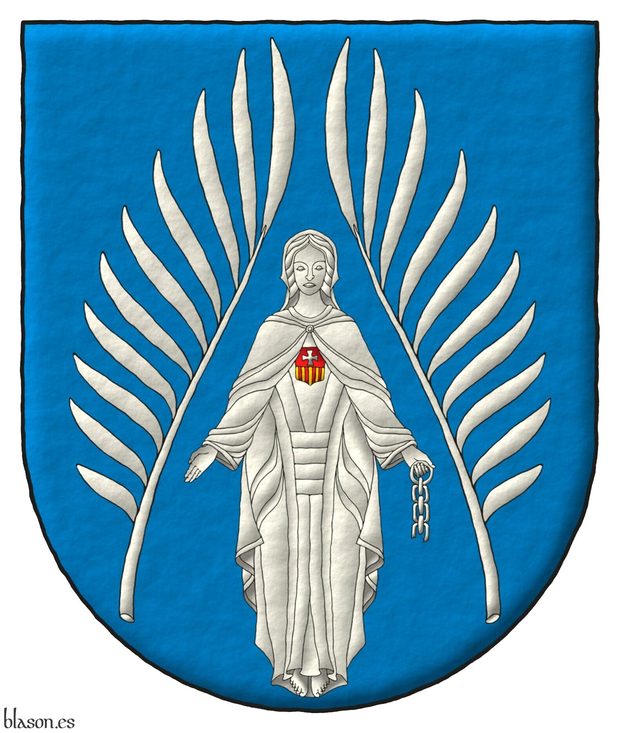
Azure, between two palm fronds in pile reversed a Lady of Mercy grasping in her sinister hand a broken chain Argent, and charged on the chest with an escutcheon per fess, 1 Gules, a cross patty Argent, and 2 Or, four pallets Gules.
Escudo de azur, una Virgen de la Merced teniendo en su mano siniestra una cadena rota de plata, y cargada en su pecho de un escudete cortado, 1o de gules, una cruz patada de plata y 2o de oro, cuatro palos de gules, acostada de dos hojas palmas en pira.
Arms designed by me, illuminated with lights and shadows, contoured in Sable, with a semi-circular external shape and with a freehand finishing.
This is the coat of arms of Sister Esperanza Vega Lanzagorta, designed by Juan Lanzagorta Vallin and painted by me. Usually, the English term «between» is translated into Castilian as «acompañado». However, when the 3 elements are elongated in the same direction, the appropriate term in Castilian is «acostado», which means lying down.
Credits: Juan Lanzagorta Vallin is the designer of the coat of arms.
Blazon keywords: Azure, Argent, Gules, Or, One, Two, Our Lady of Mercy, Grasping, Sinister, Hand, Broken, Chain, Charged, Chest, Escutcheon, Party per fess, Cross patty, Cross couped, Between, Palm frond and In pile reversed.
Style keywords: Outlined in sable, Illuminated, Semi-circular and Freehand.
Classification: Personal, Created, Boa and Coat of arms.
Bearer: Vega Lanzagorta, Sister Esperanza.


Vera, lineage of Aragon

Blazon of the Vera lineage of Aragon.
Vair ancient, a bordure gules charged with eight saltires couped Or.
Escudo de veros antiguos, una bordura de Gules cargada de ocho sotueres cortados de oro.
Illuminated and with a glass finish.
It can be consulted in [Mogrovejo de la Cerda, J.; 1636; cover].
[Friar, S.; 1987; pages 156-157] says of the vair: «originates from the fur of a species of squirrel... which was popular in the Middle Ages as a lining for the garments of those not entitled to wear ermine. The animal was blue-grey on the back and white underneath. By sewing a number of these pelts together, with white and blue-grey alternating,... one which easily translated into the stylized armorial form of Vair and its variants».
Blazon keywords: Vair ancient, One, Bordure, Gules, Charged, Eight, Saltire, Party per fess and Or.
Style keywords: Freehand, Outlined in sable, Illuminated and Semi-circular.
Classification: Interpreted, Lineage and Coat of arms.


Vermandois, County of

Chequey Or and Azure.
Escudo ajedrezado de oro y azur.
Arms interpreted by me, highlighted with lights and shadows, outlined in Sable, with a semi-circular outer contour and with a freehand finishing.
Coat of arms of the County of Vermandois, France, emblazoned by me.
Blazon keywords: Or, Azure and Chequey.
Style keywords: Outlined in sable, Illuminated, Semi-circular and Freehand.
Classification: Civic, Interpreted, Boa and Coat of arms.
Bearer: Vermandois, County of.


Vidriales, C. M.

Interpreted coat of arms: with a semi-circular shape; illuminated with metals argent and or and colors sable and azure; outlined with sable; and a freehand finish.
Blazon keywords: Party per pale, Argent, Cross, Sable, Bordure, Motto, Or, Thirteen, Hurt, Hurt, torteau, pellet, pomme and golpe, Azure, Three, In pale, Four, Five, Chief, Fleur de lis, Label and Suspended.
Style keywords: Freehand, Semi-circular, Illuminated and Outlined in sable.
Classification: Coat of arms, Interpreted and Personal.
Bearer: Vidriales, C. M..


Vidriales, M. P.

Interpreted coat of arms: with a semi-circular shape; illuminated with metals argent and or and colors sable and azure; outlined with sable; and a freehand finish.
Blazon keywords: Party per pale, Argent, Cross, Sable, Bordure, Motto, Or, Thirteen, Hurt, Hurt, torteau, pellet, pomme and golpe, Azure, Three, In pale, Four, Five, Chief, Fleur de lis, Cantoned and Martlet.
Style keywords: Freehand, Semi-circular, Illuminated and Outlined in sable.
Classification: Coat of arms, Interpreted and Personal.
Bearer: Vidriales, M. P..


Vilardi, lineage of Italy

Blazon of the Vilardi lineage of Italy.
Argent, on a pile issuant from the base Azure a saltire Or.
Escudo de plata, una pira de azur cargada de un sotuer de oro.
Illuminated and a free hand finishing.
[Cadenas y Vicent, V. de; 2002; page 138] says that the a pile issuant from the base is «a triangle whose base issues from the base of the shield, being a third of its width», but when it is painted in [Cadenas y Vicent, V. de; 2002; page 268, figure 279] along with the pile the width of the base of both isosceles triangles is 2/3 of the width of the shield. I think the width of 2/3 is, in these 2 cases, better than 1/3 width, because with 1/3 there is not enough room for charges, as shown in the figure below.
There are scholars who say that the pile issuant from the base must not touch the upper edge of the shield and others that its tip should be in the center of the chief. In the previous image, the pile issuant from the base of the 1st shield fulfills the first affirmation, and in the 2nd shield, its tip is in the center of the chief.
I have the doubt if it should not be a saltire raguly.
Blazon keywords: Without divisions, Argent, One, Pile issuant from base, Azure, Charged, Saltire and Or.
Style keywords: Freehand, Outlined in sable, Illuminated and Semi-circular.
Classification: Interpreted, Lineage and Italian Republic.


Warbrentone, Thomas de

Thomas de Warbleton ~ Thomas de Warbrentone.
Lozengy Or and Azure.
Escudo losanjado oro y azur.
Coat of arms interpreted with: the semicircular base shape; the field of plain metal Or; the lozenges illuminated in Azure, outlined in Sable and with their 4 angles at 90o; the lozengy of proportion 5 x 6; and the whole with a raised-stroke effect.
Can be found in [Heralds' Roll, T.; 1280; shield number 647], in [St. George's Roll; 1285; shield number 245] and in [Charles' Roll; 1285; shield number 360].
Blazon keywords: Lozengy, Or and Azure.
Style keywords: Semi-circular, Illuminated, Outlined in sable and Freehand.
Classification: Interpreted and Personal.
Bearer: Warbrentone, Thomas de.

William Bardolf

Guillermo Bardolf ~ William Bardolf ~ Willem Bardulf.
Azure, three cinquefoils Or.
Escudo de azur, tres quinquefolios de or.
Included in [Vincent, MS; 1285; number 223] also known as [St. George's Roll; 1285; number 223].
Blazon keywords: Without divisions, Azure, Three, Cinquefoil, Or and Ordered.
Style keywords: Semi-circular, Illuminated, Shaded, Outlined in sable and Freehand.
Classification: Interpreted and Personal.
Bearer: Guillermo Bardolf.


William de Hondeshacre

William de Handsacre ~ William de Hondeshacre.
Ermine, three chess rooks Gules.
Escudo de armiños, tres roques de gules.
Included in [Vincent, MS; 1285; number 469] also known as [St. George's Roll; 1285; number 469].
Blazon keywords: Without divisions, Ermine, Three, Chess rooks, Gules and Ordered.
Style keywords: Semi-circular, Illuminated, Outlined in sable and Freehand.
Classification: Interpreted and Personal.
Bearer: Guillermo de Handsacre.


Wright, John Anthony

Argent, a cross calvary Gules, in the dexter of the chief a fleur de lis Azure.
Escudo de plata, una cruz de calvario de gules, en la diestra del jefe, una flor de lis de azur.
Arms painted by me, illuminated with lights and shadows, outlined in Sable, with a pointed outer contour and with a freehand finishing.
G0105, Chief Herald of Arms of Malta's grant for the coat of arms of John Anthony Wright, Ireland. This coat of arms has been emblazoned by me.
Blazon keywords: Argent, Gules, Azure, One, Cross calvary, Dexter, Chief and Fleur de lis.
Style keywords: Outlined in sable, Illuminated, Pointed and Freehand.
Classification: Personal, Interpreted, Boa and Coat of arms.
Bearer: Wright, John Anthony.


Yñigo-Genio, Elias

Or, six fleurs de lis, three, two, one, five Gules and one in the middle of the chief Azure.
Arms interpreted using a semi-circular shape; tinctures metal or and colors gules and azur; the color sable for delineation; and a freehand finish.
Credits:
- Rolando Yñigo-Genio is the designer of the coat of arms.
- Antonio Salmerón y Cabañas is the author of the heraldic art.
Blazon keywords: Or, Six, Fleur de lis, Ordered, Three, two and one, Five, Gules, One, Azure and In the middle of the chief.
Style keywords: Semi-circular, Freehand and Outlined in sable.
Classification: Interpreted, Personal and Coat of arms.
Bearer: Yñigo-Genio, Elias.


Yñigo-Genio, Noelia
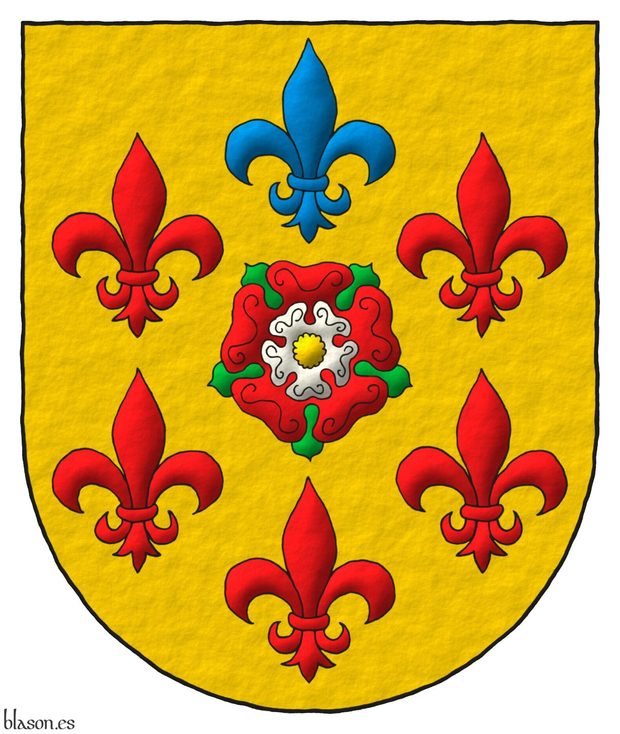
Or, a double rose Gules and Argent, barbed Vert, and seeded Or within six fleurs de lis in orle, five Gules and one in chief Azure.
Coat of arms interpreted with a semi-circular shape; metals or and argent and colors gules, sinople and azur; the delineation is color sable; and a freehand finish.
Credits:
- Rolando Yñigo-Genio is the designer of the coat of arms.
- Antonio Salmerón y Cabañas is the author of the heraldic art.
Blazon keywords: Or, Double rose, Gules, Argent, Barbed, Vert, Seeded, Six, Fleur de lis, Orle, Five, One, Azure and In chief.
Style keywords: Semi-circular, Freehand and Outlined in sable.
Classification: Interpreted, Personal and Coat of arms.
Bearer: Yñigo-Genio, Noelia.


Yñigo-Genio, Rolando
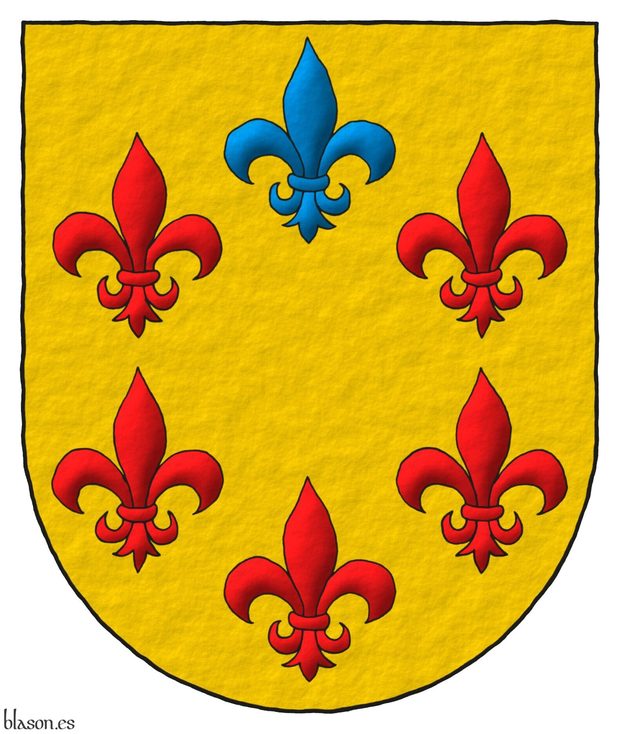
Or, six fleurs de lis in orle, five Gules and one in chief Azure.
I have interpreted this coat of arms with a semi-circular shape; tintures or, azure and gules; outlined with sable; and a freehand finish.
Rolando Yñigo-Genio publish on his website DeviantArt his interpretation of my coat of arms as I publish here in Blason.es I my interpretation of his arms and those of his brothers Noelia Yñigo-Genio and Elias Yñigo-Genio.
Credits: Rolando Yñigo-Genio is the designer of the coat of arms and Antonio Salmerón y Cabañas is the author of the heraldic art.
Blazon keywords: Or, Six, Fleur de lis, Orle, Five, Gules, One, Azure and In chief.
Style keywords: Semi-circular, Freehand and Outlined in sable.
Classification: Interpreted, Personal and Coat of arms.
Bearer: Yñigo-Genio, Rolando.


Zúñiga y Guzmán, Álvaro de

Justice and High Sheriff of Castile, first knight of the realm, warden of the fortress of Burgos, administrator of the mastership of the Order of Alcántara, nobleman of Castile, 1410–1488.
Argent, a bend Sable; overall a chain orlewise Or.
Escudo de plata, una banda de sable; brochante sobre el todo una cadena puesta en orla de oro.
Coat of arms of Álvaro de Zúñiga y Guzmán, which I have interpreted as follows: the shield has a semicircular (round) base; the field and the bend are illuminated in flat tinctures Argent and Sable; the chain is illuminated in Or; and the whole is rendered with a raised-stroke effect.
For the crafting of the chain in this coat of arms, which has a total of 16 links, of which 8 are long and 8 are round, I have followed the two coats of arms of Álvaro de Zúñiga y Guzmán that appear in what was his copy of [Alfonso X of Castile; 1265; page 6 of the later pencil numbering].
Blazon keywords: Without divisions, Argent, Sable, Or, One, Bend, Chain, Orlewise and Overall.
Style keywords: Freehand and Illuminated.
Classification: Interpreted, Personal and Coat of arms.
Bearer: Zúñiga y Guzmán, Álvaro de.
-
Language
-
Categories of heraldry
-
Divisions of the field
- Without divisions
- Party per pale
- Party per fess
- Party per bend
- Party per bend sinister
- Tierce
- Tierce sinister
- Tierced per pale
- Tierced per fess
- Tierced per bend
- Tierced pallwise inverted
- Quarterly
- Quarterly per saltire
- Gyronny
- Party per fess, the chief per pale
- Party per pale, the sinister per fess
- Party per fess, the base per pale
- Party per pale, the dexter per fess
- Chapé
- Chaussé
- Embrassé
- Contre-embrassé
- Party per chevron
- Enté
- Enté en point
- Flanched
-
Metals
-
Colours
-
Furs
-
Other tinctures
-
Ordinaries and sub-ordinaries
-
Diminutives of the ordinaries
-
Geometric charges
-
Composite ordinaries
-
Inanimate charges from Nature
Atom, Crescent, Diamond, Emerald, Estoile, Increscent, Lightning flash, Moon, Mount, Mullet, Mullet of four points, Orbital, Plough of Ursa Major, Rainbow, Ray of the sun, River, Sea, Snowflake, Sun, Sun in splendour, Sun of May, Trimount, Water and Wave.
-
Vegetal charges from Nature
Acorn, Apple, Apple tree, Ash, Bluebonnet, Camellia, Chrysanthemum, Cinquefoil, Cornflower, Dogwood flower, Double rose, Elm, Fleur de lis, Flower, Gourd, Holm oak, Hop cone, Kapok tree, Laurel, Lily, Linden, Lotus flower, Madonna lily, Mexican cedar tree, Oak, Olive tree, Palm tree, Plantain plant, Pomegranate, Poplar leaf, Rose, Shamrock, Sunflower, Thistle, Tree, Tulip, Vine and Wheat.
-
Animal charges from Nature
Badger, Bald eagle, Barbel, Barn owl, Bear, Beaver, Beetle, Bighorn sheep, Blackbird, Boar, Brach hound, Bull, Doe, Dog, Dolphin, Dove, Eagle, Elephant, Falcon, Female figure, Fish, Flame, Fly, Fox, Frog, Goat, Goldfinch, Goose, Heron, Horse, Hummingbird, Jaguar, Lark, Leopard, Lion, Lion passant, Lion rampant guardant, Lioness, Lynx, Male figure, Martlet, Merino ram, Owl, Panther, Parrot, Peacock, Pelican, Pelican in her piety, Puffin, Quetzal, Raven, Roe deer, Rooster, Savage, Seagull, Serpent, She-wolf, Stag, Starling, Talbot, Tyger, Vulture, Warren hound and Wolf.
-
Parts of natural charges
Arm, Beak, Branch, Caboshed, Chest, Claw, Covert, Dorsal fin, Eagle claw, Ermine spot, Escallop, Feather, Foot (palmiped), Foreleg, Forepaw, Hand, Head, Heart, Hoof, Leaf, Neck, Ostrich feather, Palm frond, Paw, Roe deers' attires, Shoulder, Sprig, Stags' attires, Stem, Swallow-tail, Tail, Tail addorsed, Tail fin, Talon, Tooth, Trunk, Trunk (elephant), Two hands clasped, Two wings in vol, Udder, Wheat spike, Wing and Wrist.
-
Artificial charges
Ace of spades, Anchor, Anvil, Arch, Arm vambraced, Armillary sphere, Arrow, Axe, Bell, Bell tower, Beret, Bonfire, Book, Bookmark, Bow, Branding iron, Bridge, Broken, Buckle, Cannon, Cannon dismounted, Cannon port, Canopy roof, Carbuncle, Castle, Celtic Trinity knot, Chain, Chess rooks, Church, Clarion, Clay pot, Closed book, Club, Column, Comb, Compass rose, Conductor's baton, Cord, Covered cup, Crozier, Crucible, Cuffed, Cup, Cyclamor, Dagger, Double vajra, Drum, Ecclesiastical cap, Fanon, Federschwert, Fleam, Four crescents joined millsailwise, Galician granary, Garb, Gauntlet, Geometric solid, Grenade, Halberd, Hammer, Harp, Host, Hourglass, Key, Key ward, Knight, Knot, Lantern, Letter, Line, Loincloth, Menorah, Millrind, Millstone, Millwheel, Monstrance, Mortar, Mullet of six points pierced, Nail, Non-classic artifact, Norman ship, Number, Oar, Oil lamp, Open book, Page, Pair of scales, Parchment, Pestle, Piano, Pilgrim's staff, Plough share, Polish winged hussar, Port, Portcullis, Potent, Quill, Ribbon, Rosette of acanthus leaves, Sabre, Sackbut, Sail, Scroll, Scythe, Sheaf of tobacco, Ship, Skirt, Spear, Spear's head, Stairway, Star of David, Step, Sword, Symbol, Tetrahedron, Torch, Tower, Trident, Trumpet, Turret, Two-handed sword, Wagon-wheel, Water-bouget, Wheel, Winnowing fan and With a turret.
-
Immaterial charges
Angel, Archangel, Basilisk, Dragon, Dragon's head, Garuda, Golden fleece, Griffin, Heart enflamed, Justice, Mermaid, Our Lady of Mercy, Ouroboros, Paschal lamb, Pegasus, Phoenix, Sacred Heart of Jesus, Saint George, Sea-griffin, Trinity, Triton, Unicorn, Winged hand and Wyvern.
-
External elements
-
Heraldic creations
-
References
-
Formats
-
Keywords on this page
Between, Proper, Pointed, Armed, Azure, Boa, Bordure, Charged, Crest, Ogee, Crown, Created, Cross, Cross couped, Quarterly, Outlined in sable, Two, In chief, In base, Coat of arms, Schema, Mullet, Fess, Fleur de lis, Personal, Gules, Illuminated, Interpreted, Chief, Langued, Motto, Lion, Lineage, Semi-circular, Ordered, Or, Party per pale, Argent, Without divisions, Civic, Rampant, Religious, Sable, Six, Vert, Plain tincture, Freehand, Three and One.








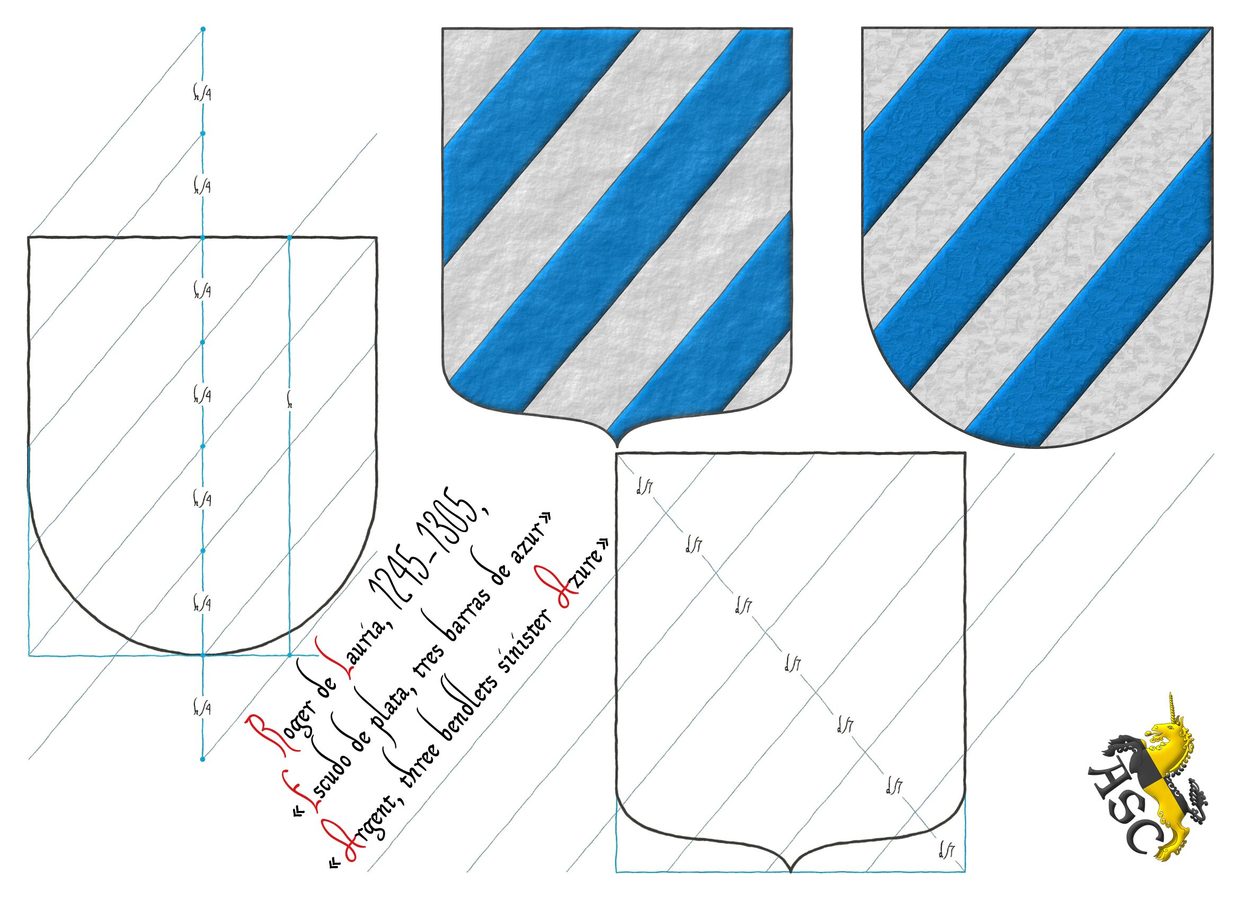



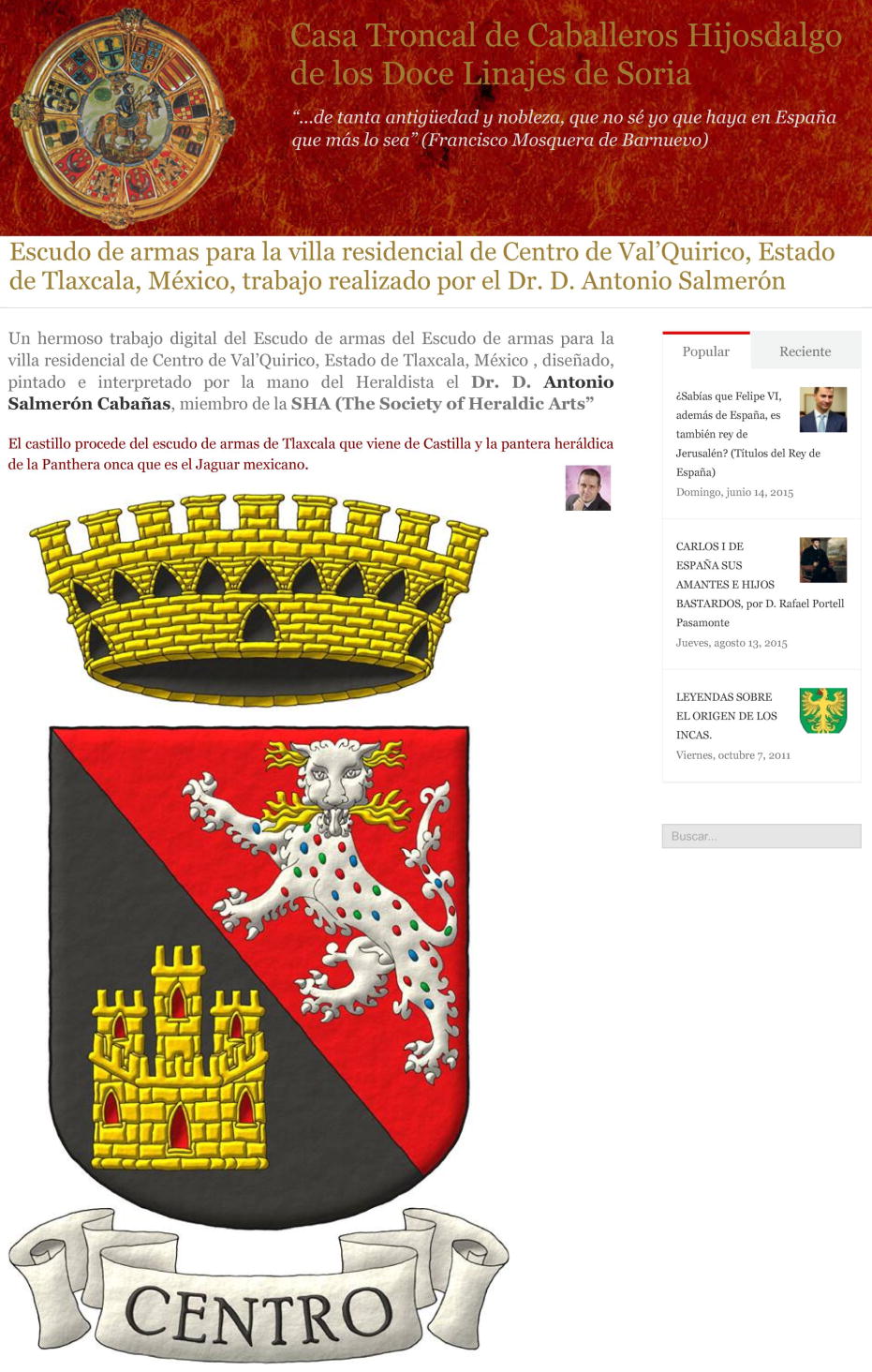


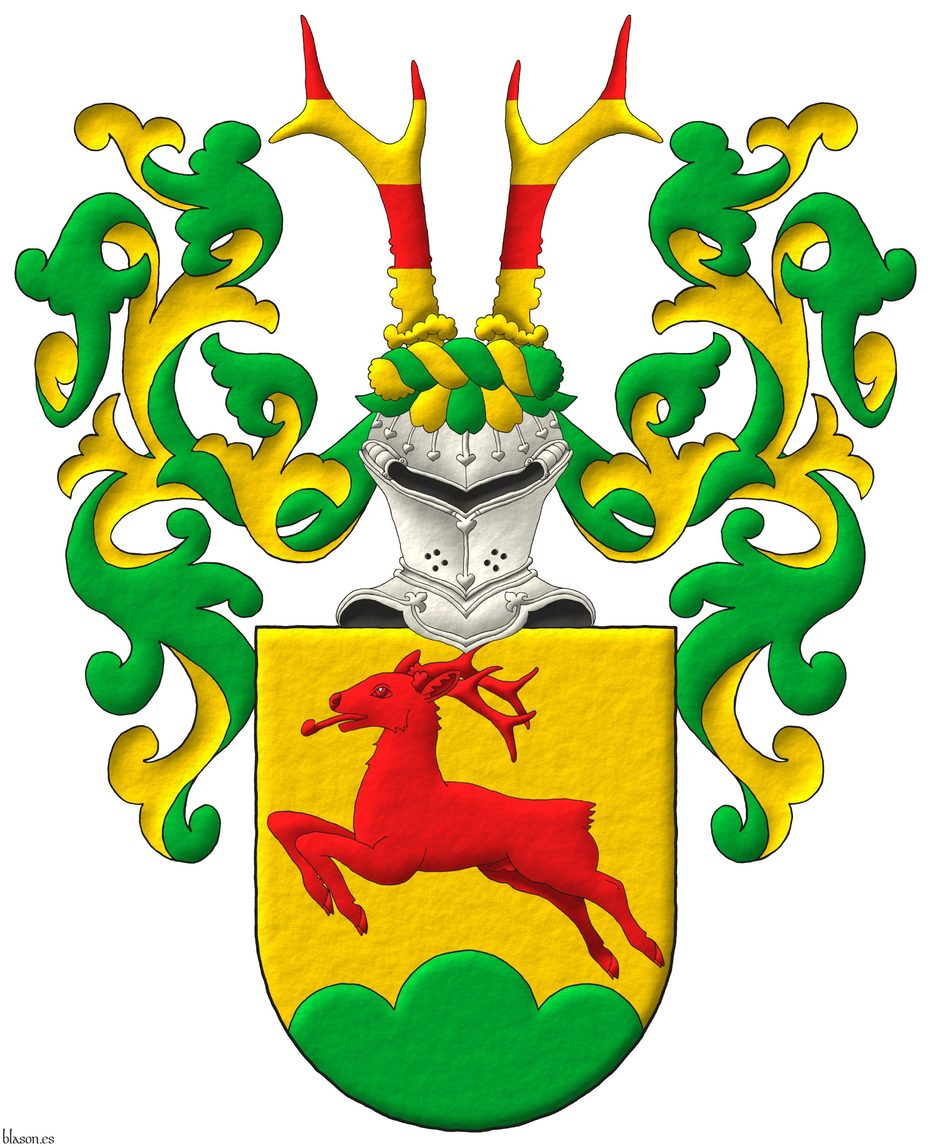








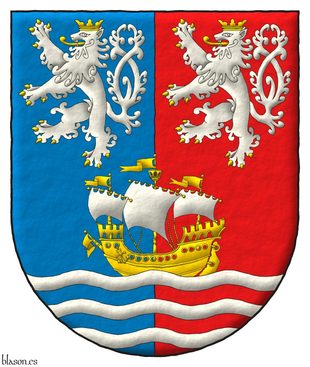












![Leonor Plantagenet and Alfonso VIII [ Gules, a castle triple towered Or, port and windows Azure, masoned Sable ] accolé with [ Gules, three lions, passant, guardant, in pale Or, armed and langued Azure ].](../escudo_armas/LeonorP.23.Matrimonio.jpg)








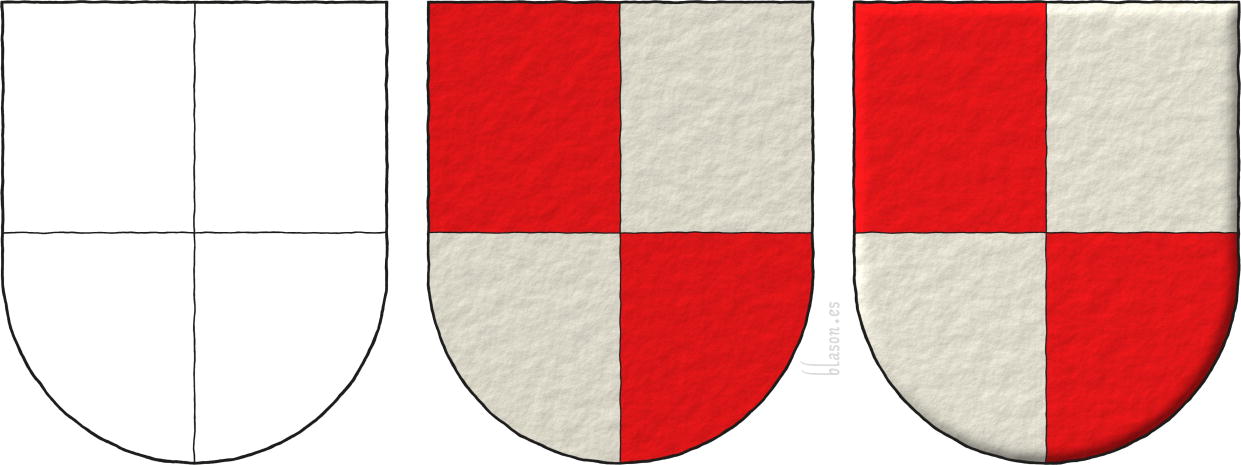
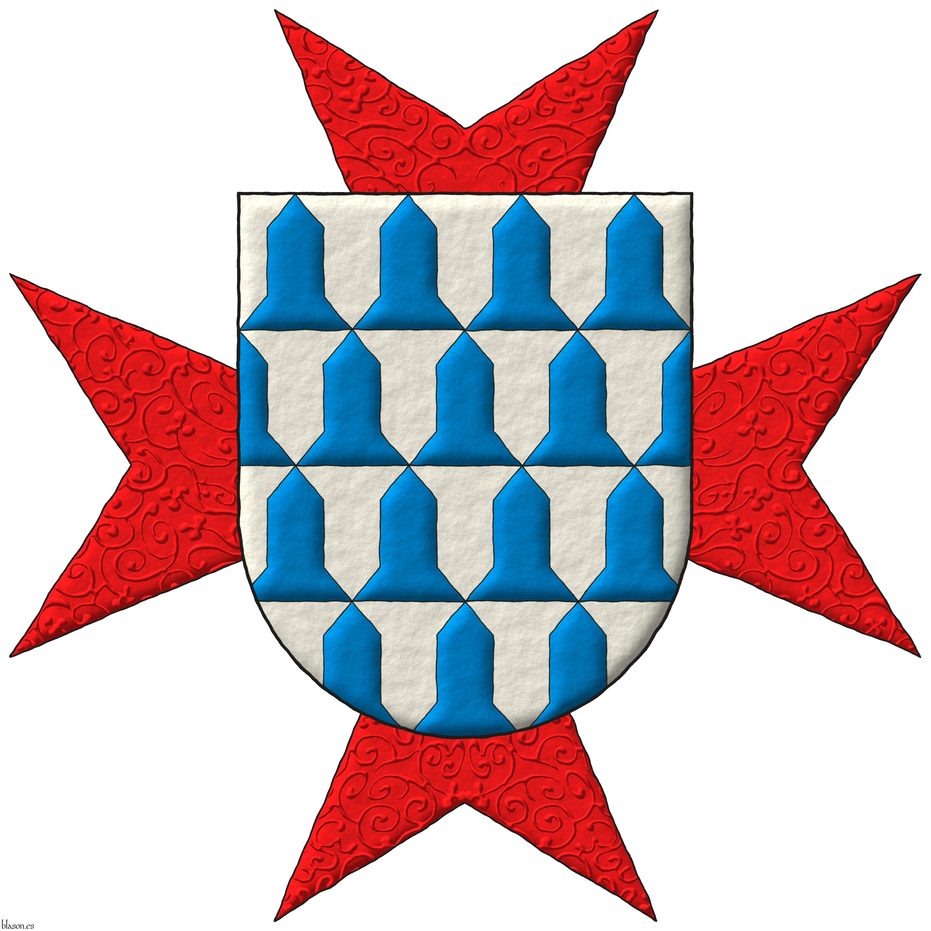


![Tierced per pale: 1 Or, upon a fess Azure a lion passant Gules holding a sword point upwards Argent [for Spiteri]; 2 Azure, upon a base Vert a tree eradicated proper, supported at sinister by a man proper wearing a loincloth Argent and holding in his sinister a spear point upwards Or and in chief three mullets of six points in fess Or [for Debono], 3 Gules, two hands clasped throughout proper, vested Argent, holding a dagger point upwards Argent, hilted Or, in chief three mullets of six points in fess Or and in base a sprig of olive fesswise proper [for Zammit]. Crest: Upon a helm, befitting her degree as President of Malta, with a wreath Or and Gules, an escutcheon Bleu celeste, issuant from a base wavy Argent, charged with three bars wavy Azure, three arches interlaced in fess Or. Mantling: Gules doubled Argent. Supporters: Two lions rampant Or, langued Gules, terraced by a mound Vert. Motto: «Servire Cum Modestia». The shield is surrounded by the Xirka Gieh ir-Repubblika, and the Grand Collar of the Malta's National Order of Merit, as Head of both. Structured and parallel blazon](../escudo_armas/G0134.26.FullAchievement.FreeHand.jpg)










